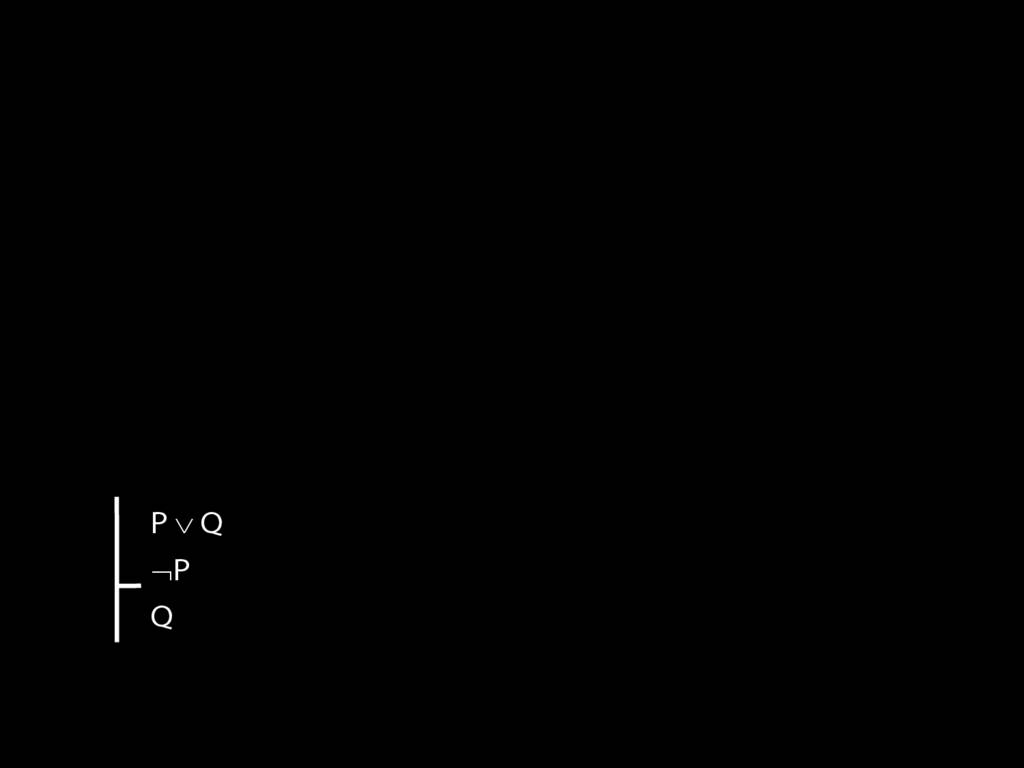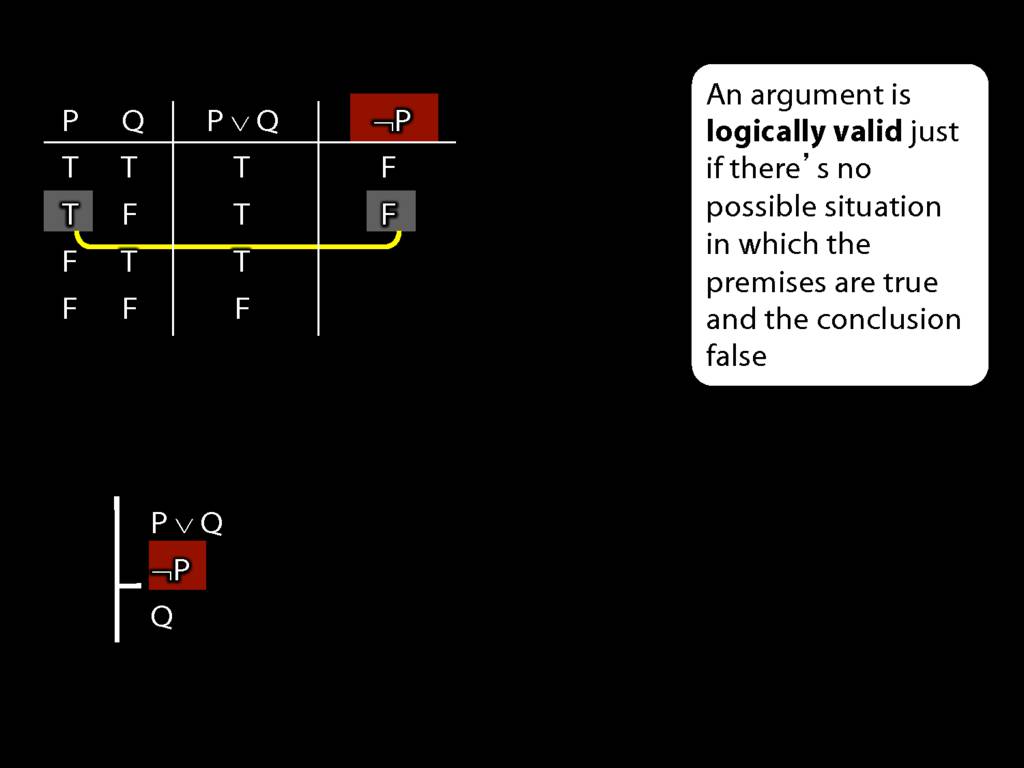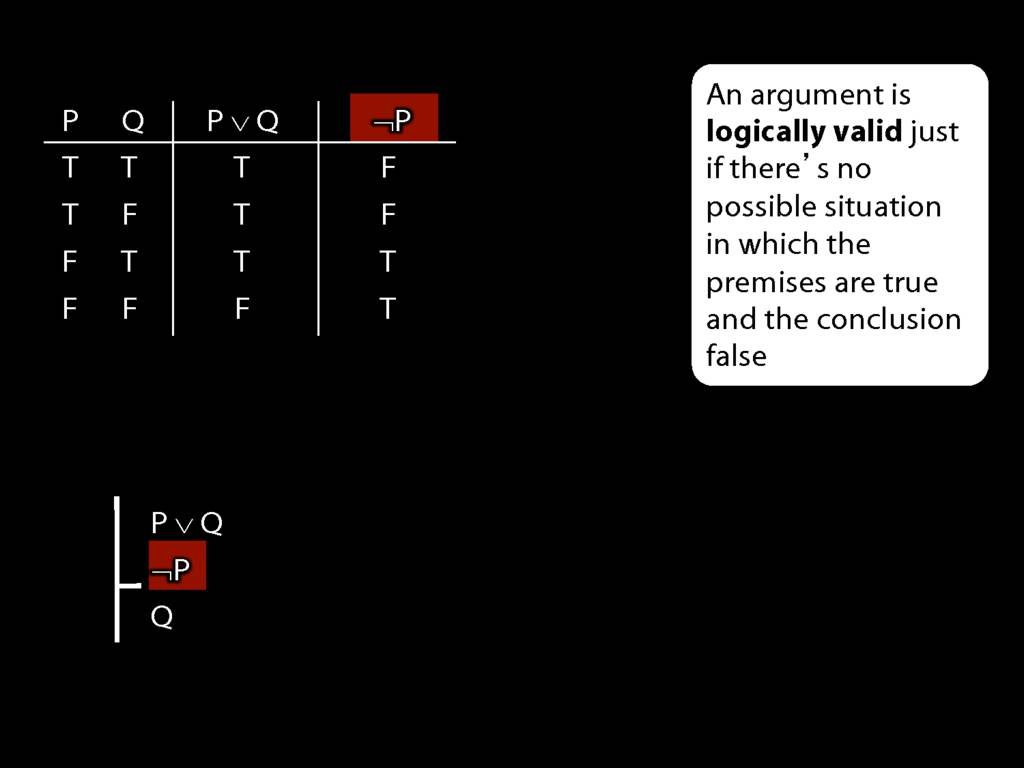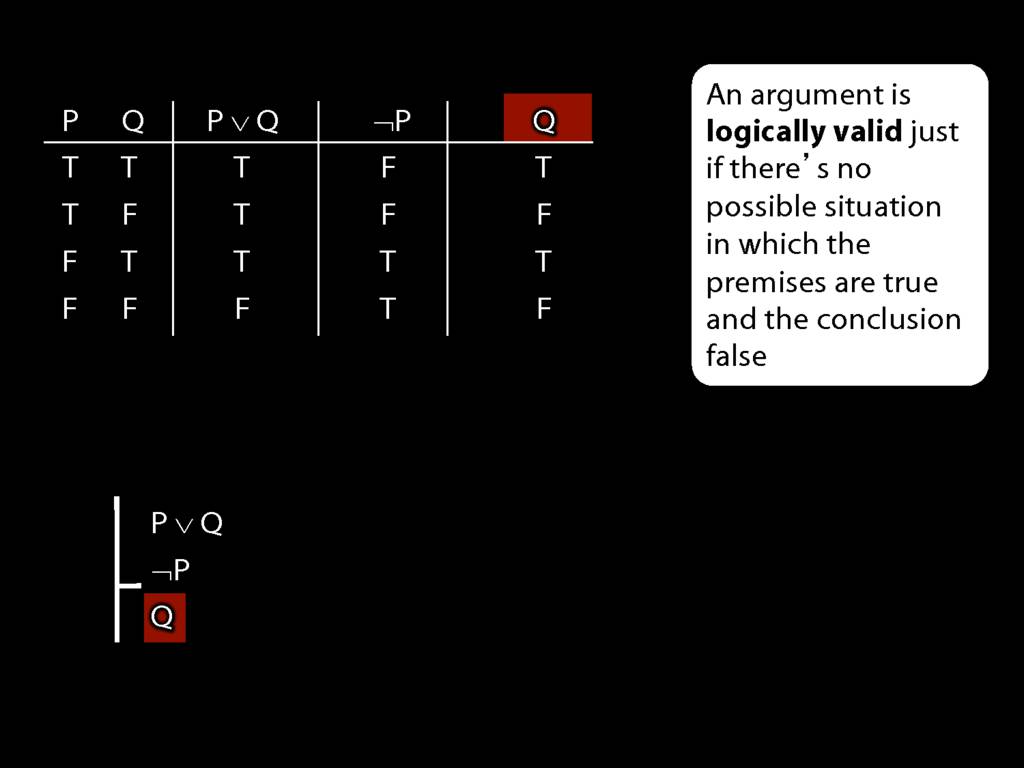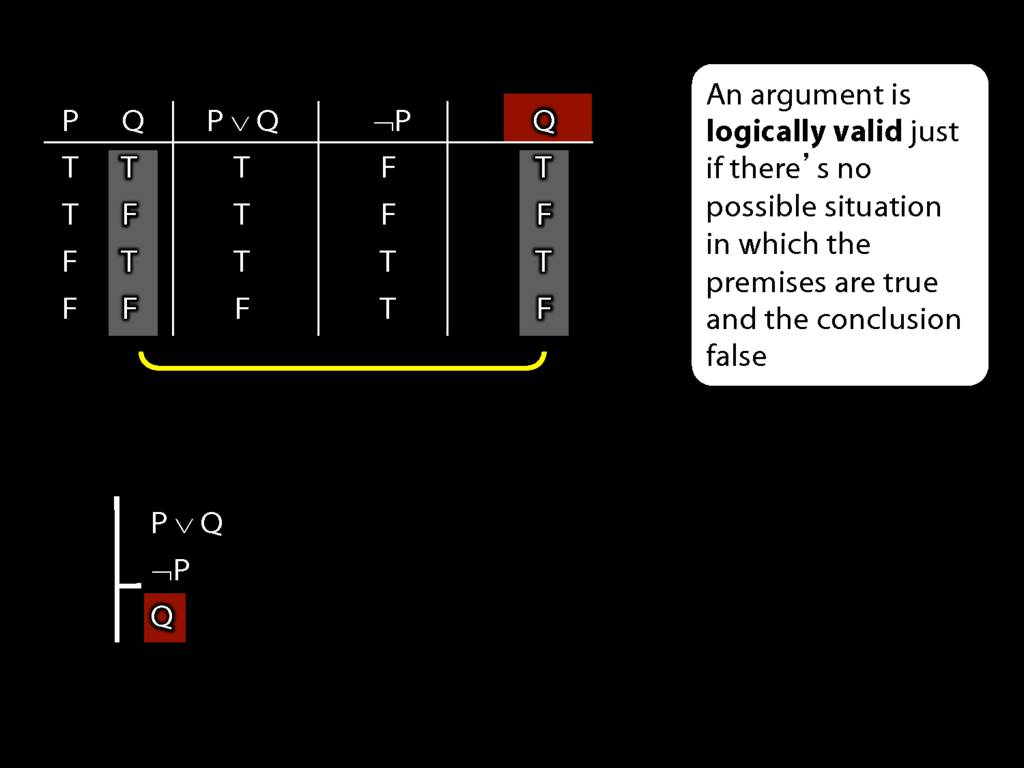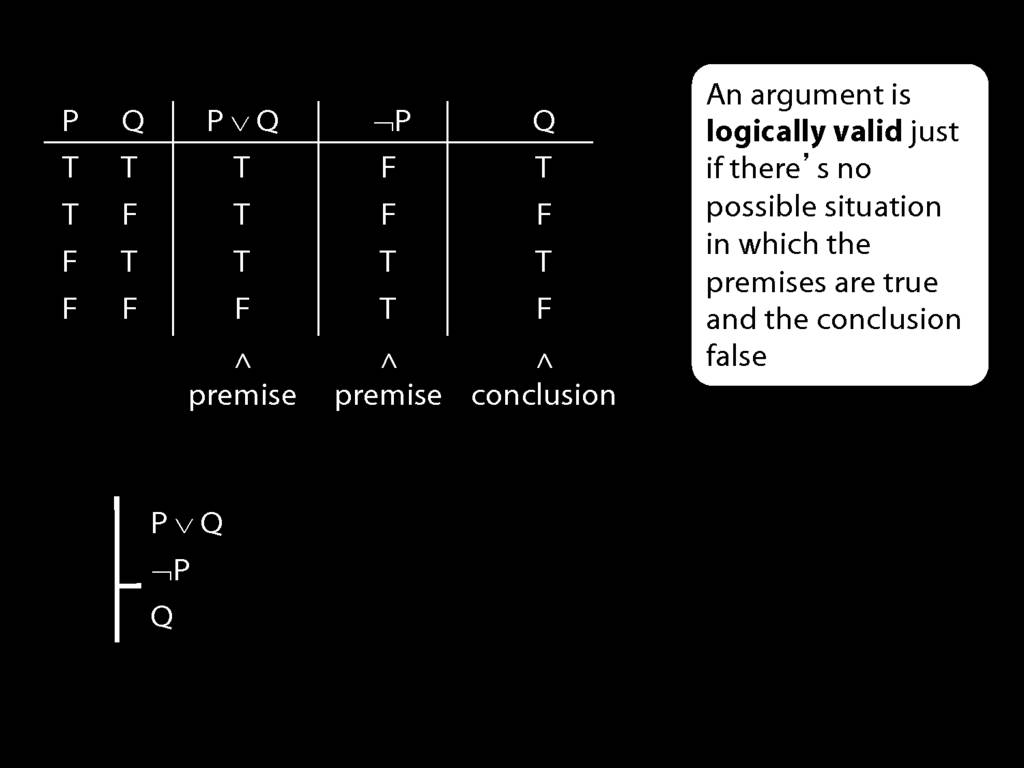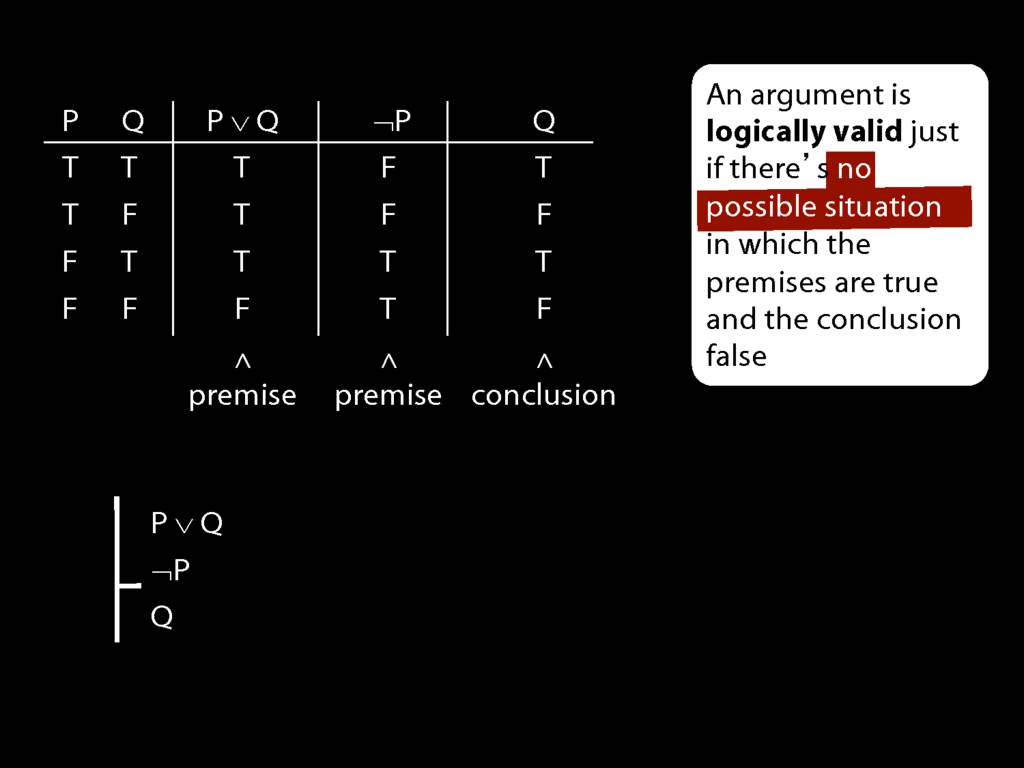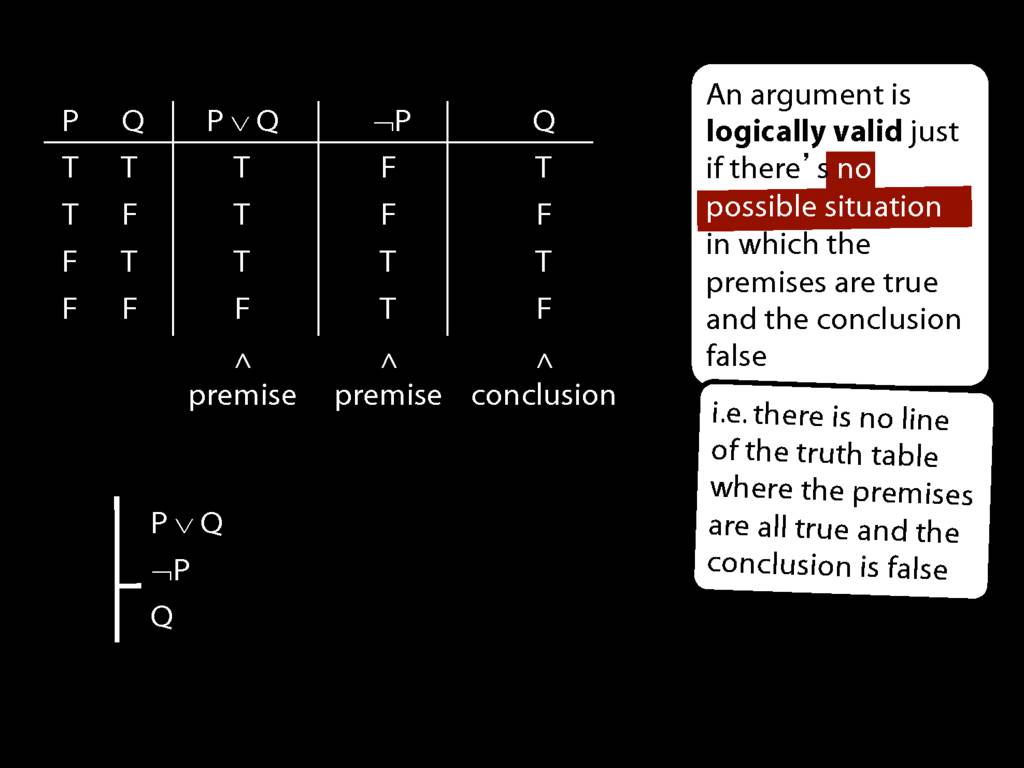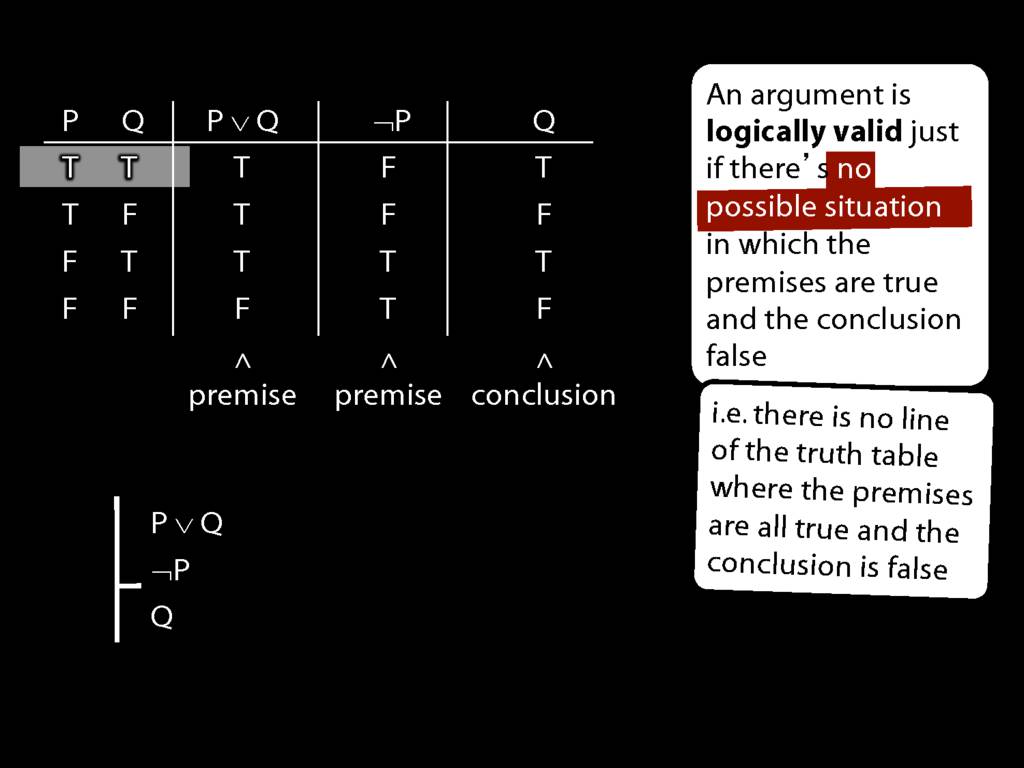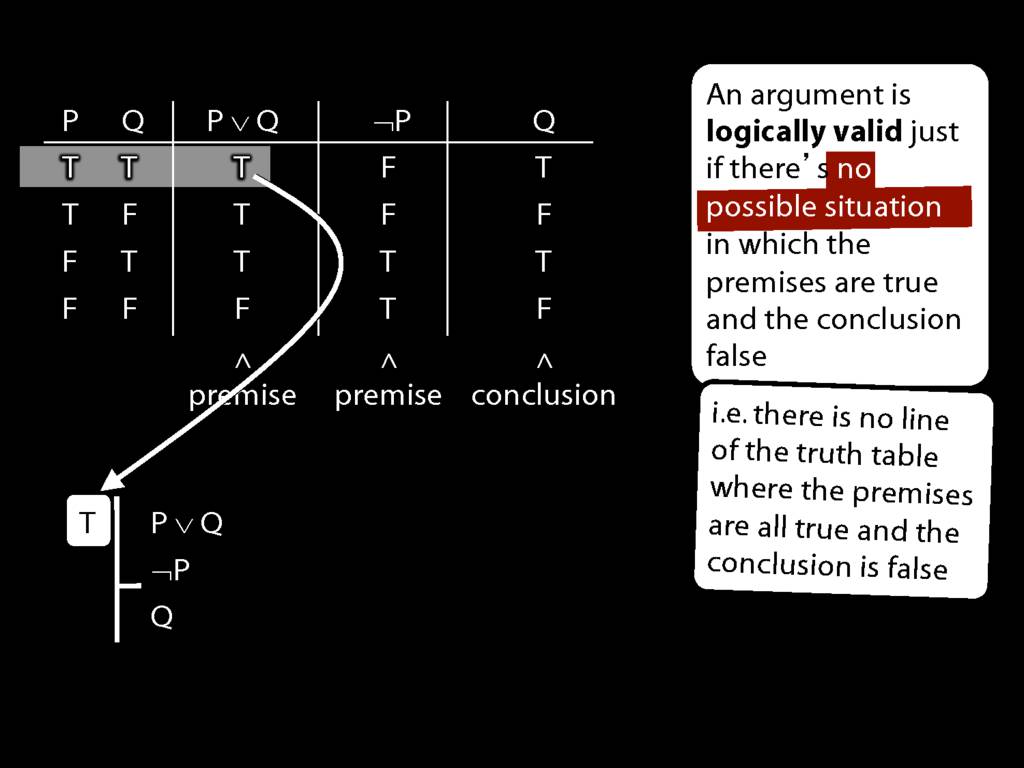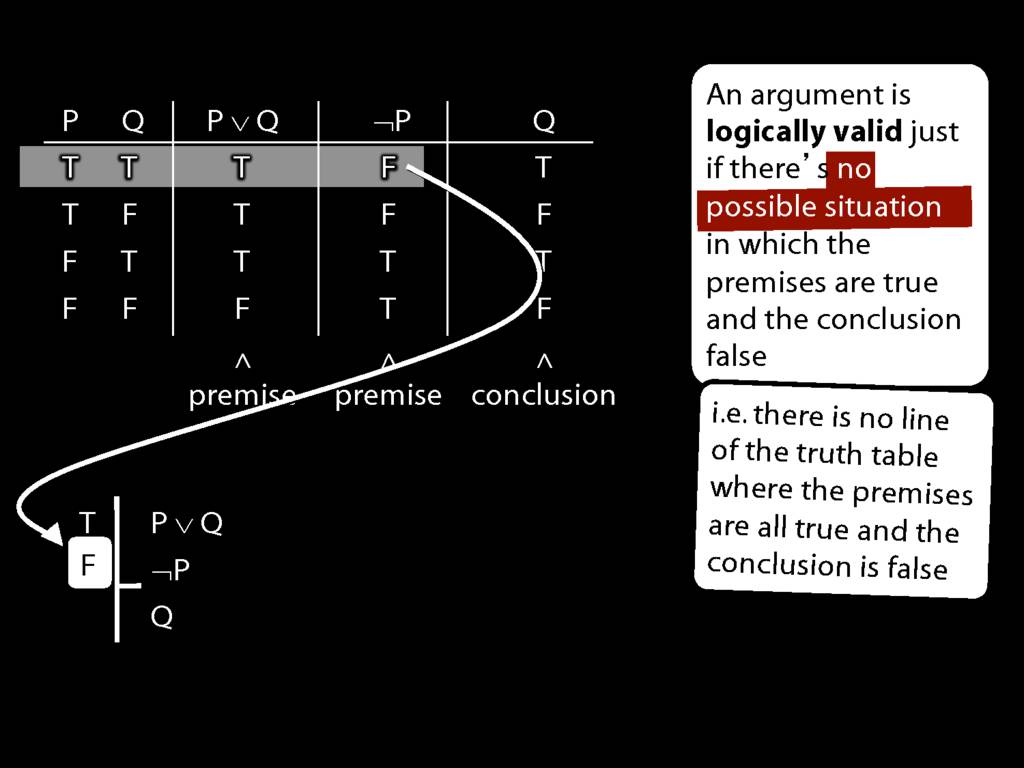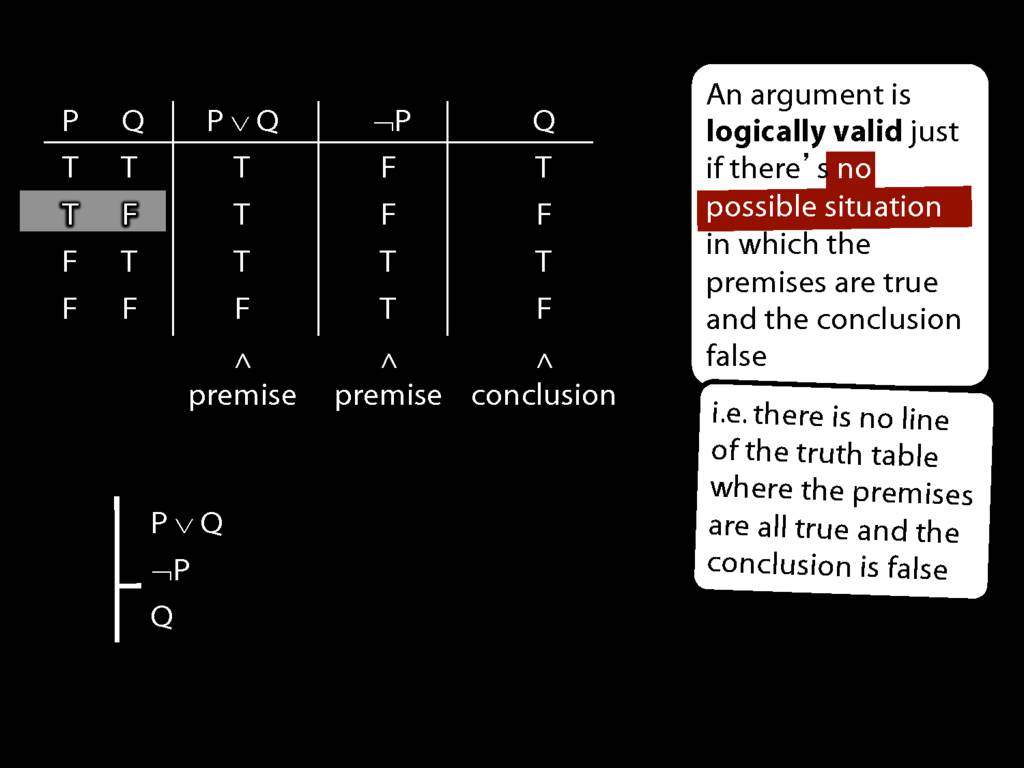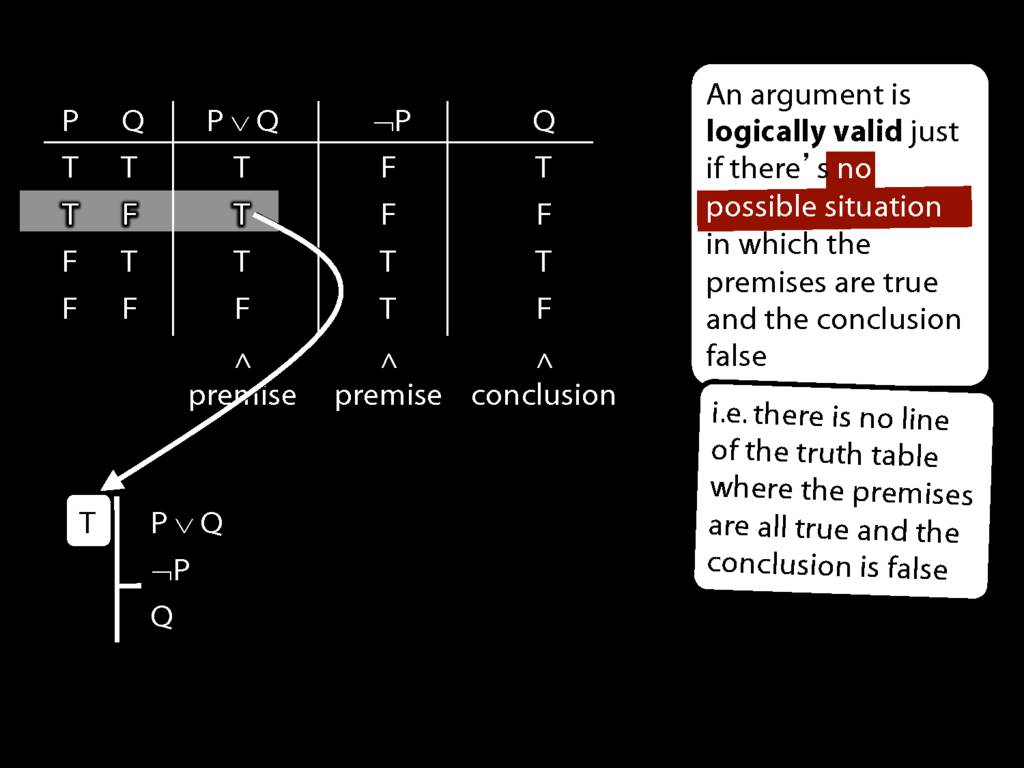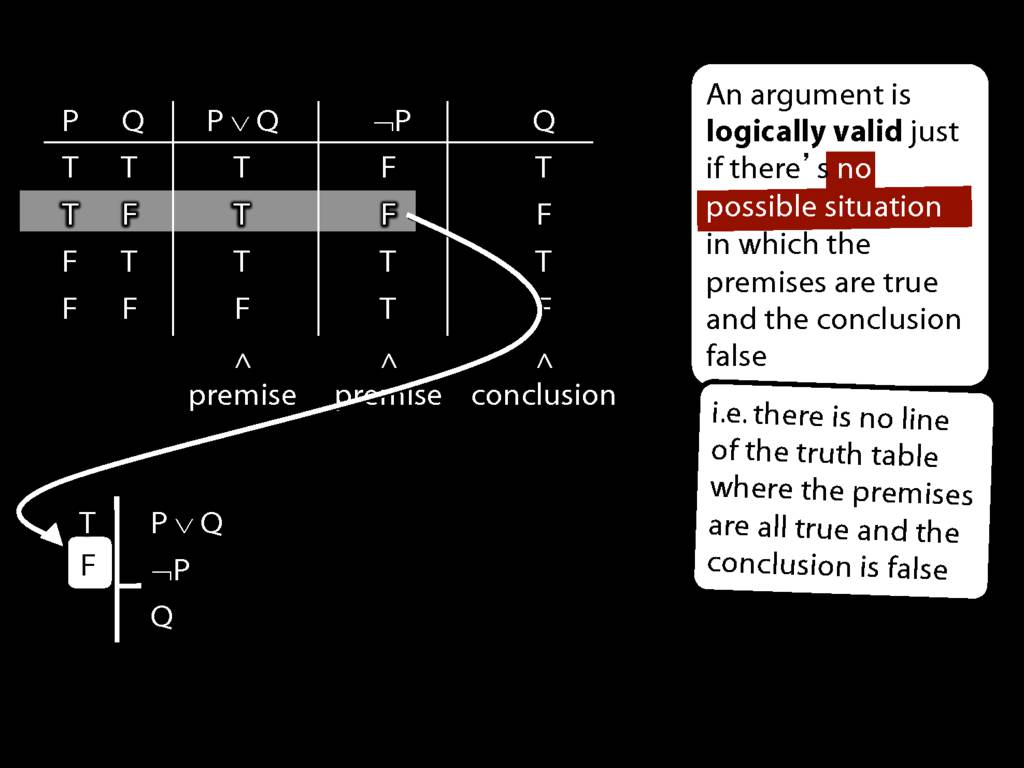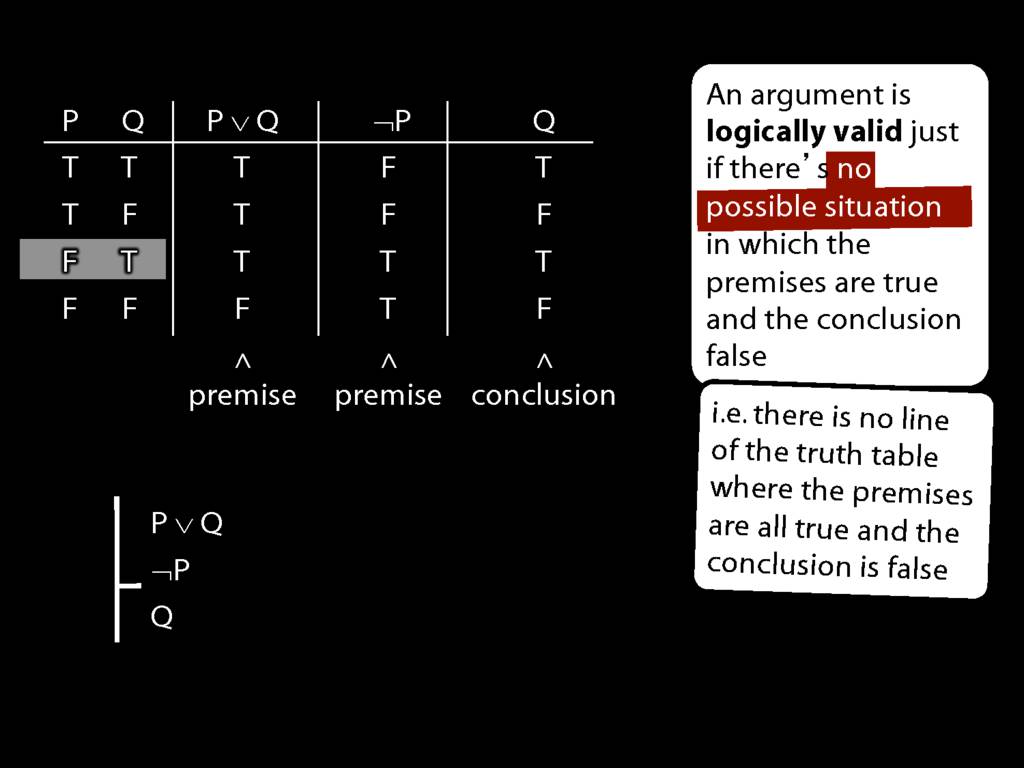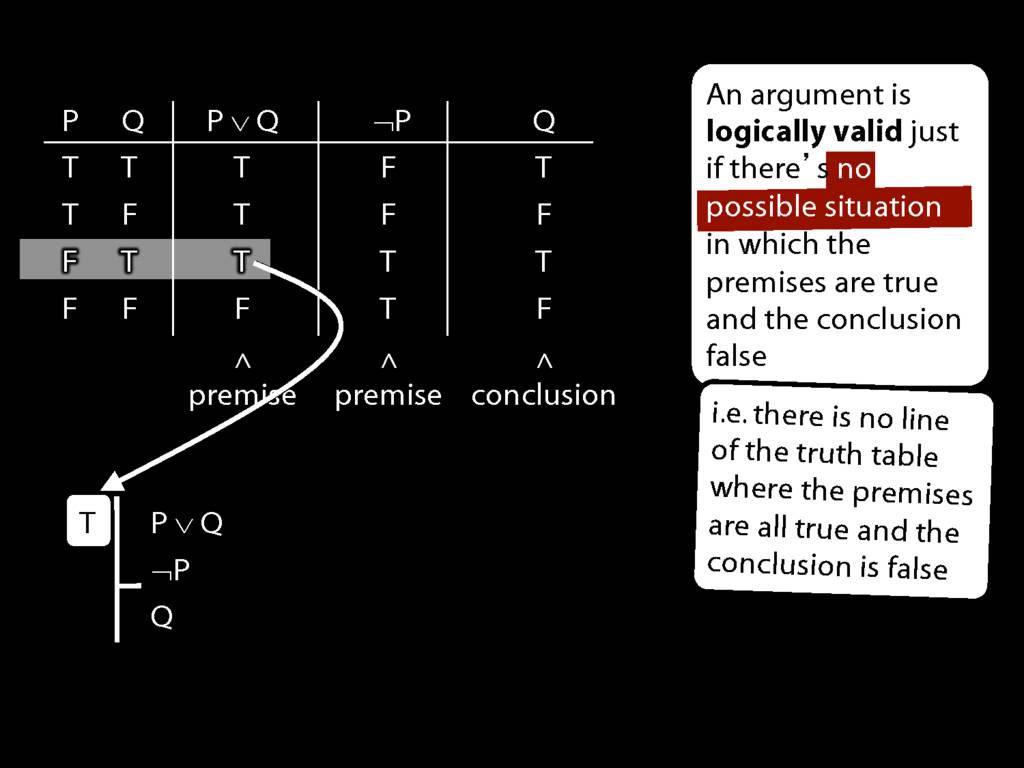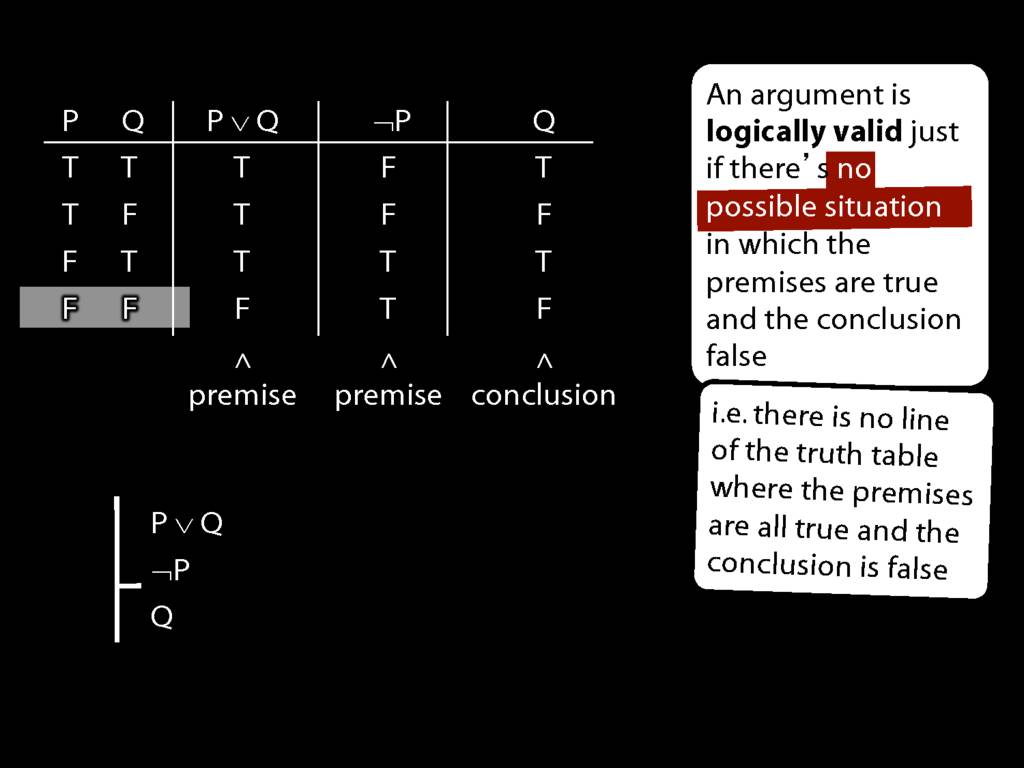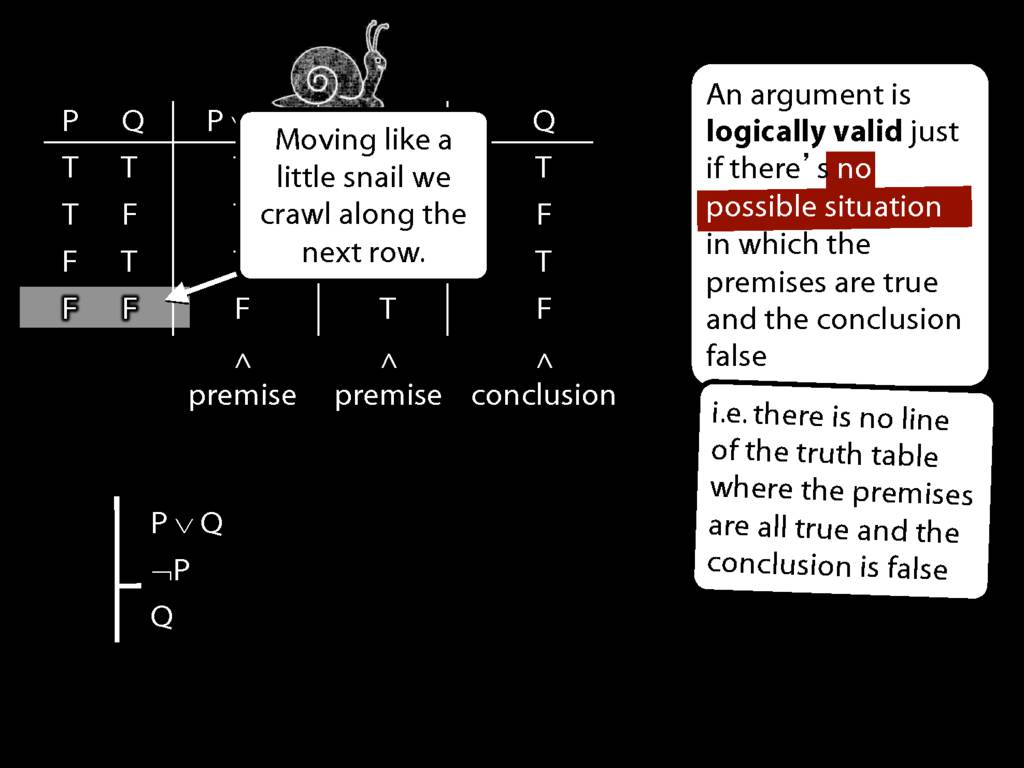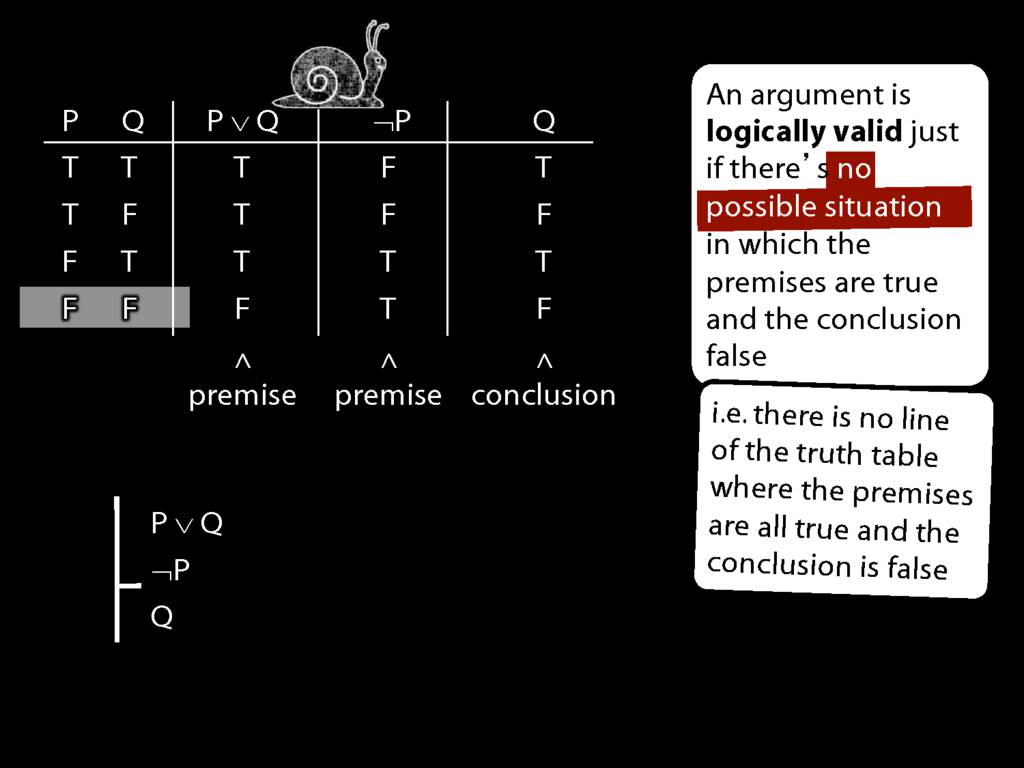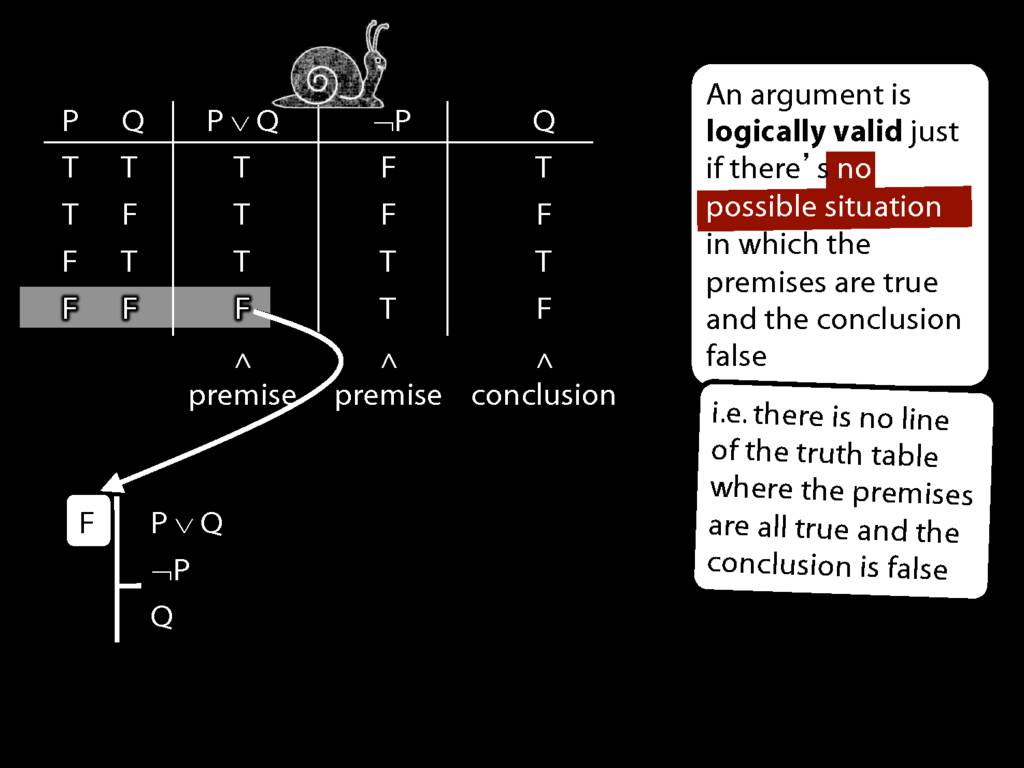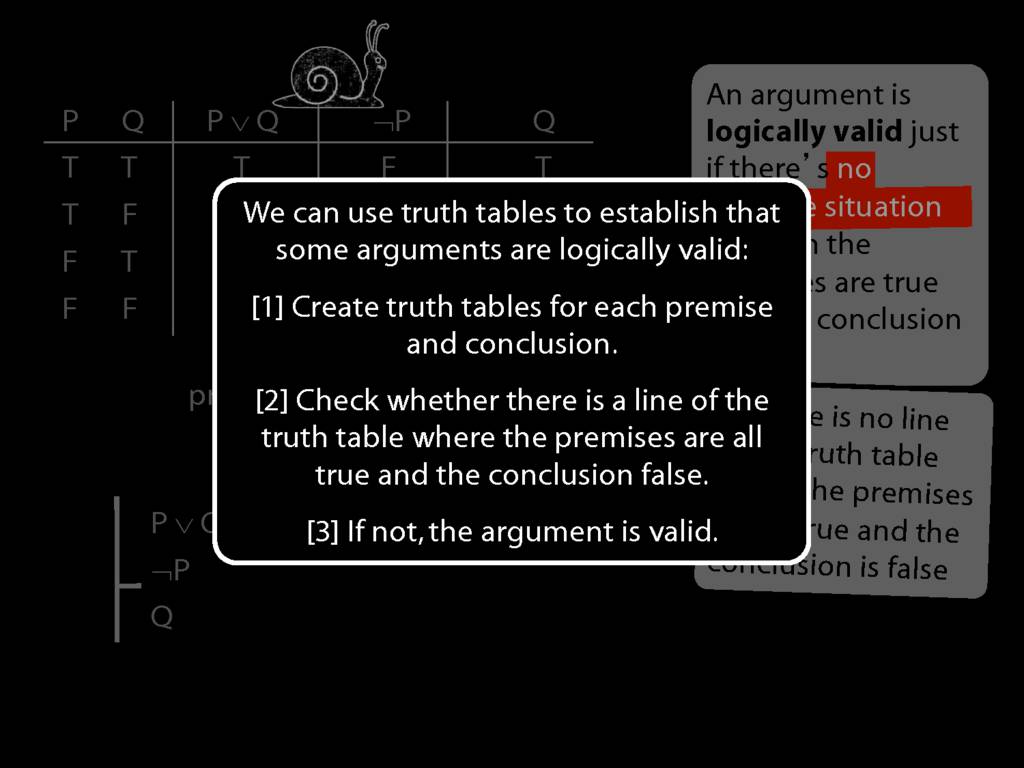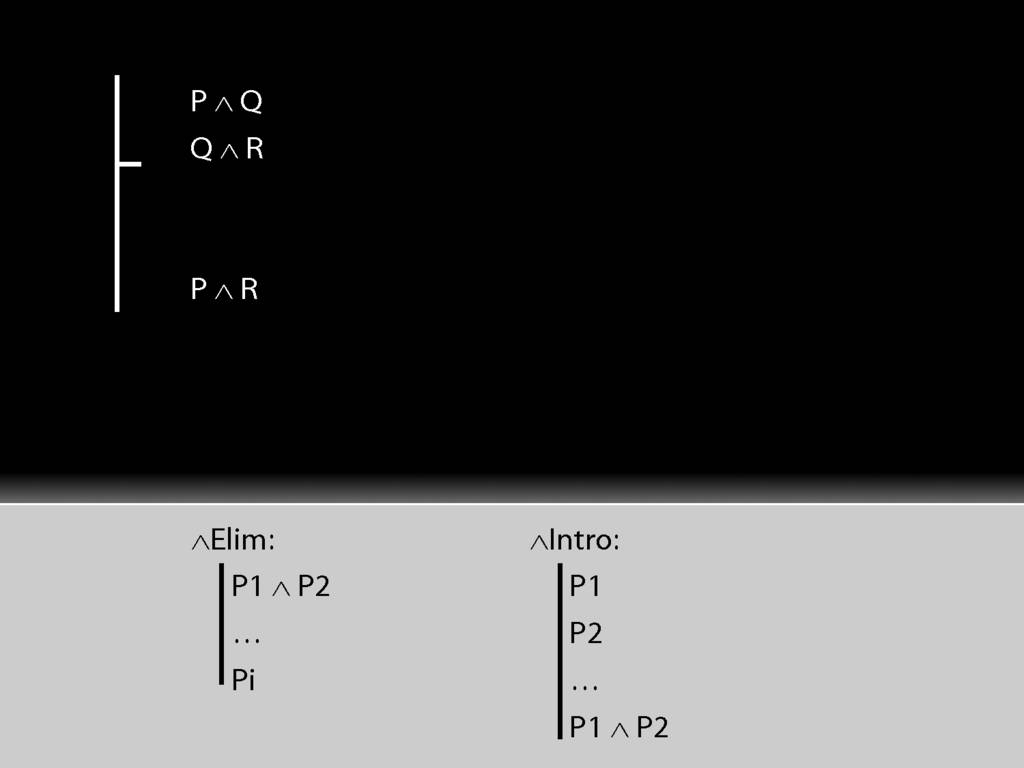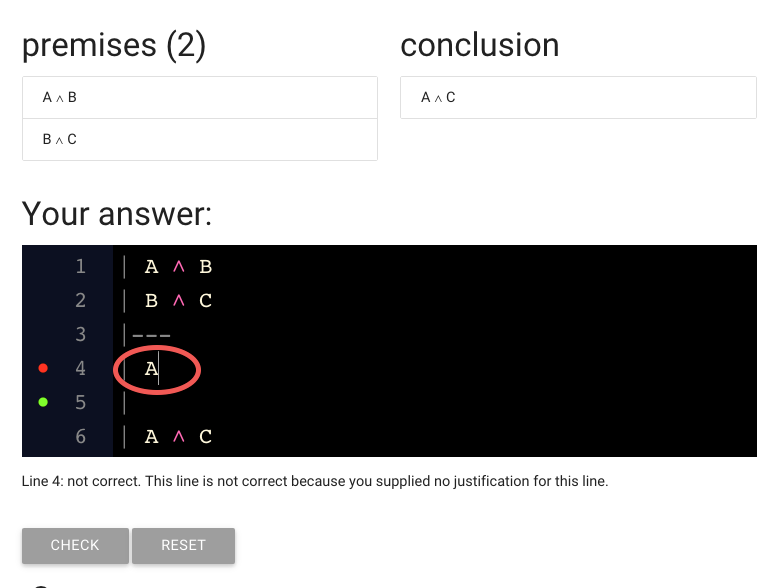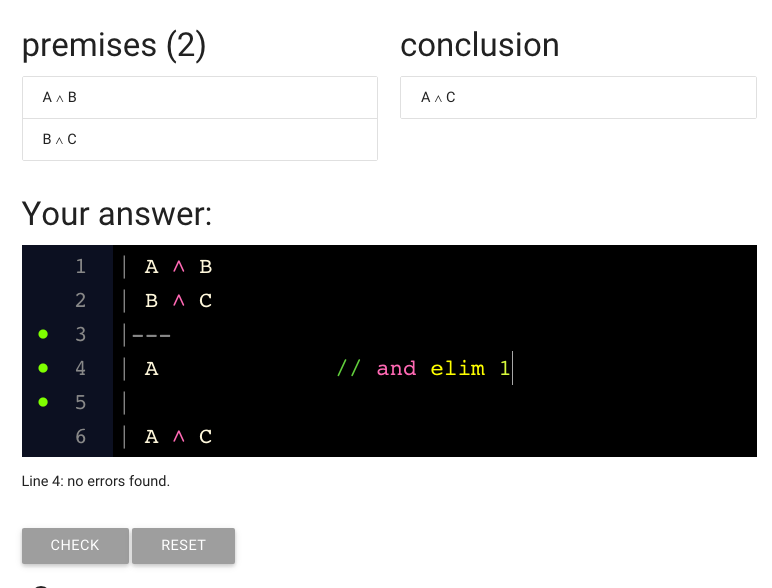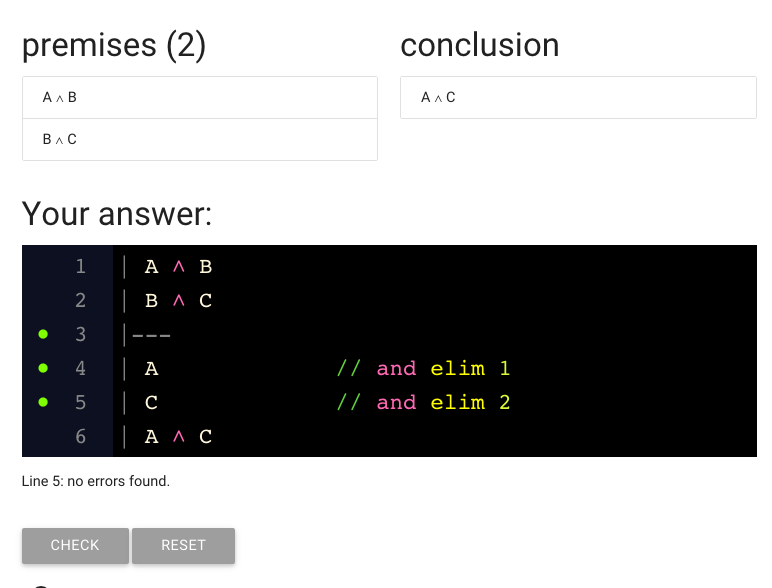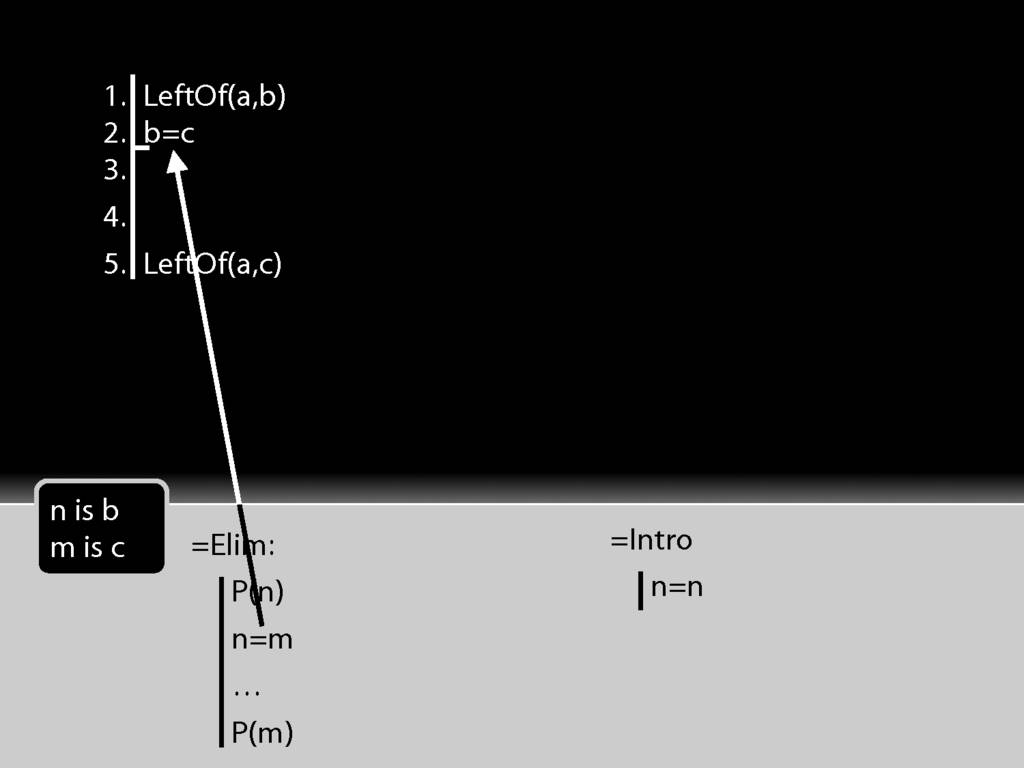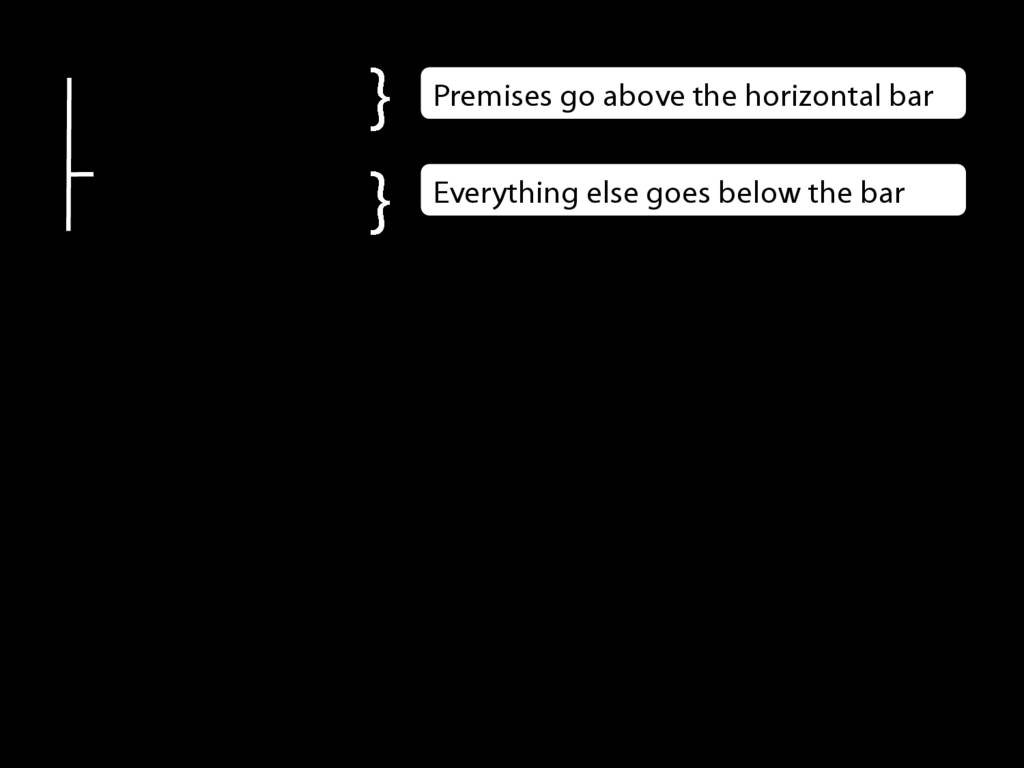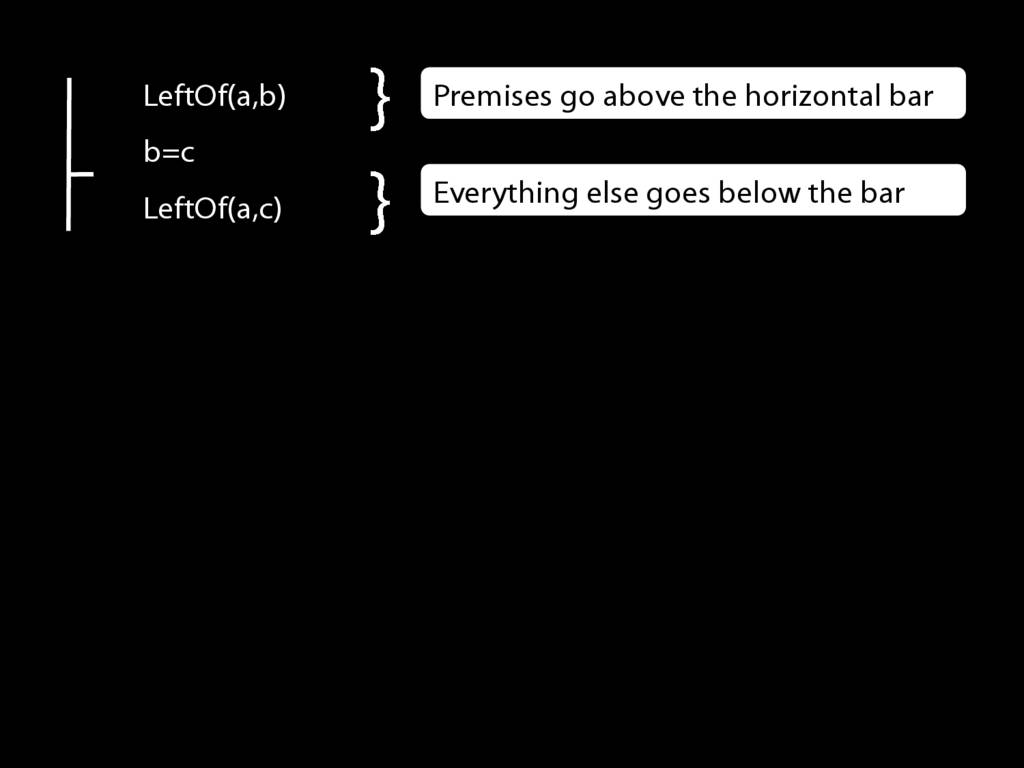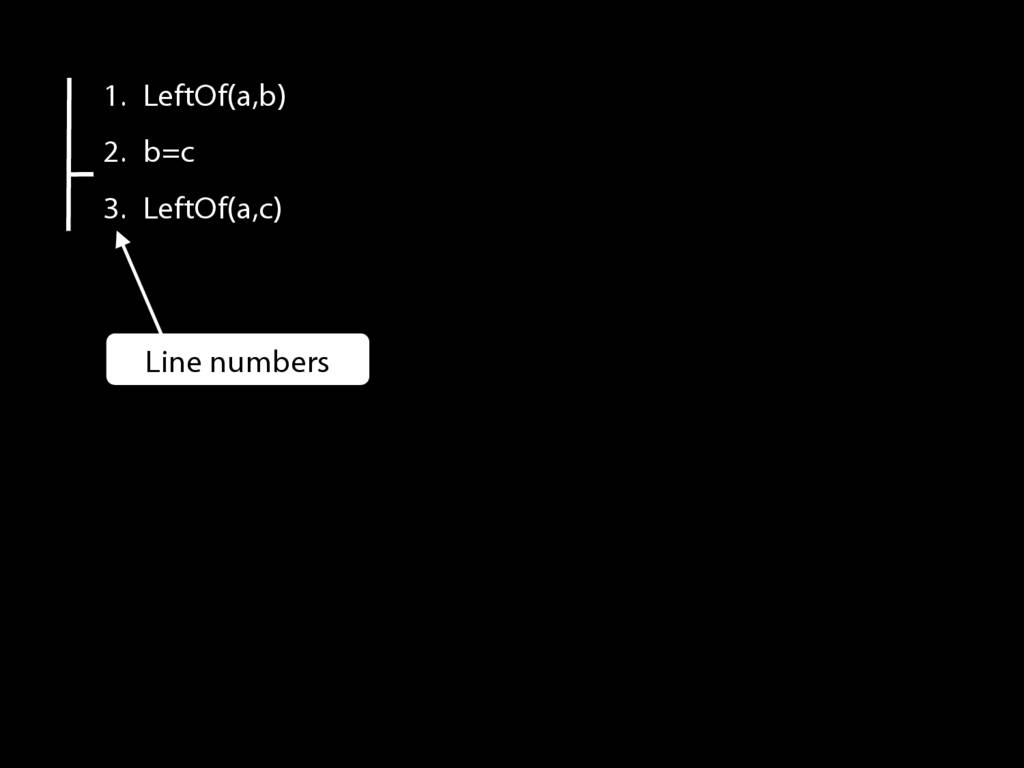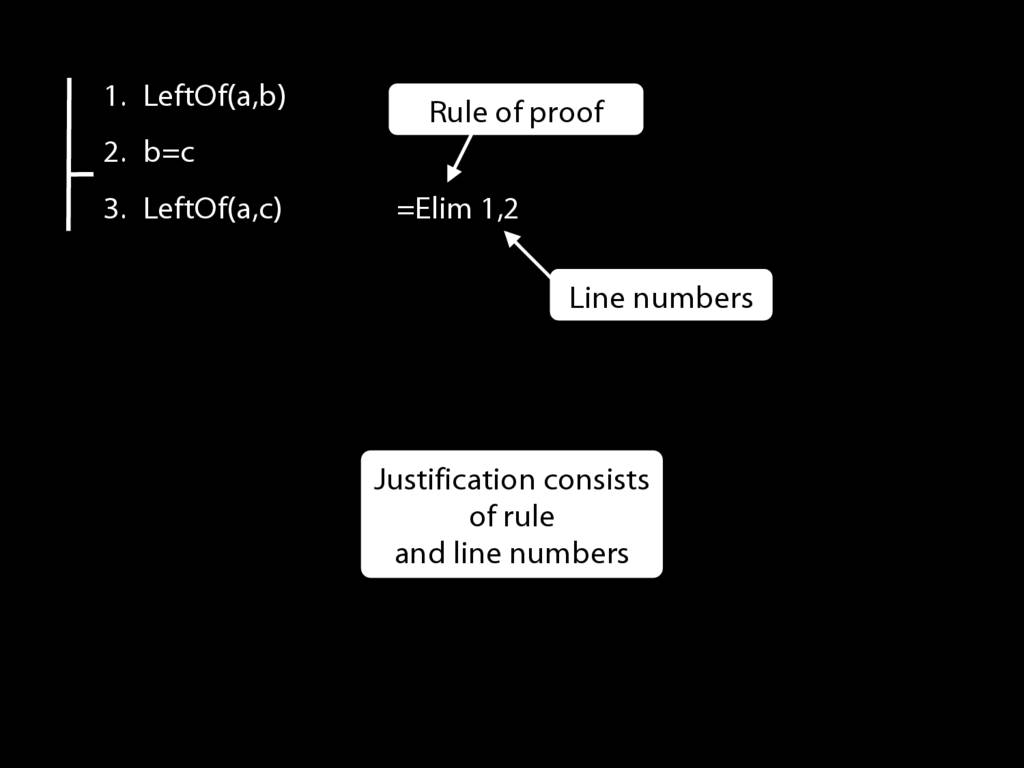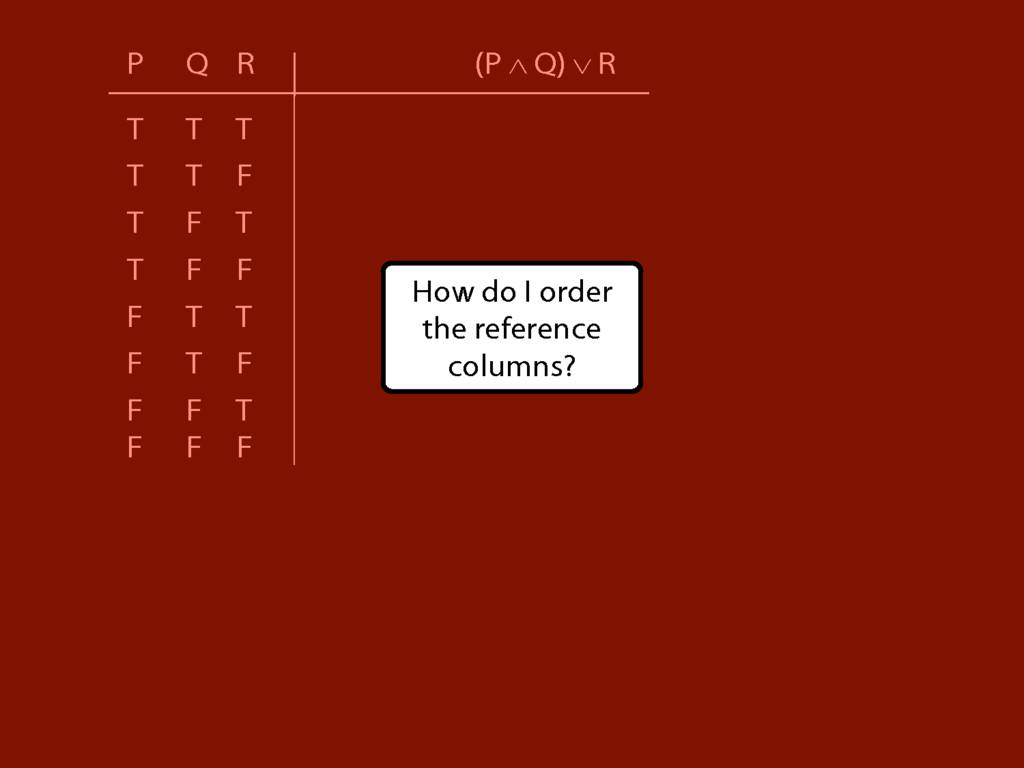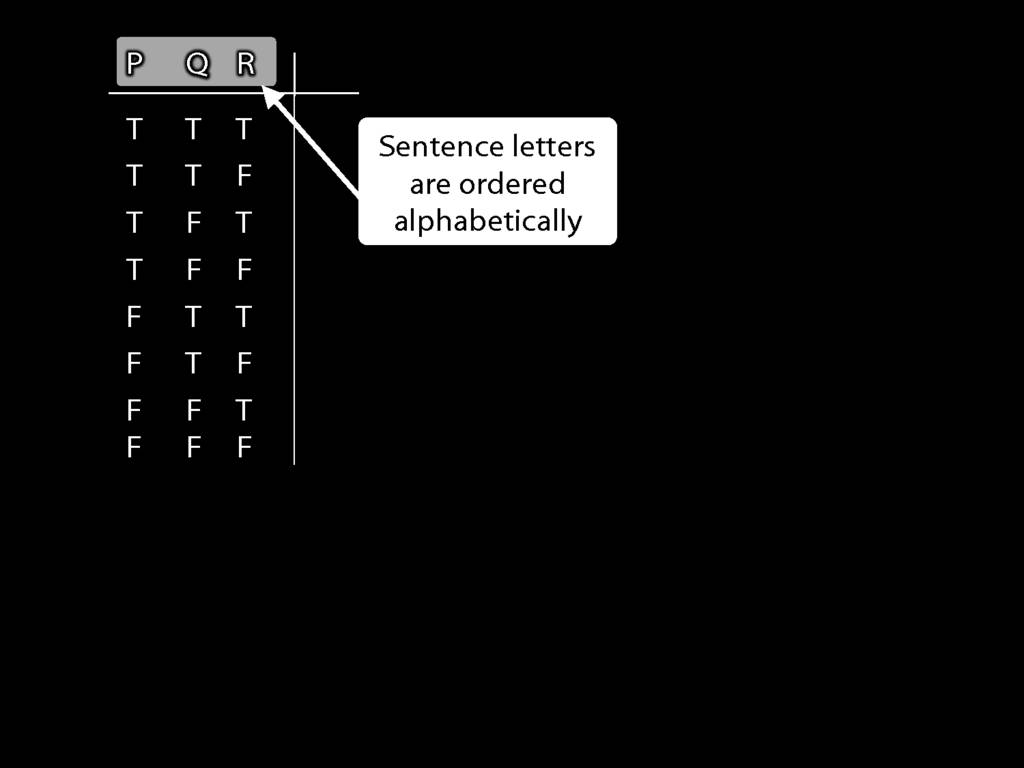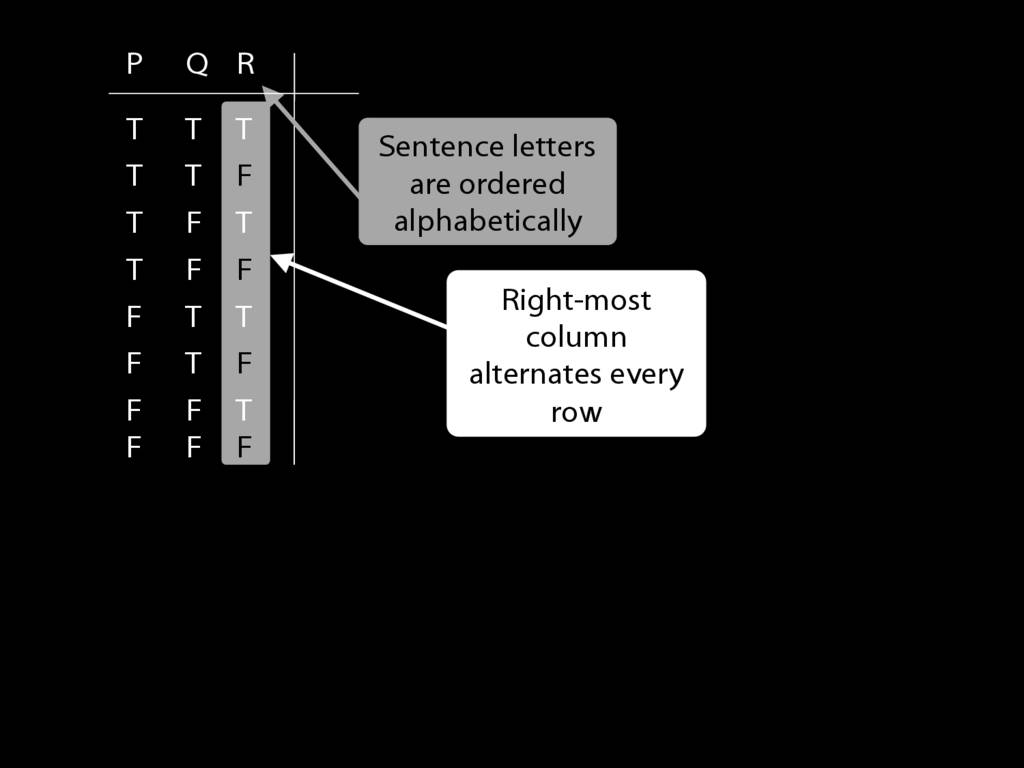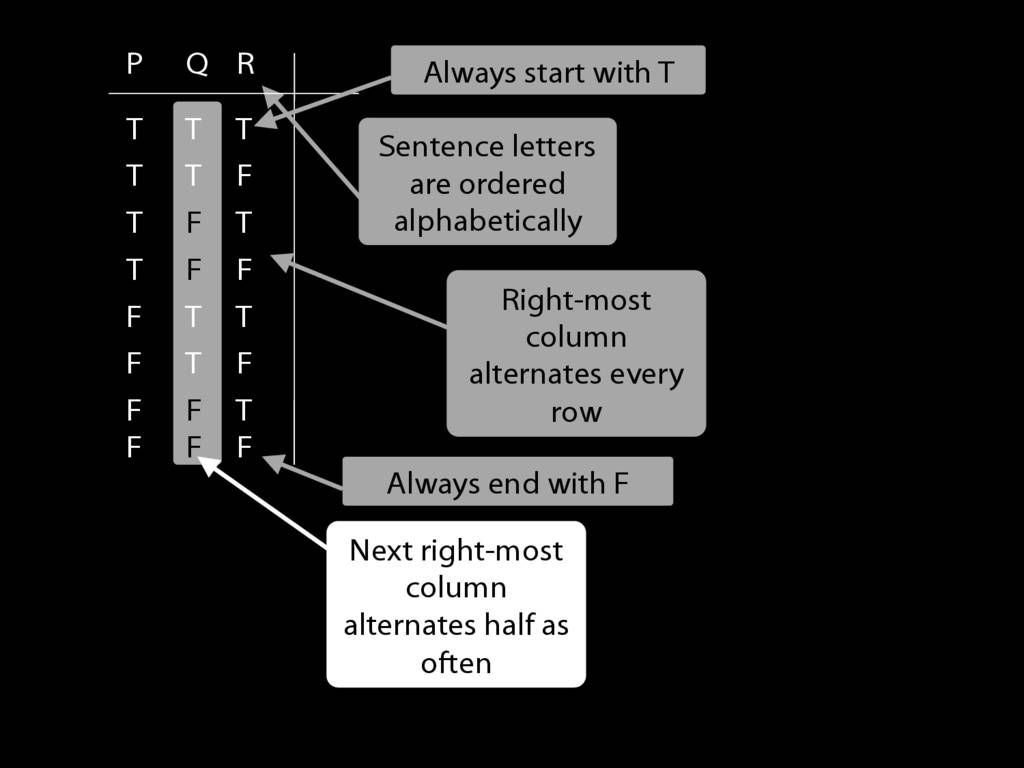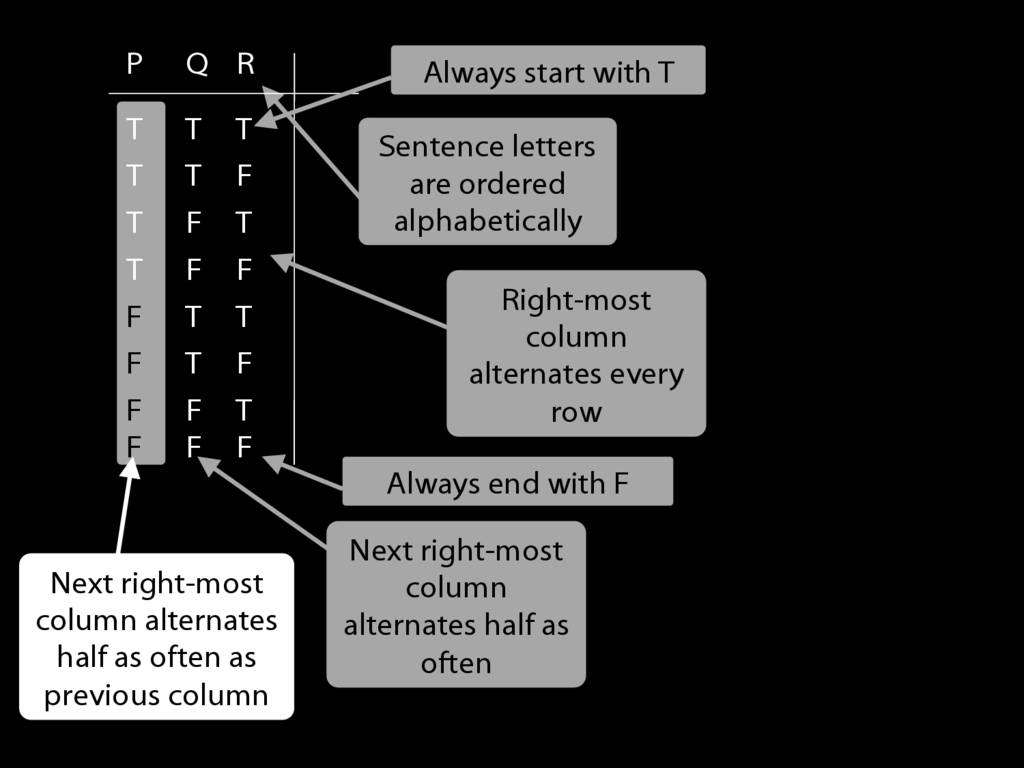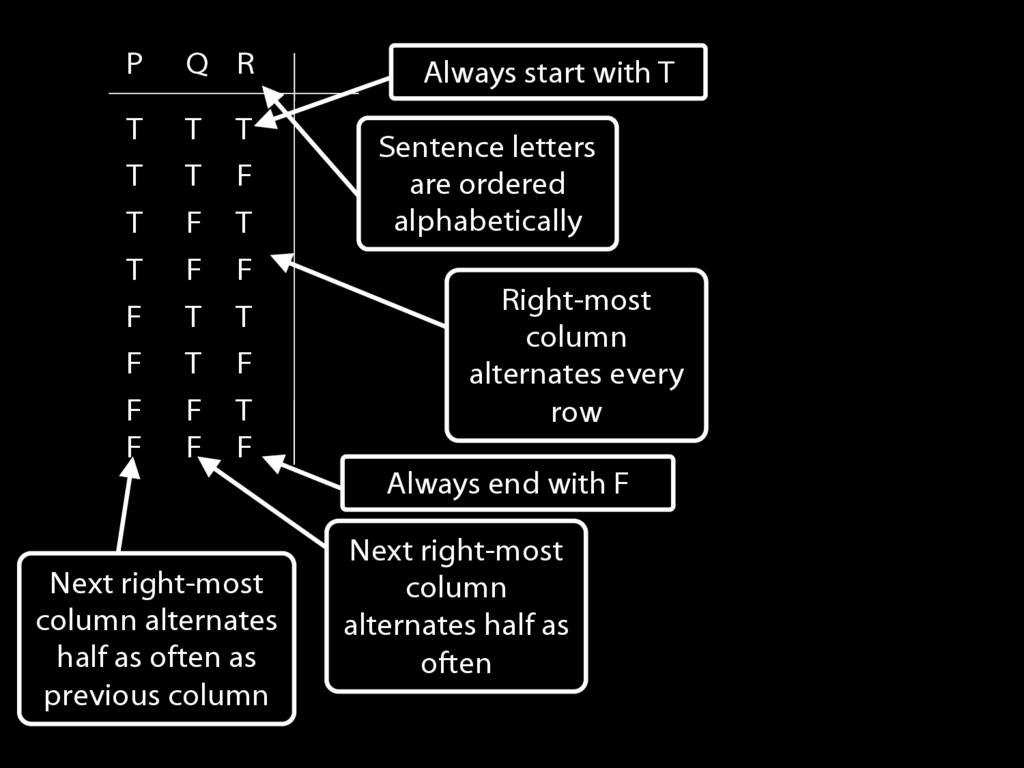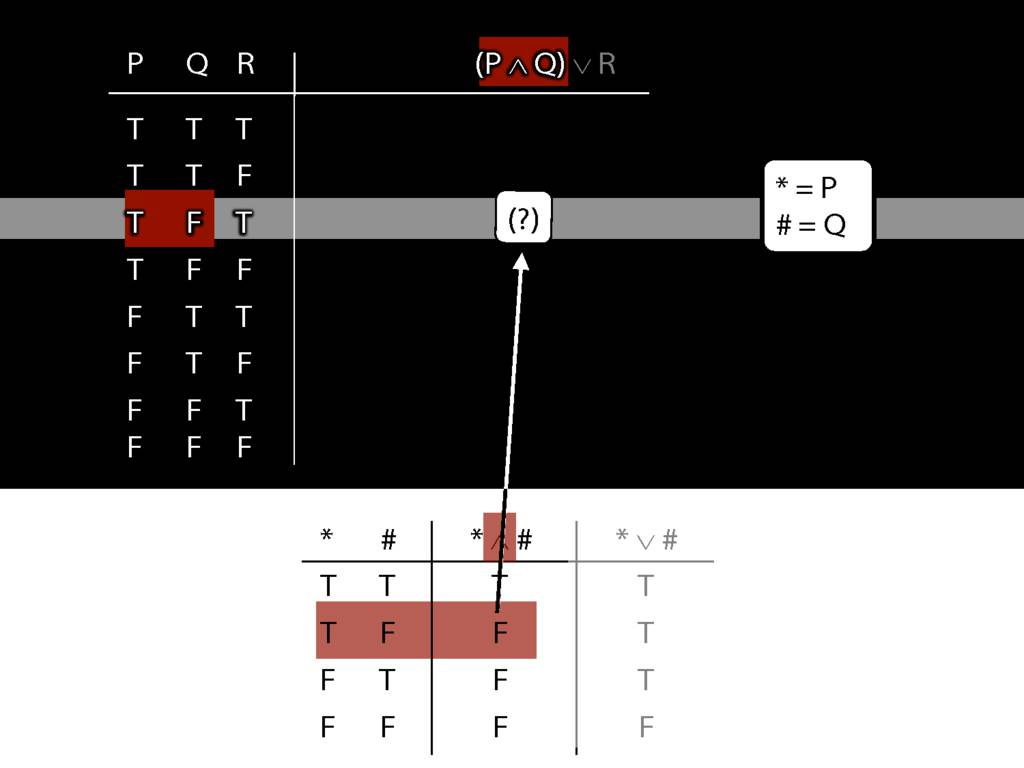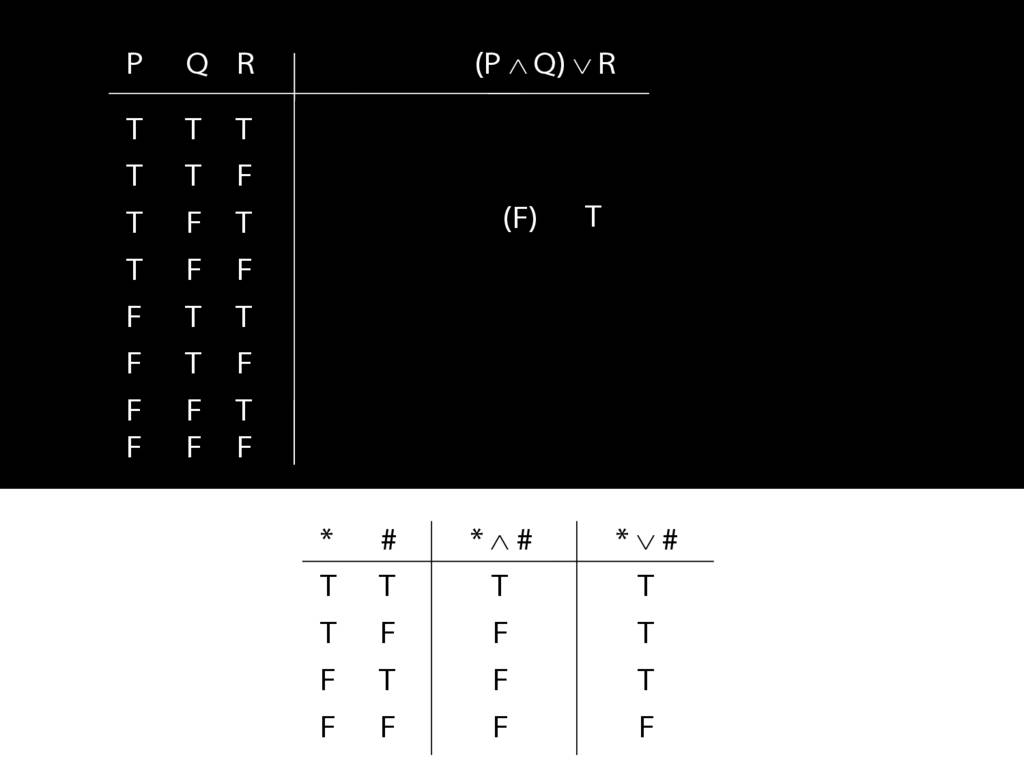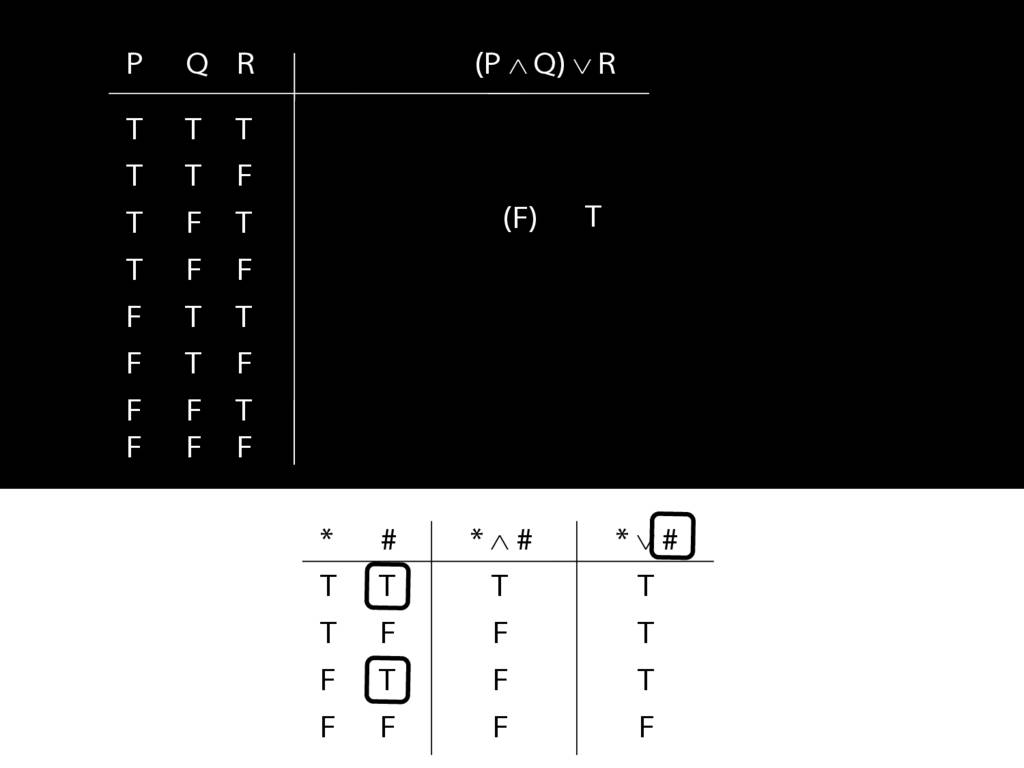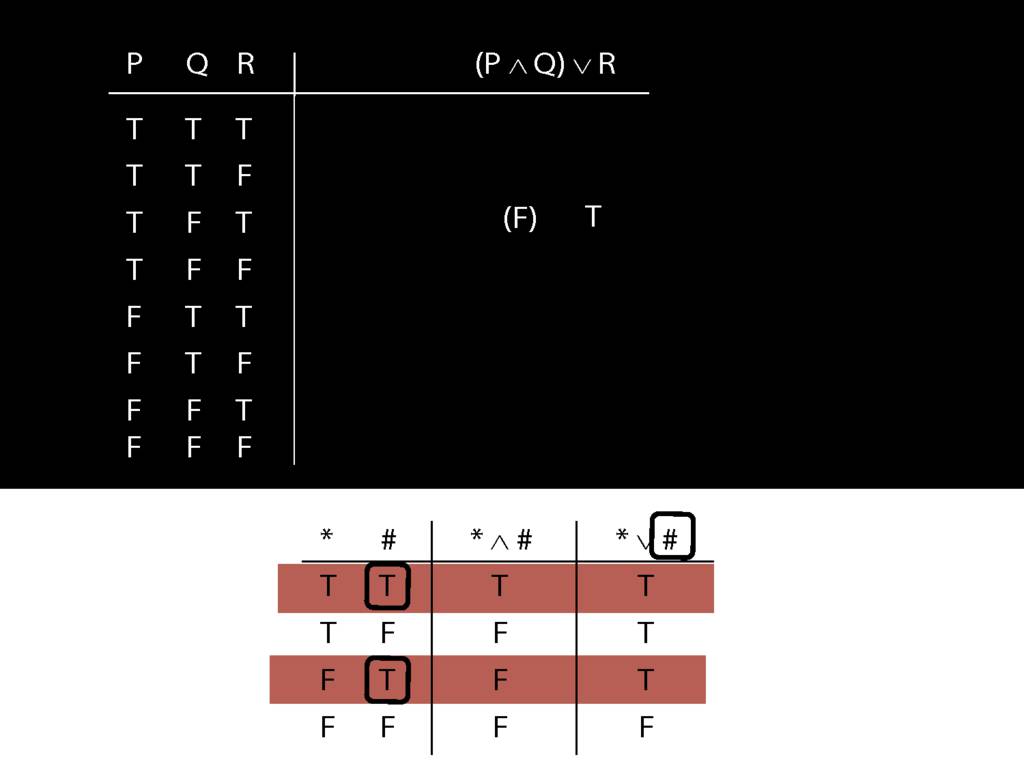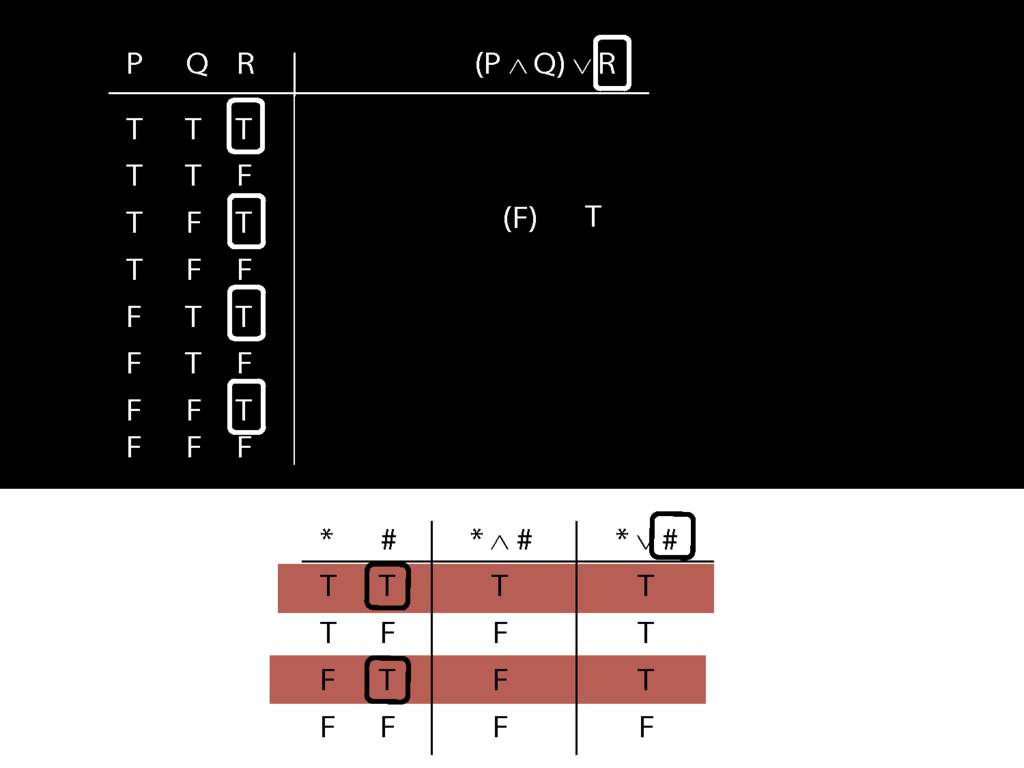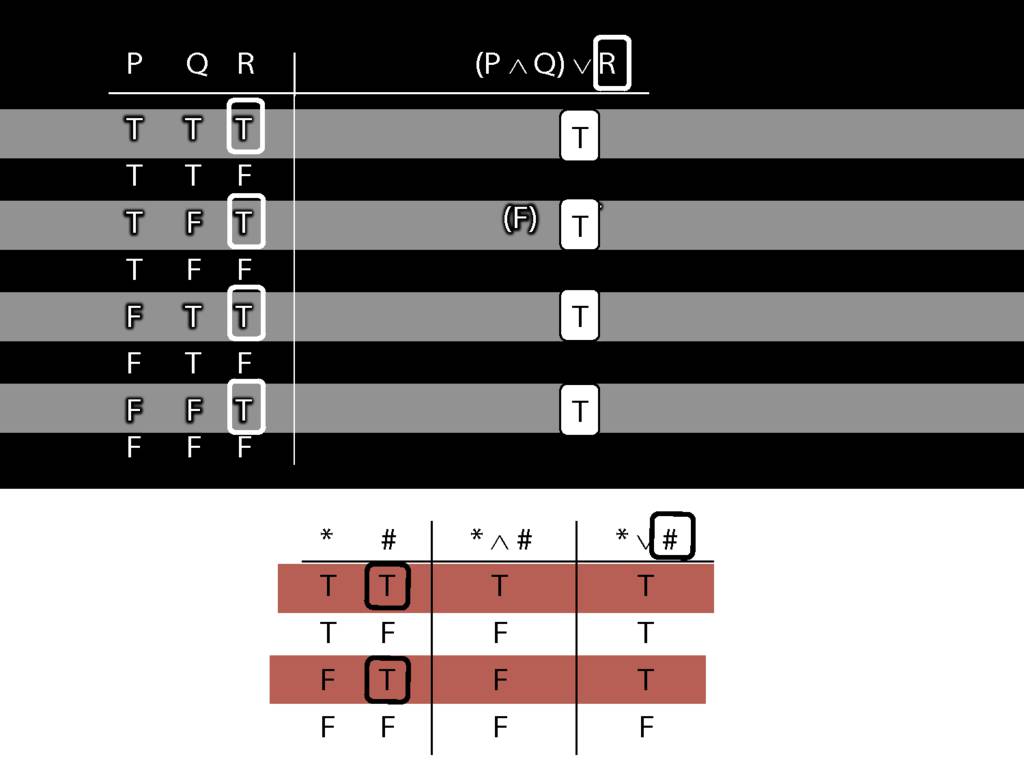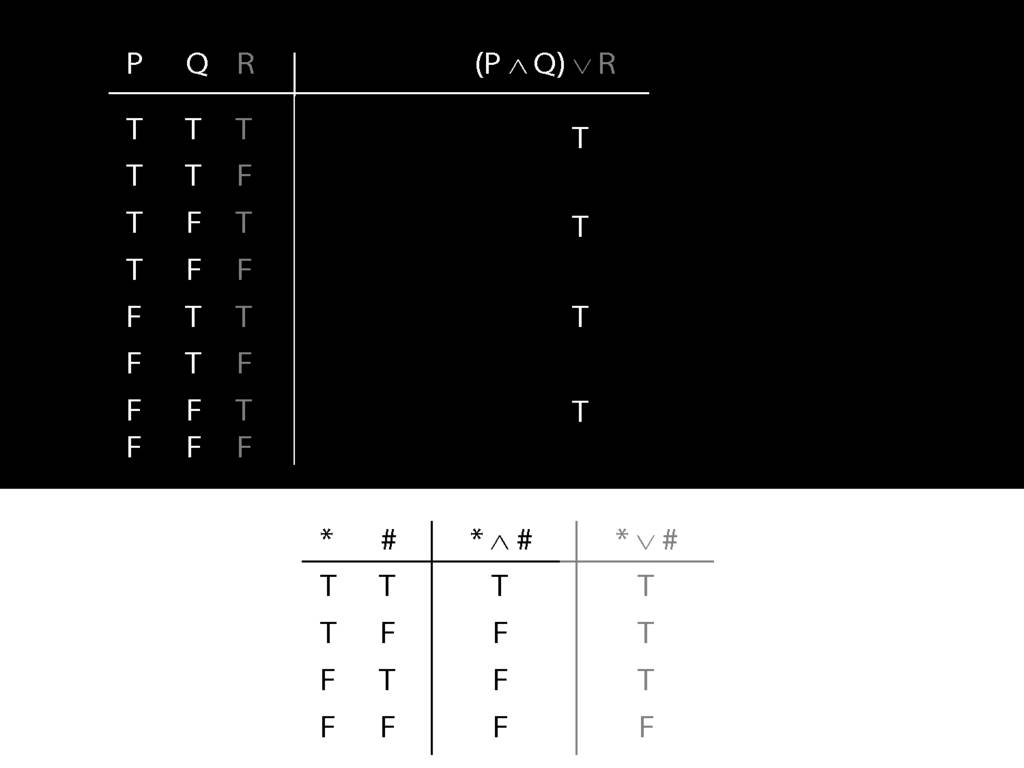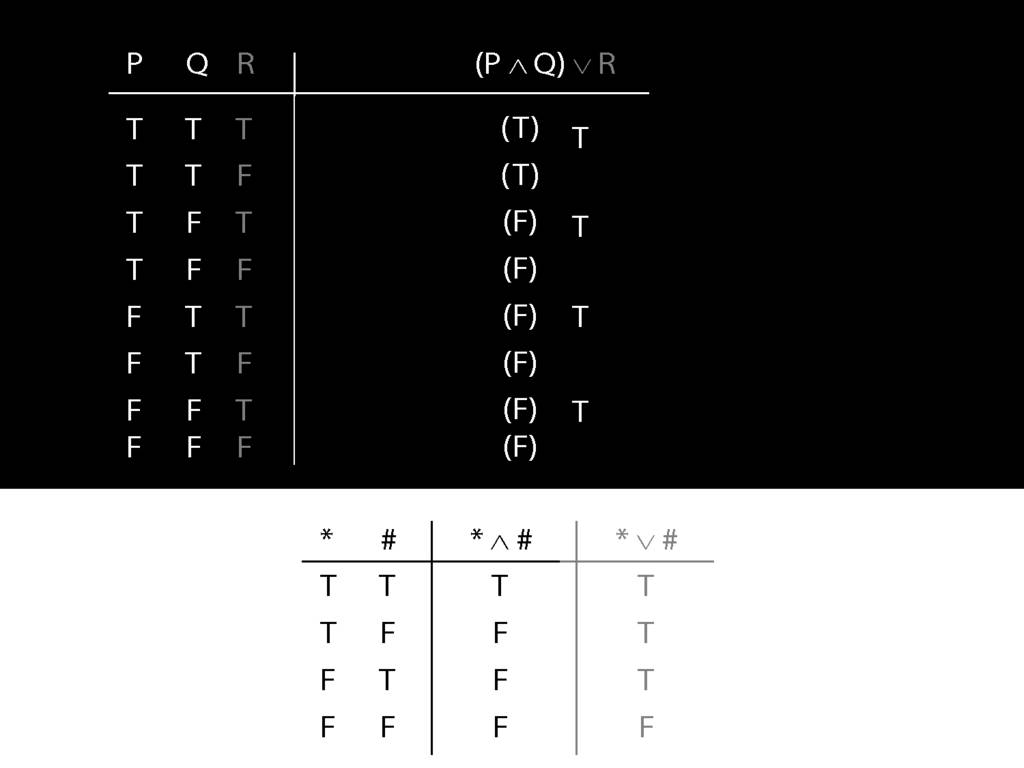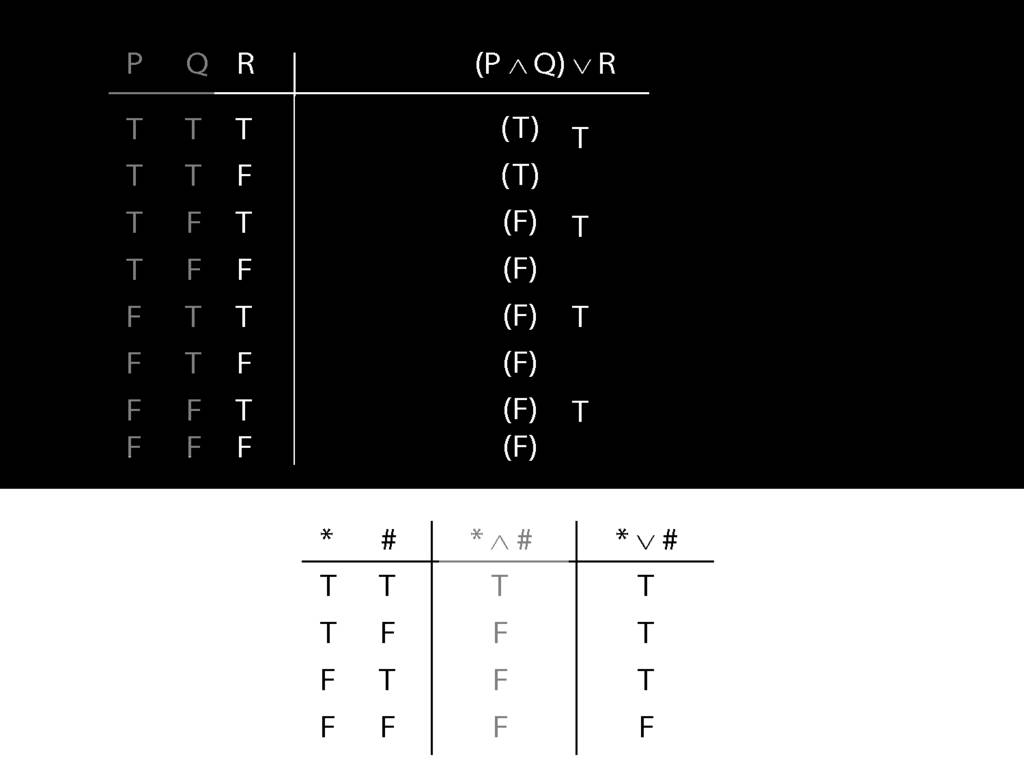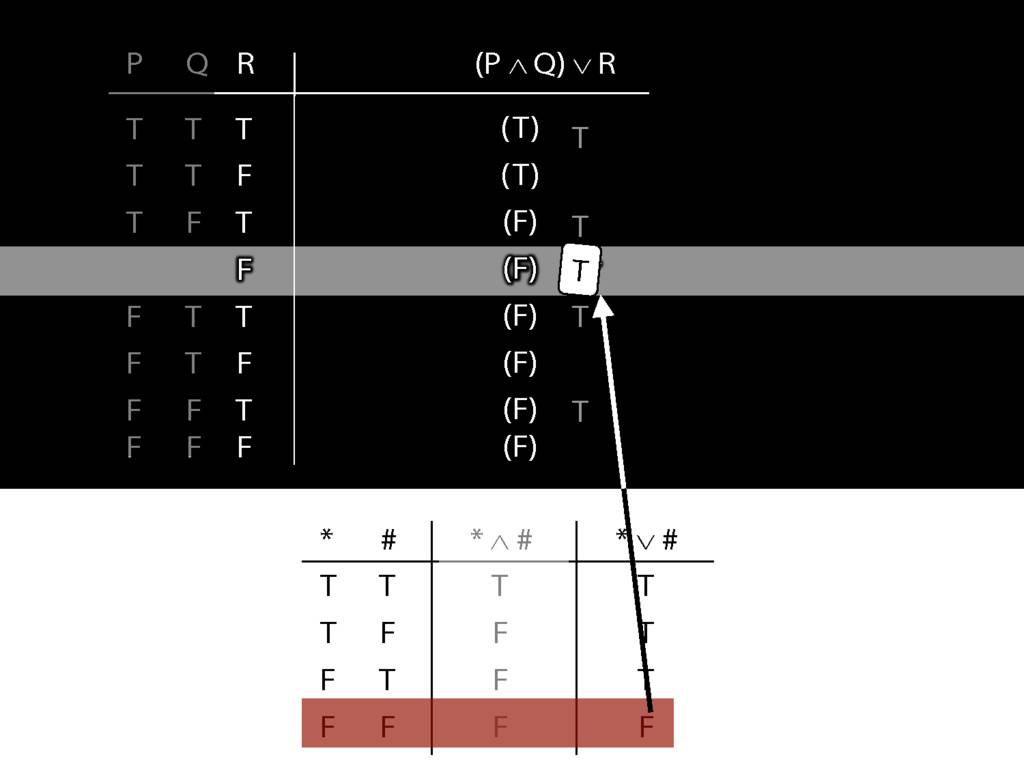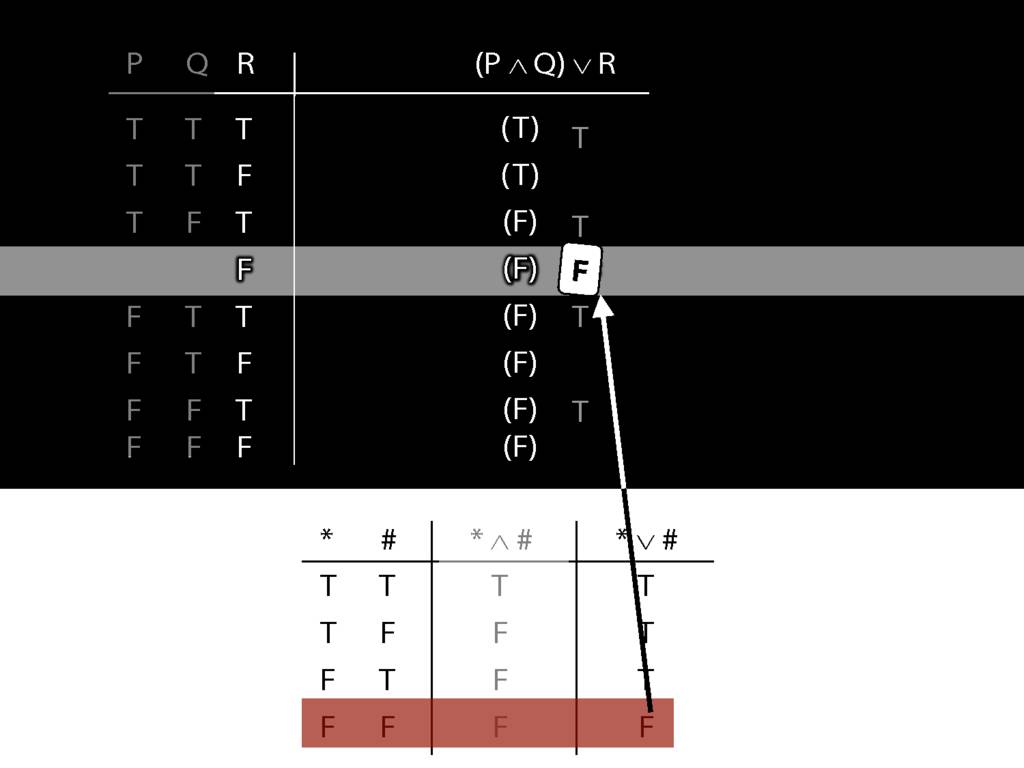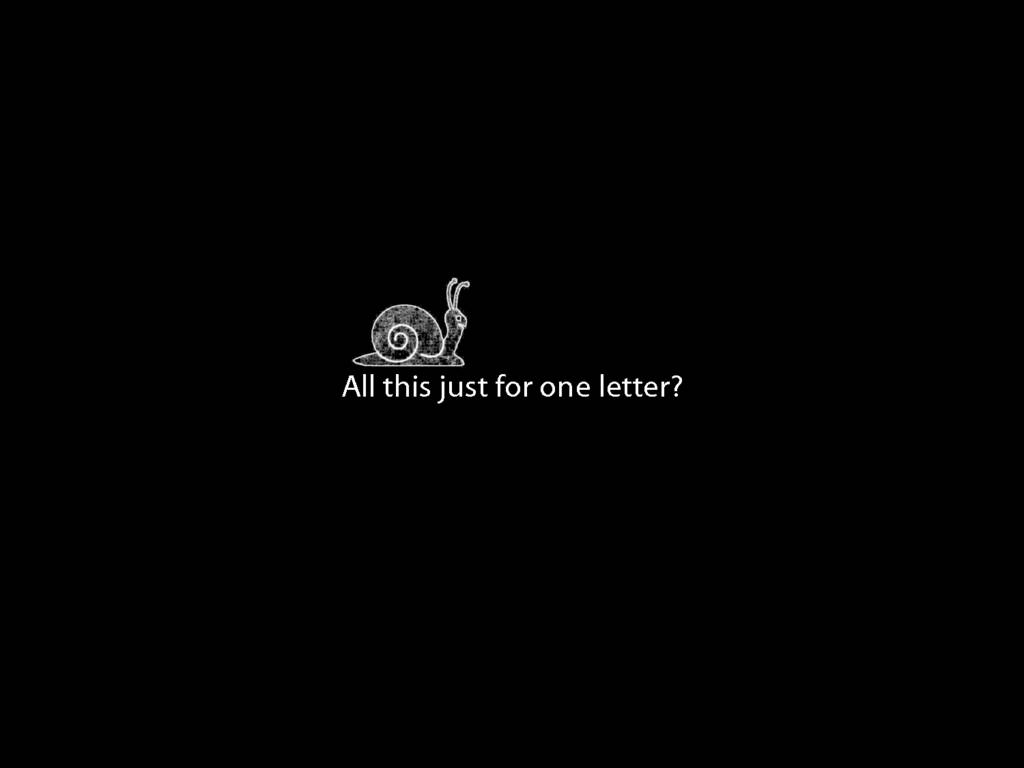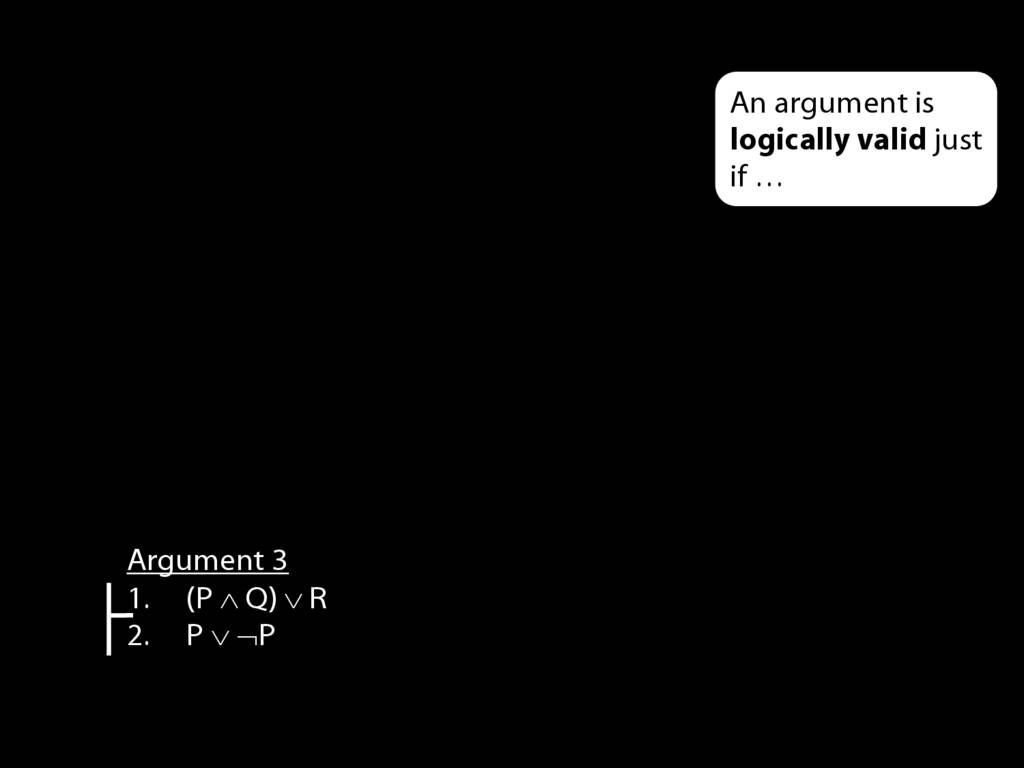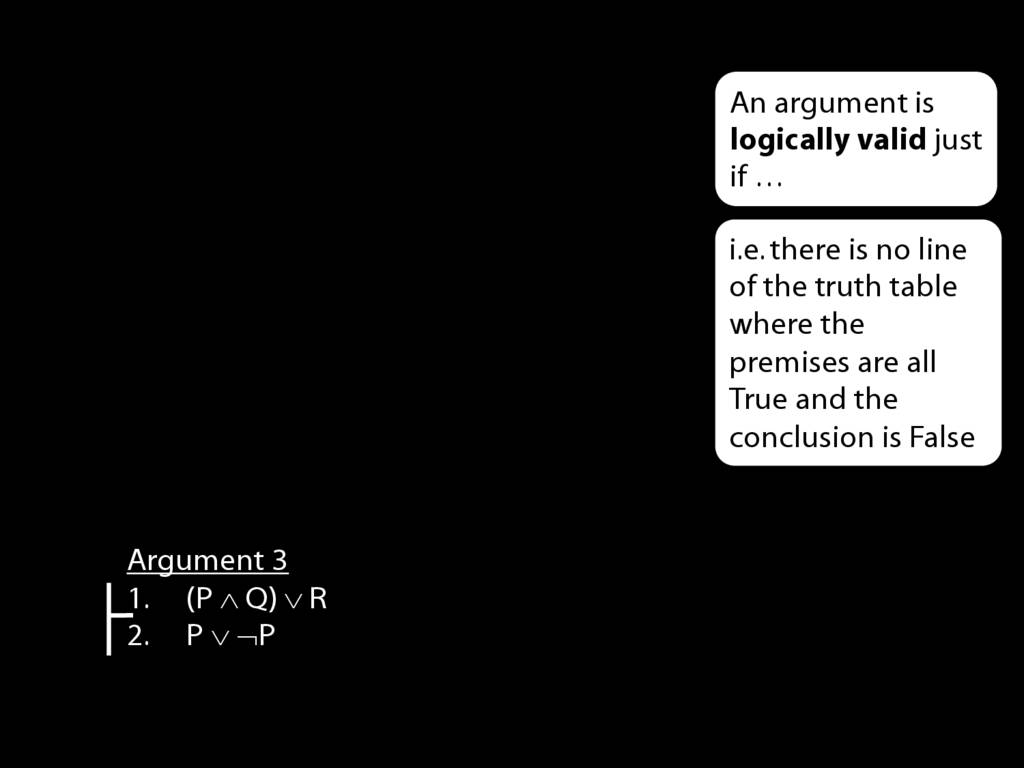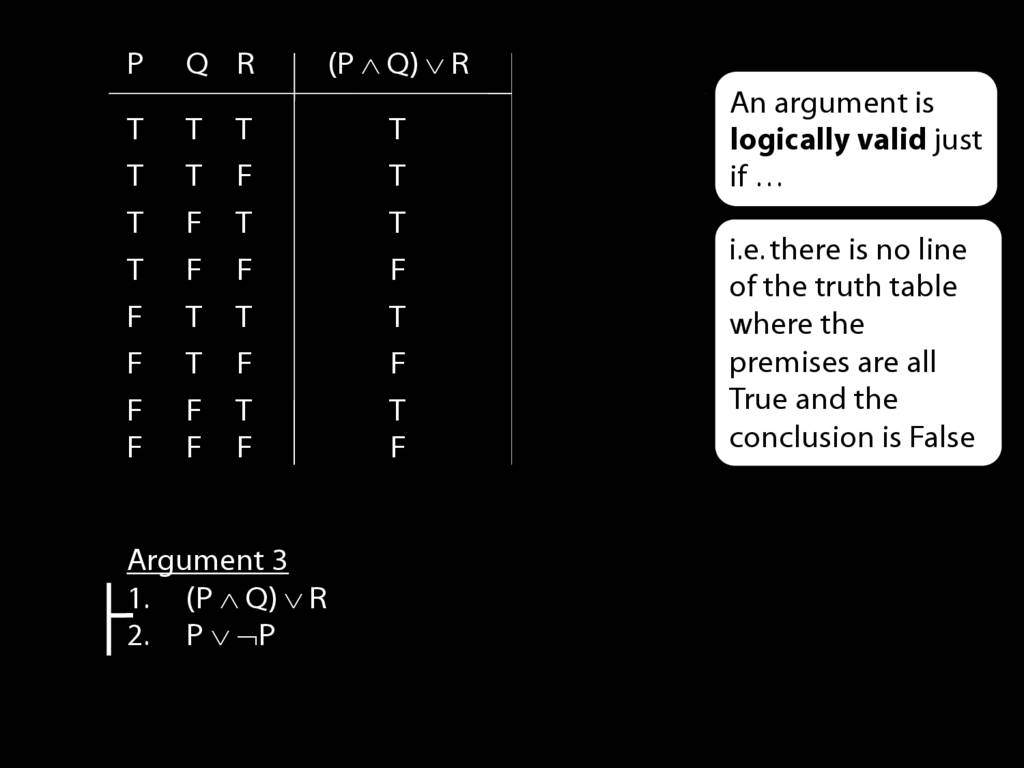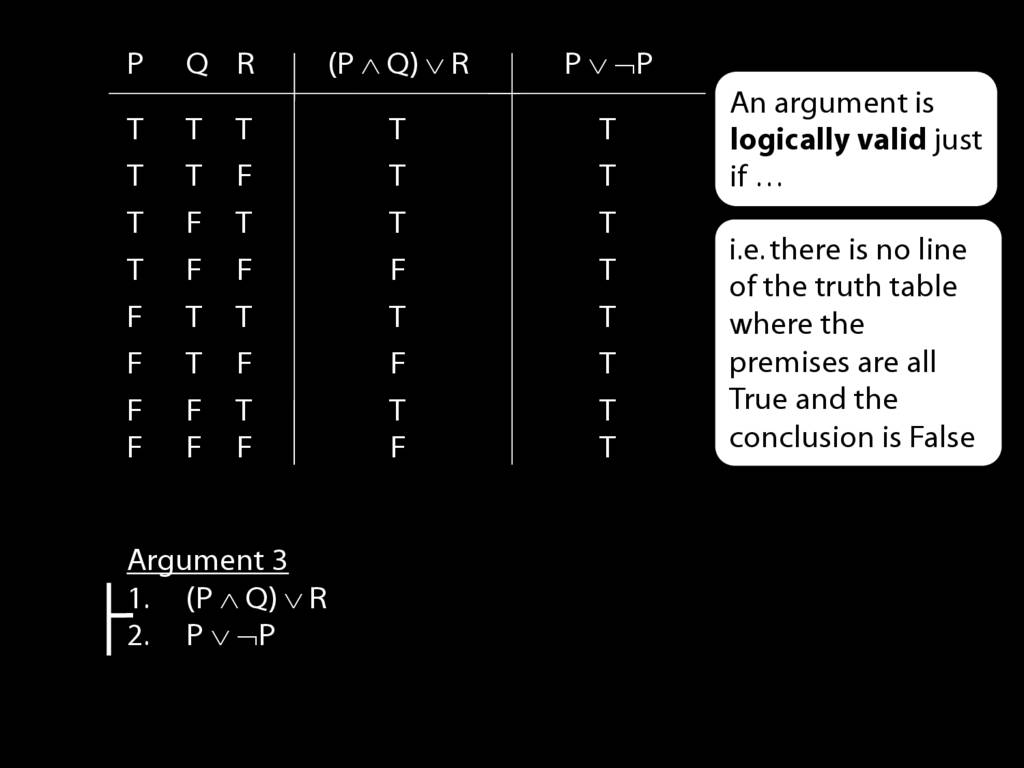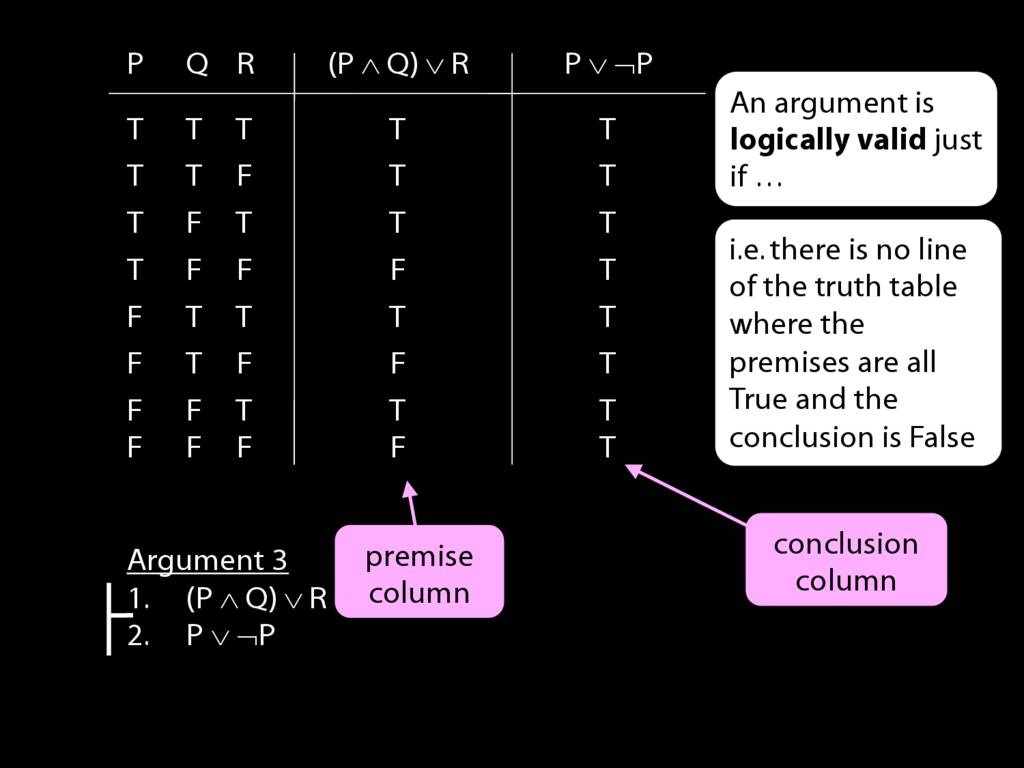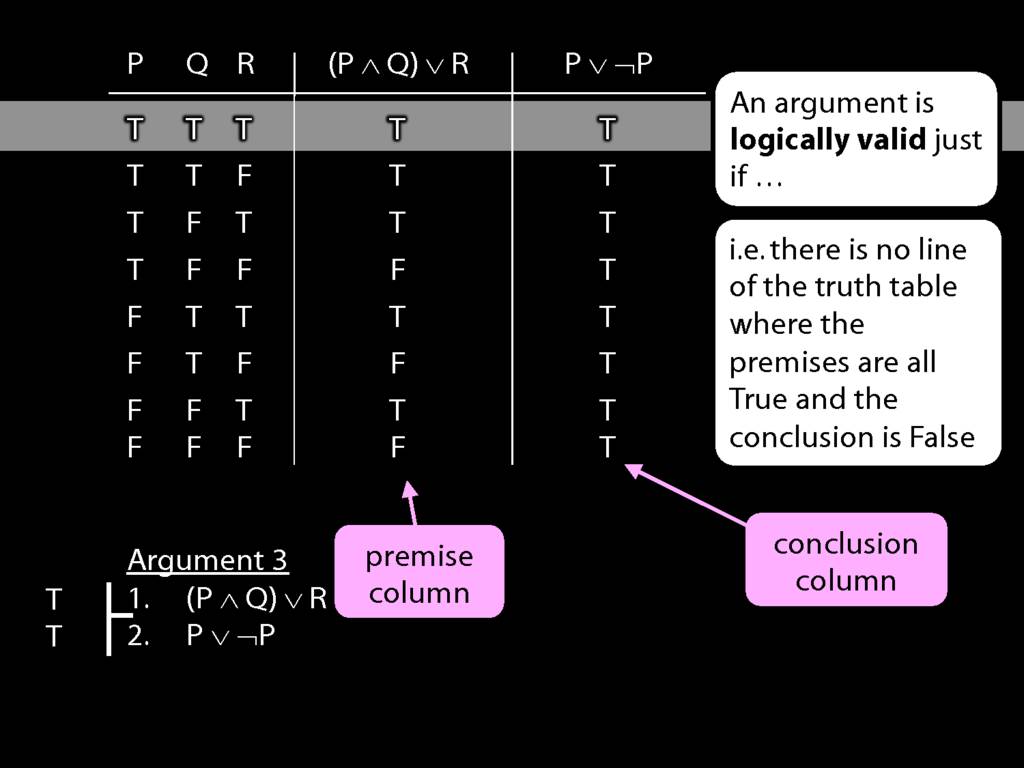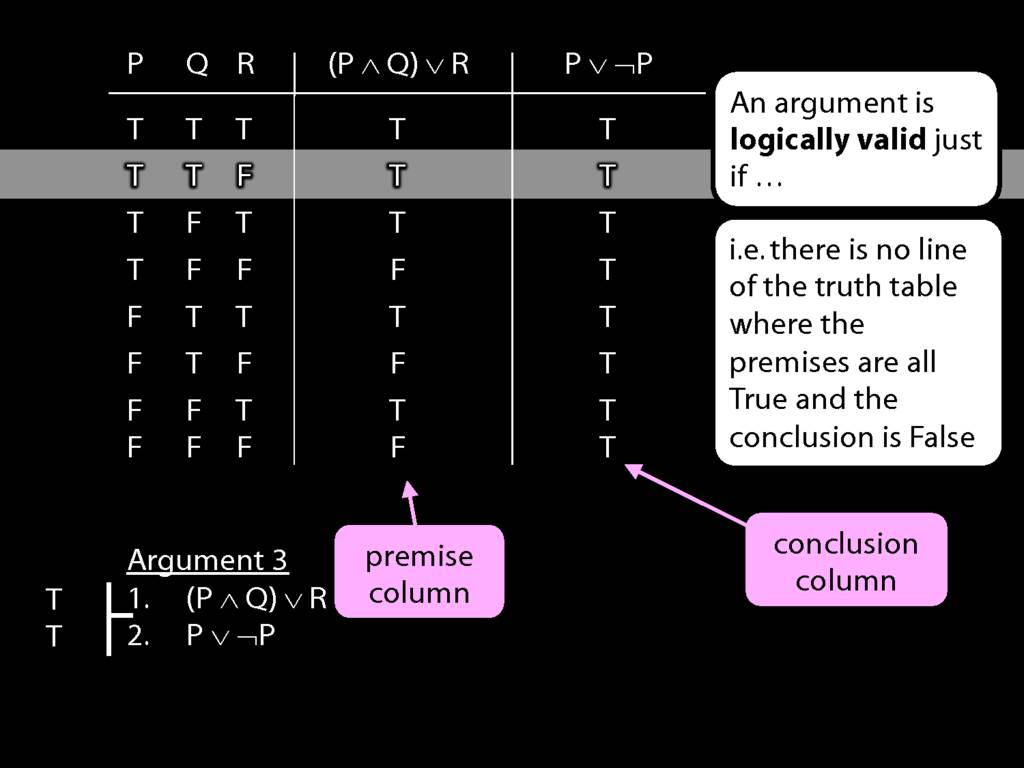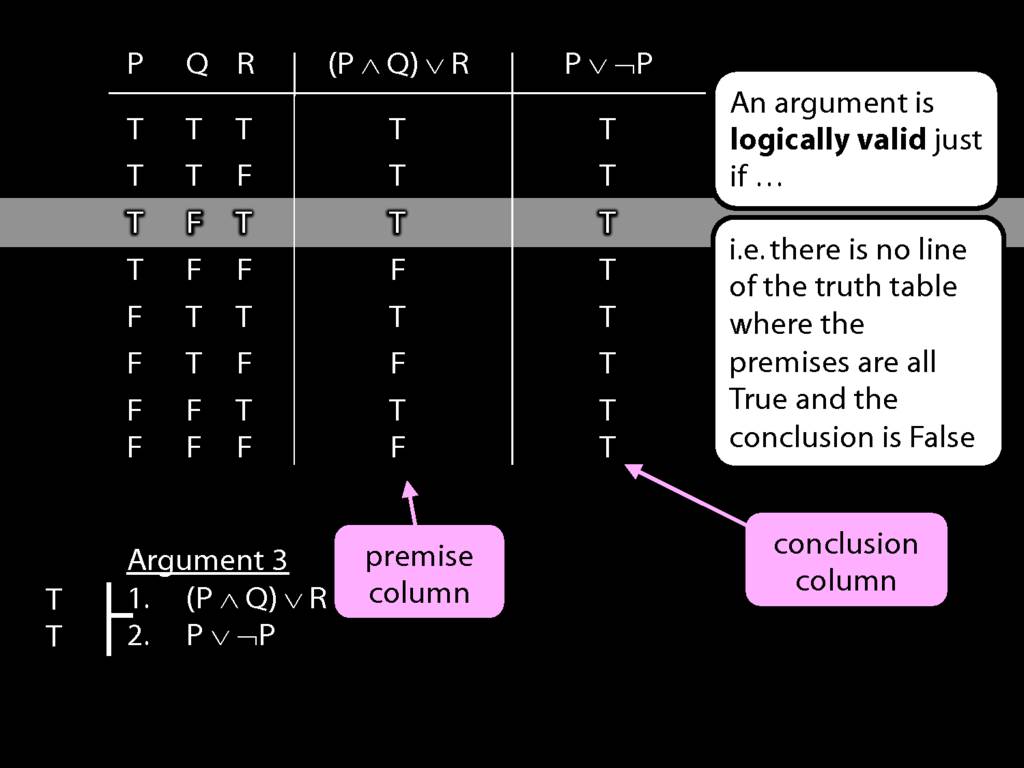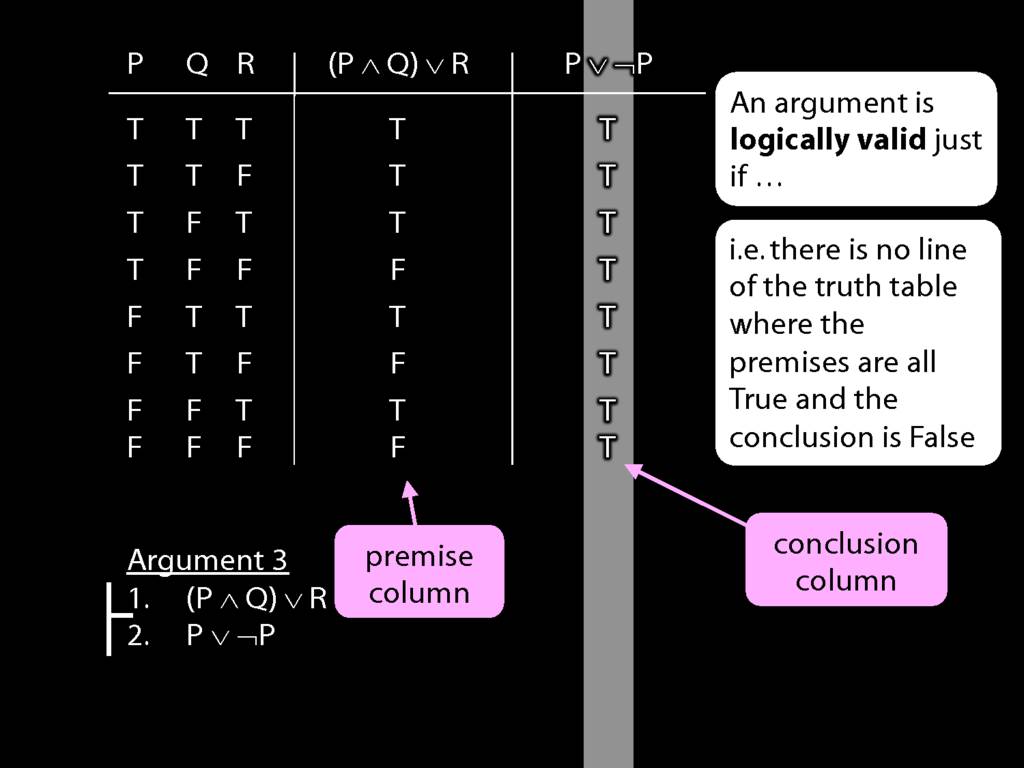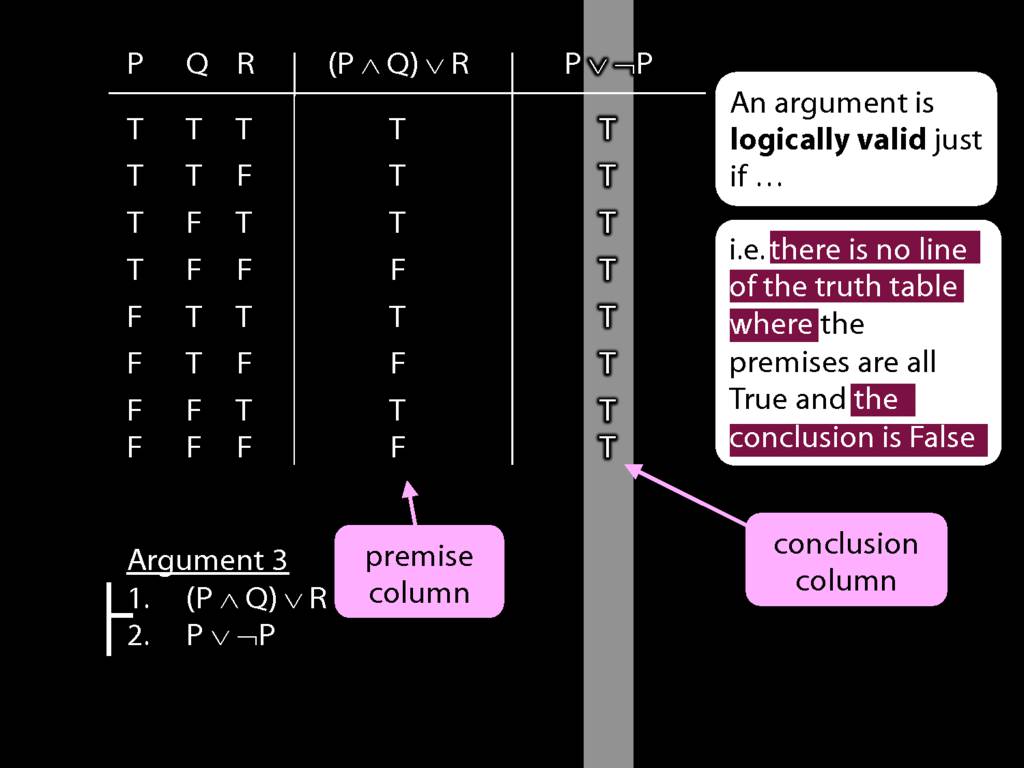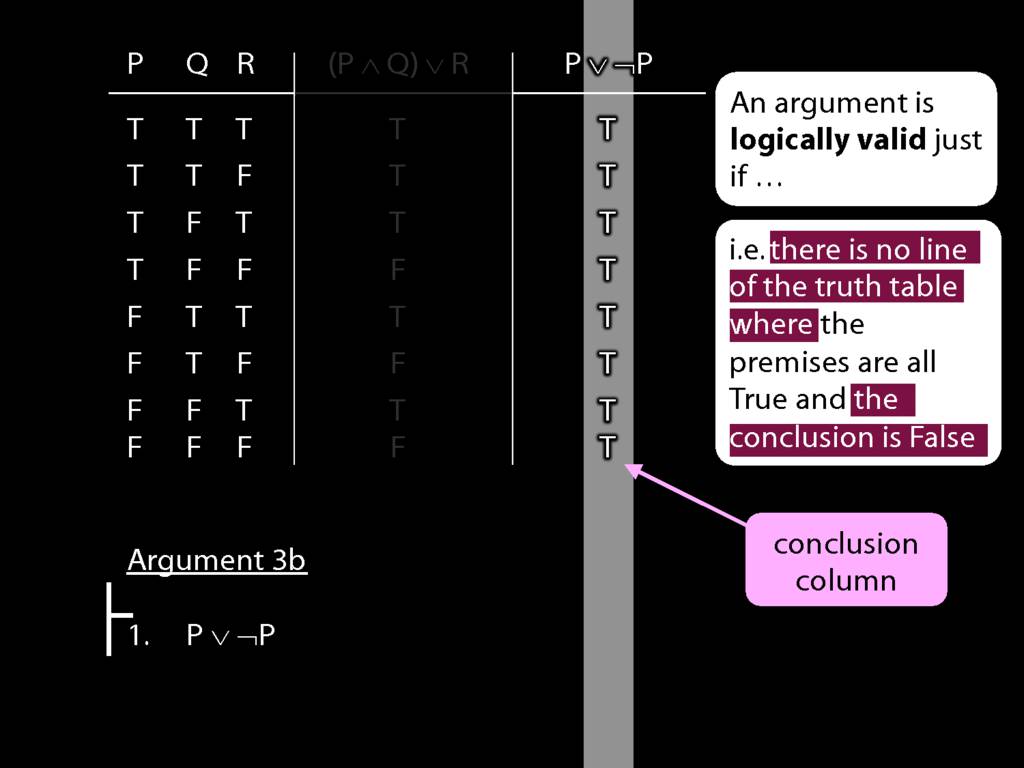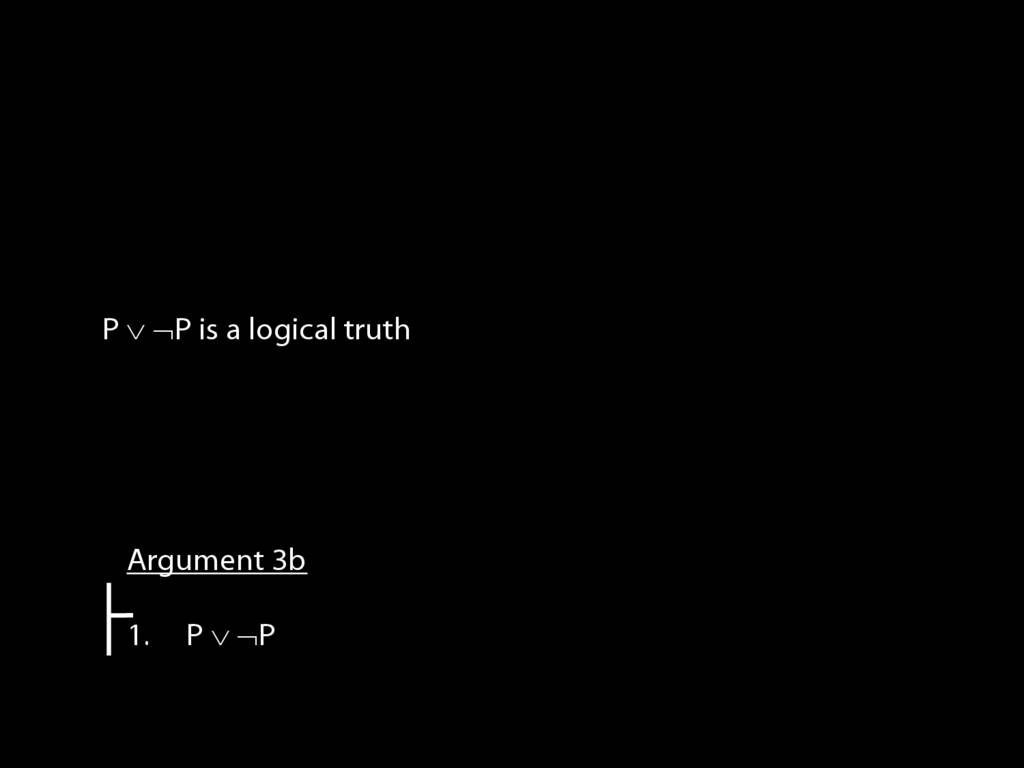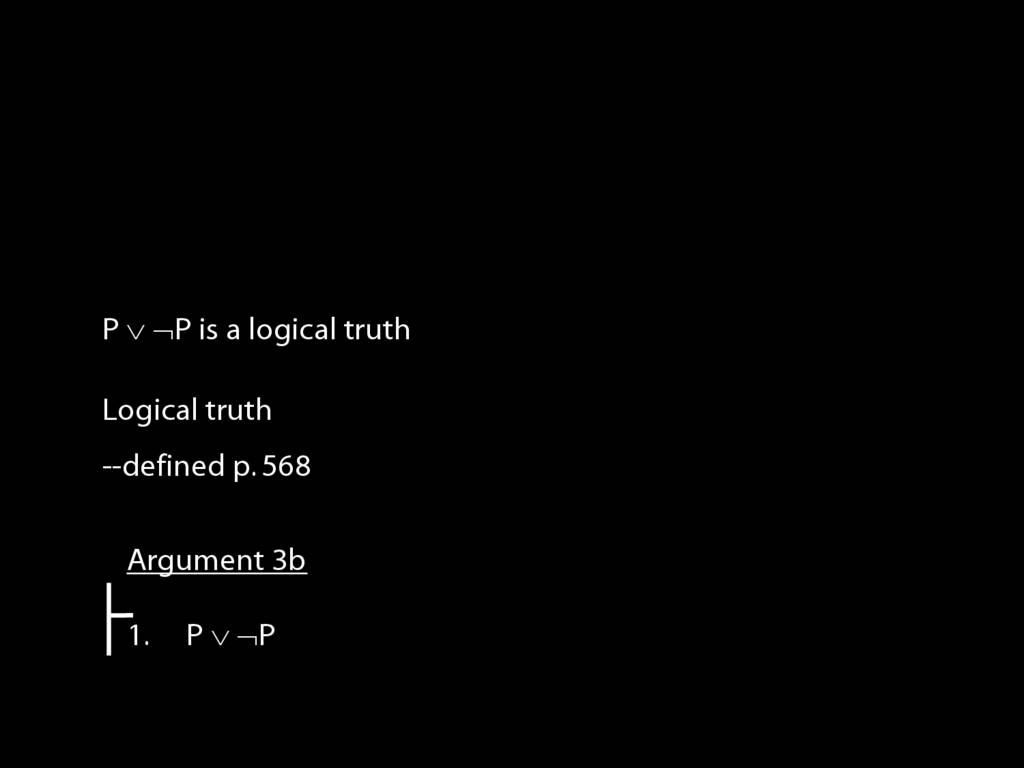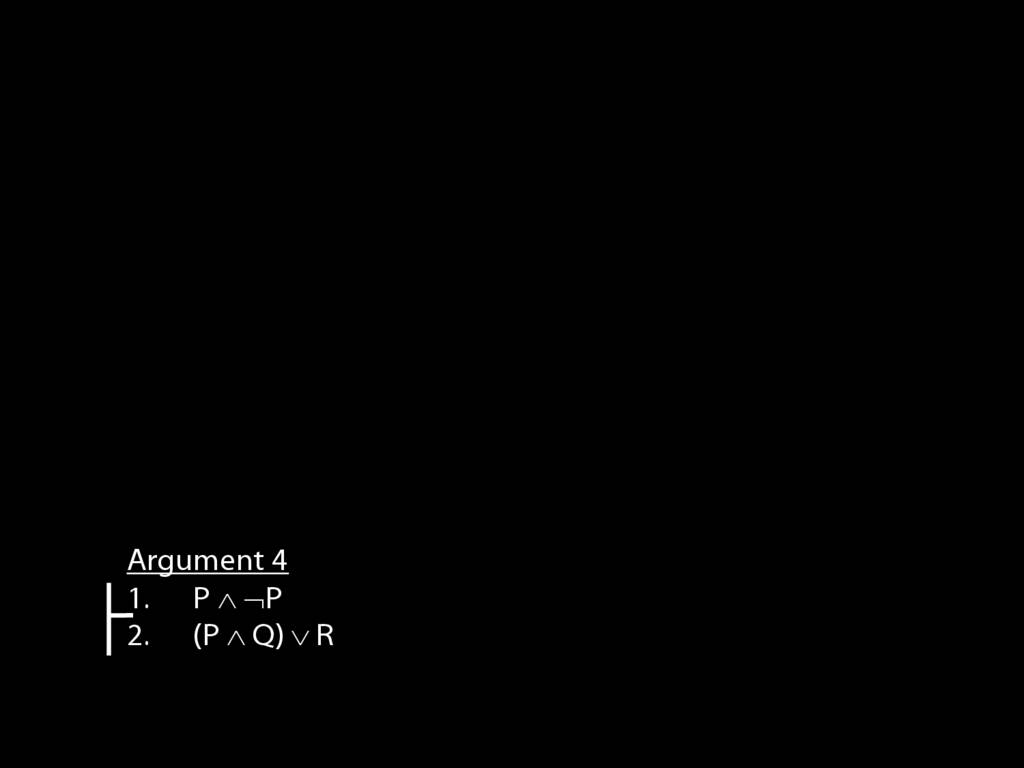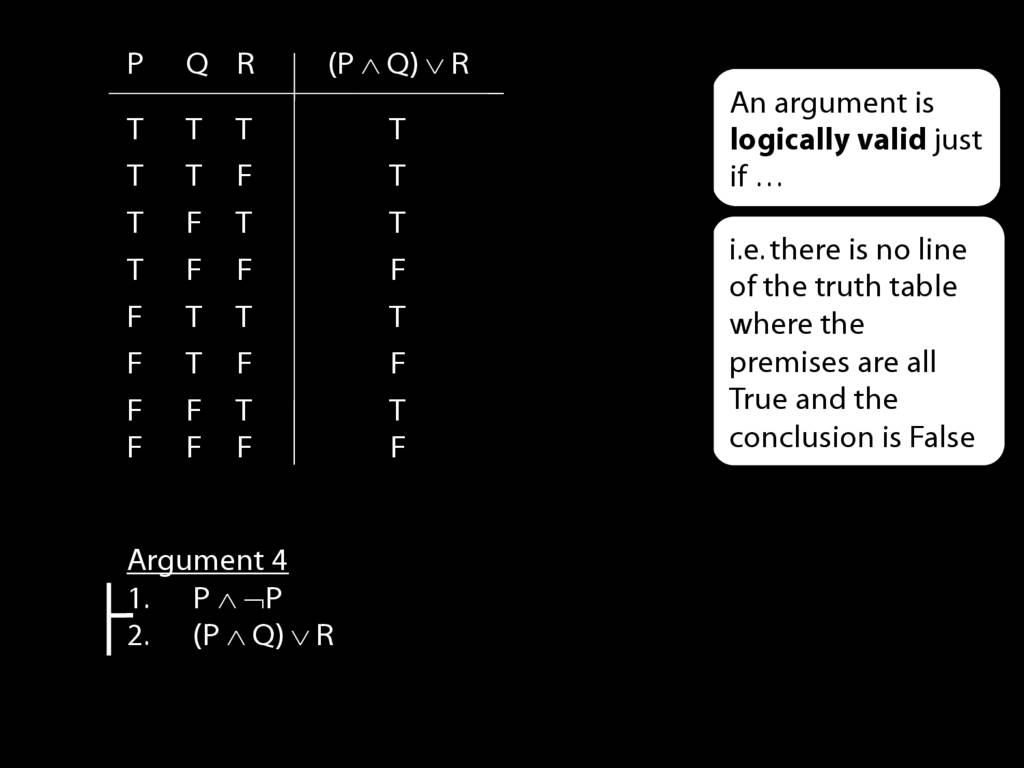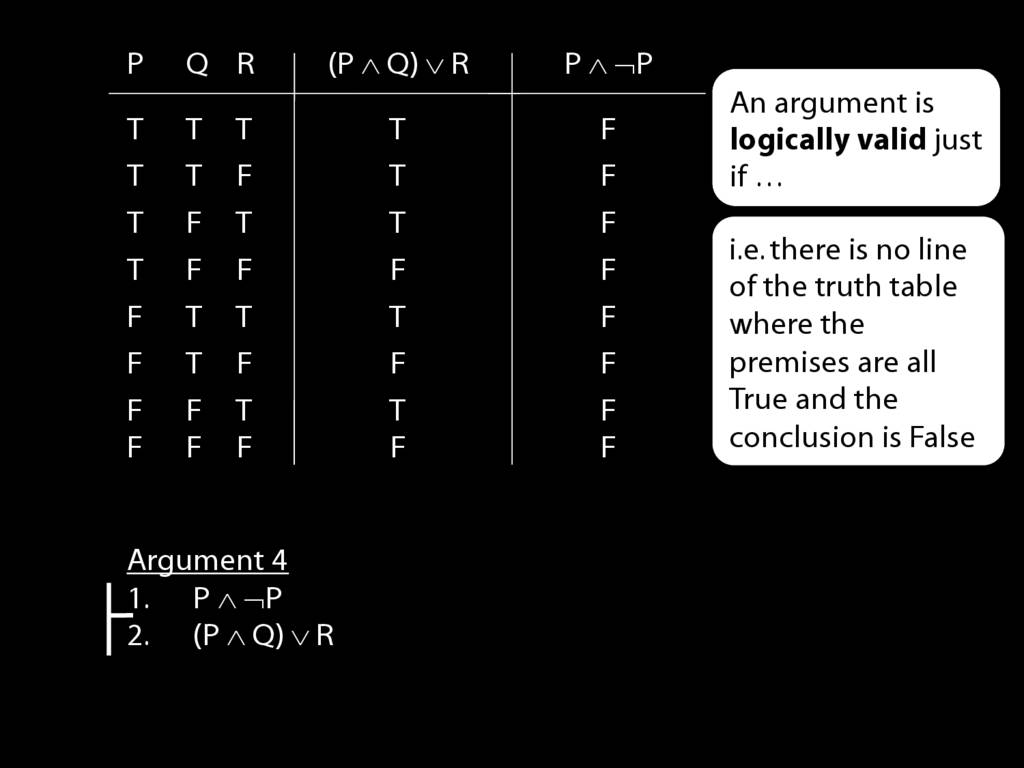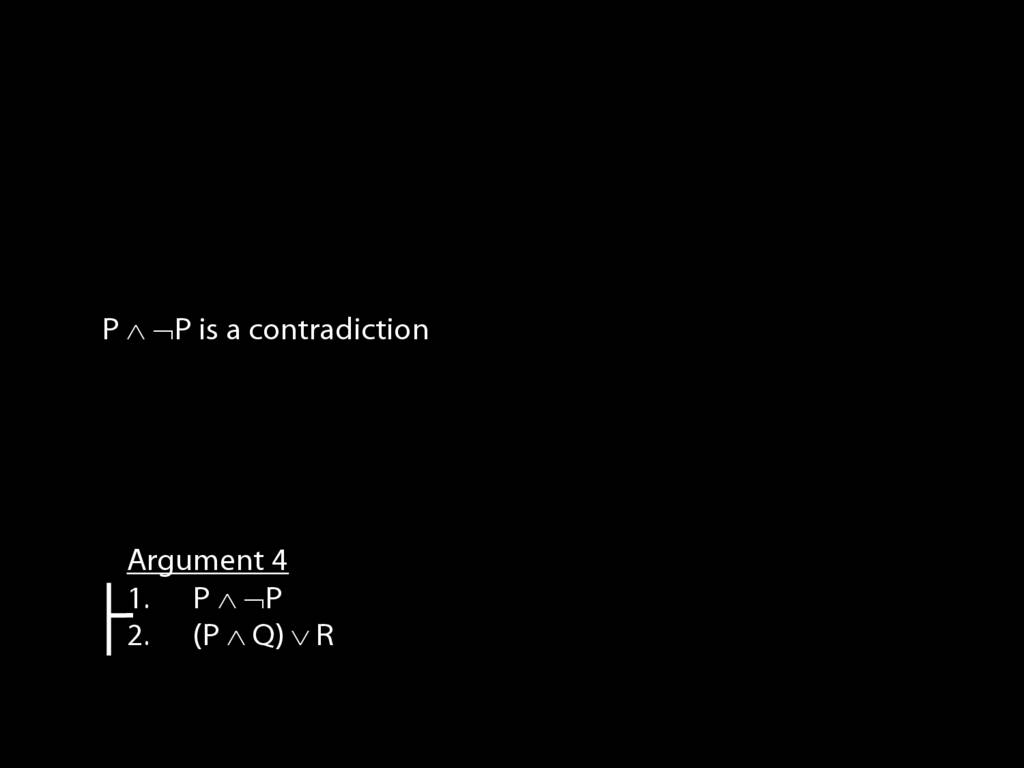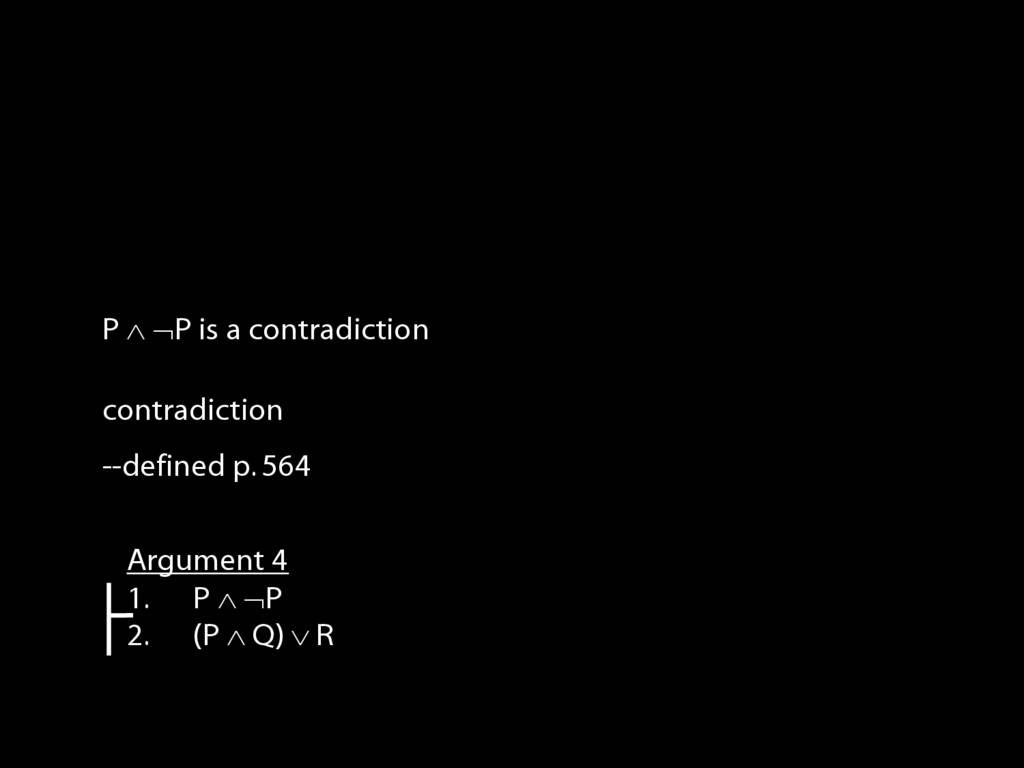Press the right key for the next slide (or swipe left)
also ...
Press the left key to go backwards (or swipe right)
Press n to toggle whether notes are shown (no equivalent if you don't have a keyboard)
Press m or double tap to see a menu of slides

\def \ititle {Logic I}
\def \isubtitle {Lecture 03}
\begin{center}
{\Large
\textbf{\ititle}: \isubtitle
}
\iemail %
\end{center}
Readings refer to sections of the course textbook, \emph{Language, Proof and Logic}.
\section{Logical Validity and Truth Tables}
\emph{Reading:} §4.3
We can use truth tables to establish that
some arguments are logically valid
\begin{minipage}{\columnwidth}
Truth tables can be used to show that an argument is valid. To illustrate ...
\end{minipage}
\begin{minipage}{\columnwidth}
To establish that an argument is valid:
\begin{enumerate}
\item Create truth tables for each premise and the conclusion.
\item Check whether there is a row of the truth table where all premises are true and the conclusion is false.
\item If not, the argument is valid.
\end{enumerate}
\end{minipage}
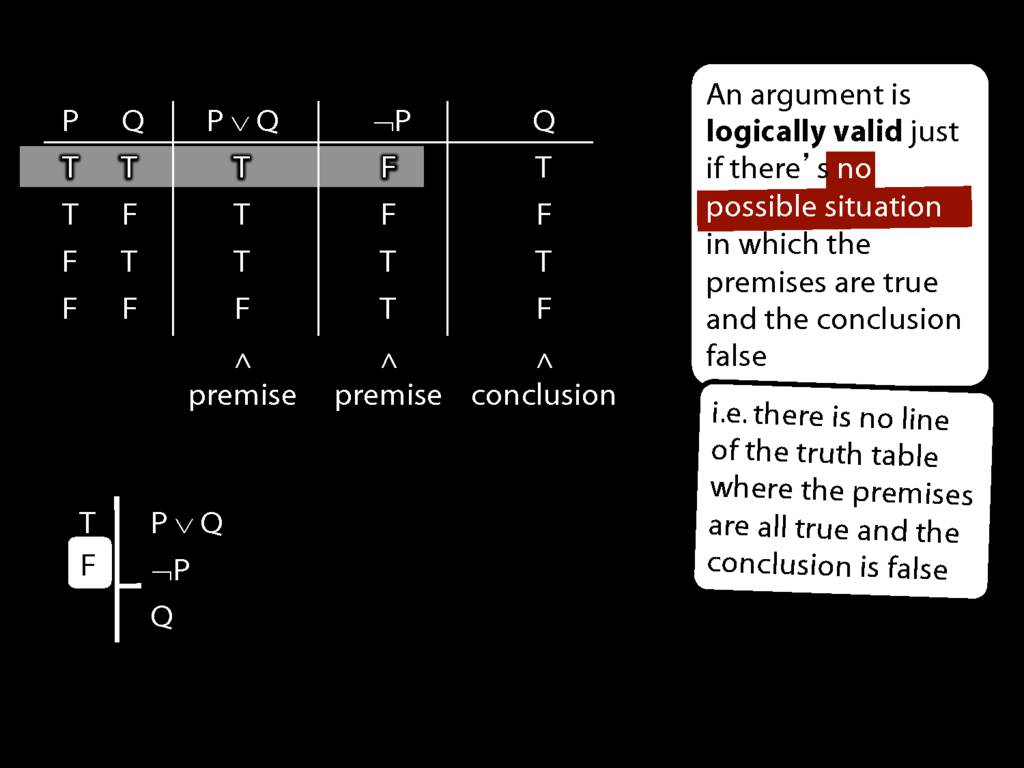
Don’t need to go further, already have a false premise. So this won’t be a situation in which the premises are true and the conclusion false.
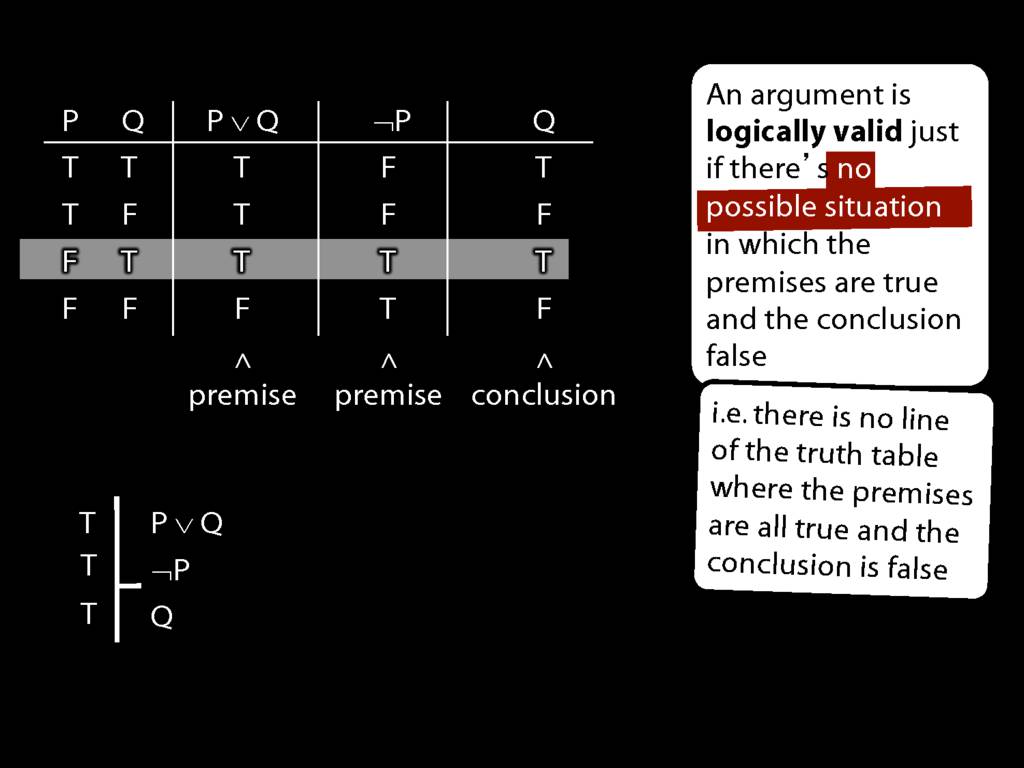
This situation is different from the other two: the premises are true in this possible situation, so we had to think about whether the conclusion is true.
But, as you can see, the conclusion is also true. So this is no counterexample.
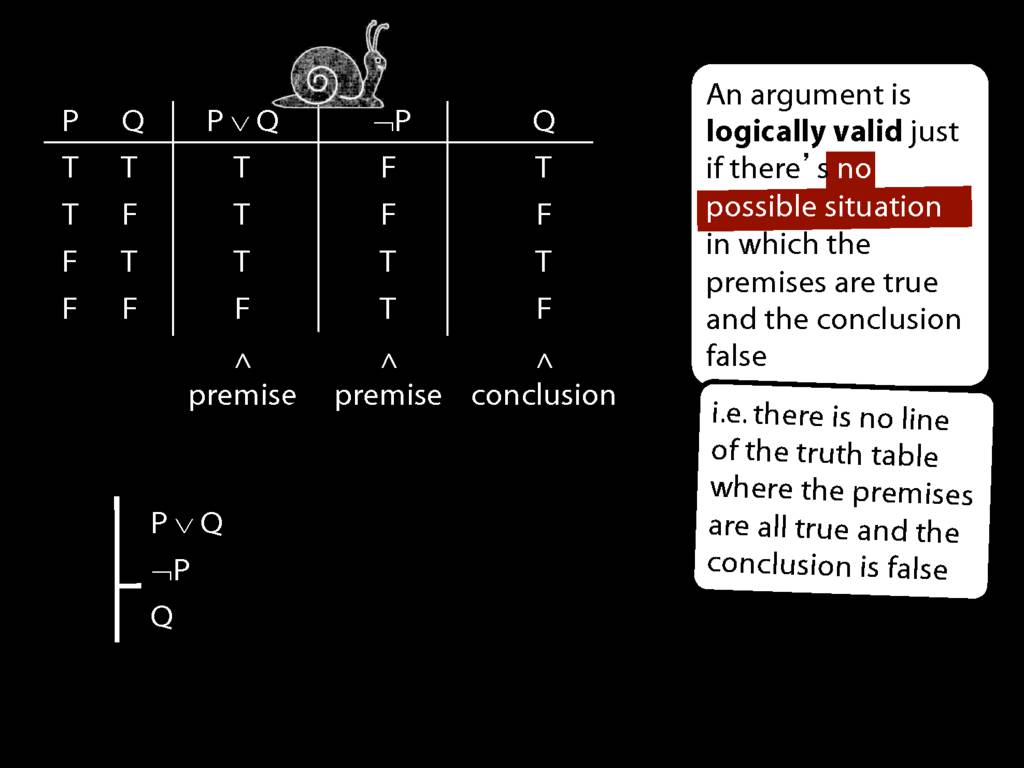
So if someone asked you to show that this argument is valid using truth tables, what would you do?
First, create truth tables for each premise and for the conclusion.
Next, check whether there is any row where the premises are true and the conclusion false.
If not, you can write this:
By inspecting the truth table, there is no row where the premises are true and the conclusion false; therefore, the argument is logically valid.

When you're doing truth tables there's a temptation to race through them.
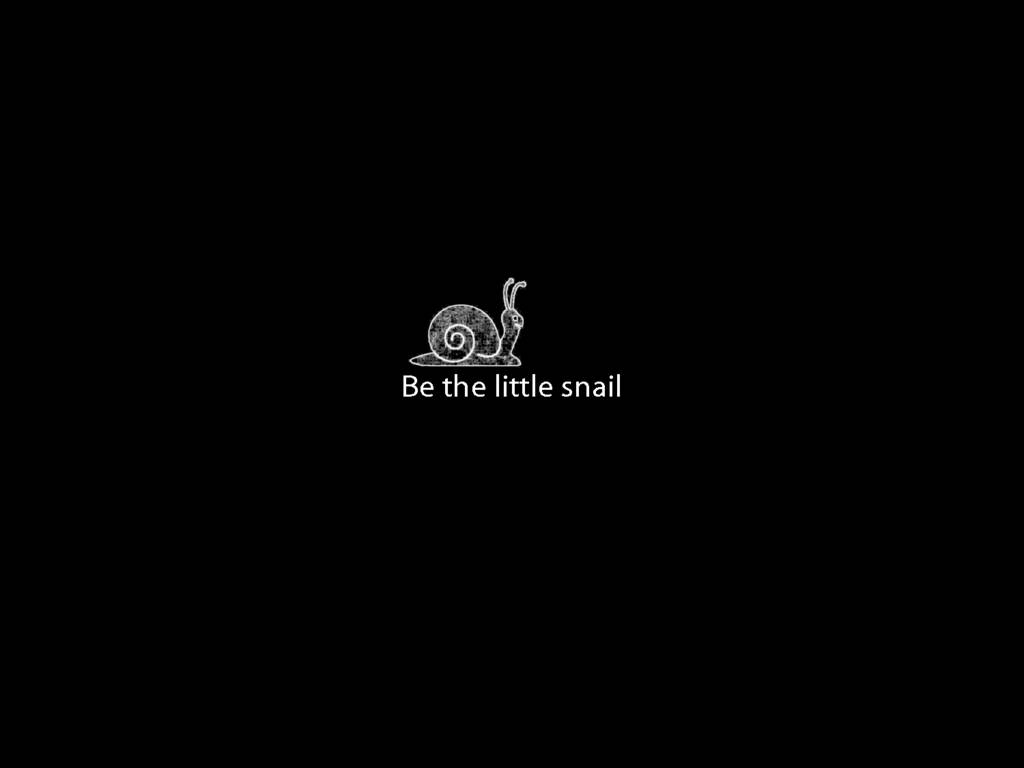
But you shouldn't do that. Be the little snail.
5.1-5.4
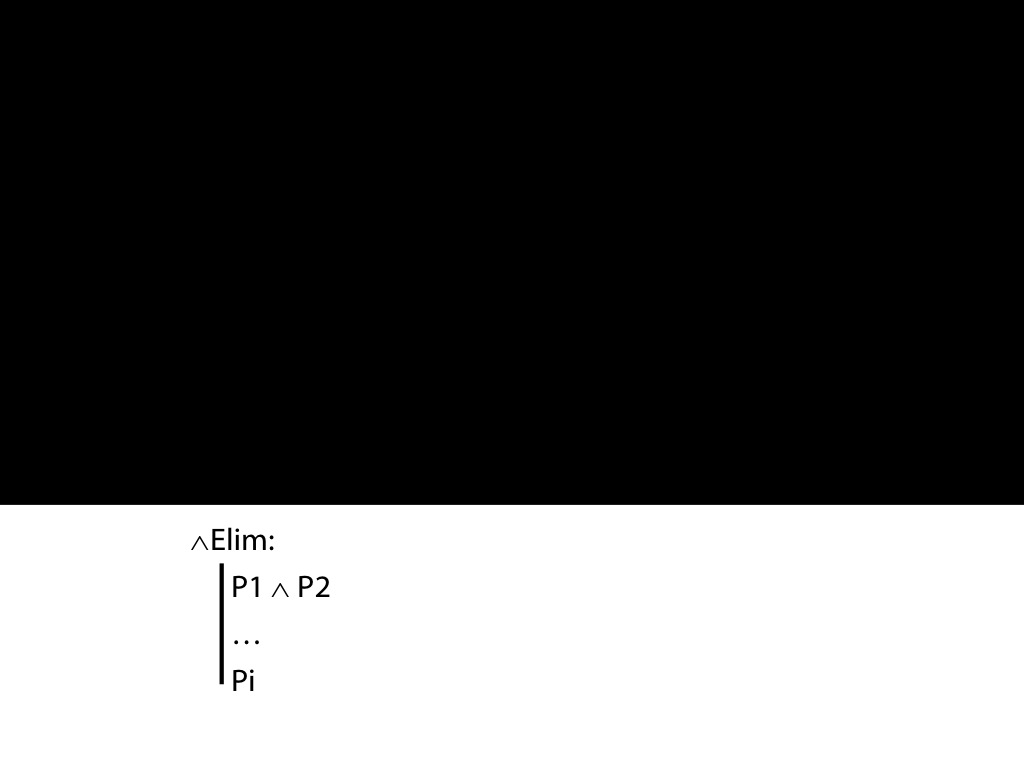
We're studying a formal system of proof called Fitch.
Here's the first rule of Fitch. It's called conjunction elimimnation.
The rule says that if you have a conjunction of two things in your proof, you can add a new line to your proof containing either one.
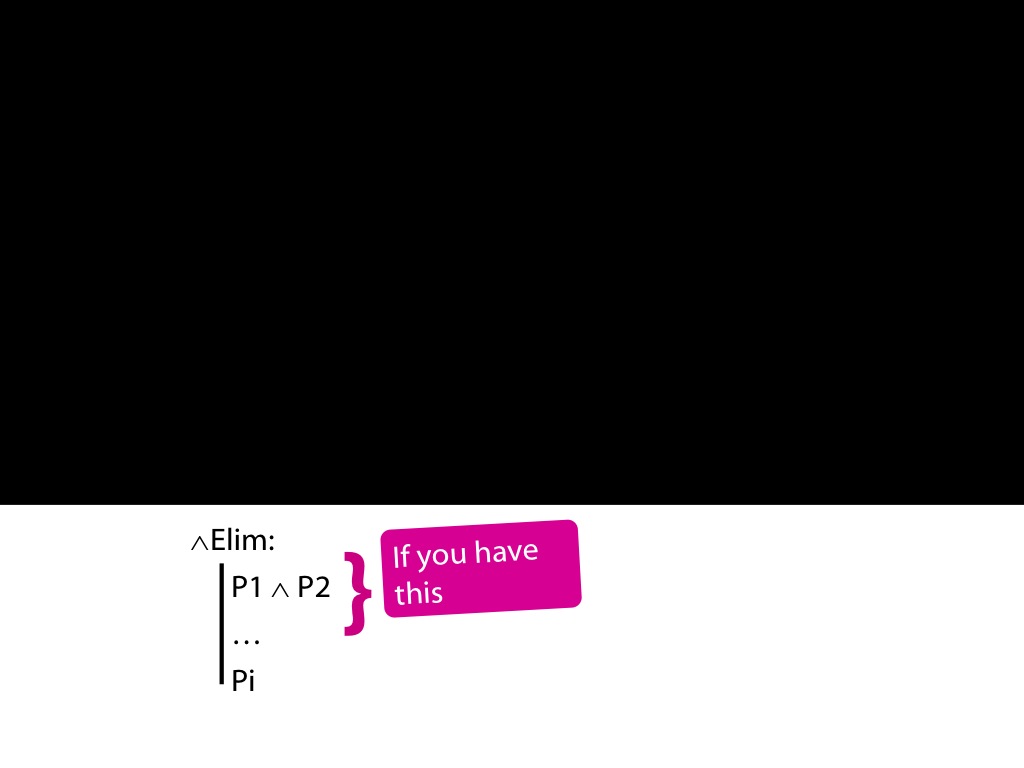
So if you something like this in your proof ...

... you can add something matching this.
I'll explain how to use conjunction elimination in a moment. First, let's look at another rule.
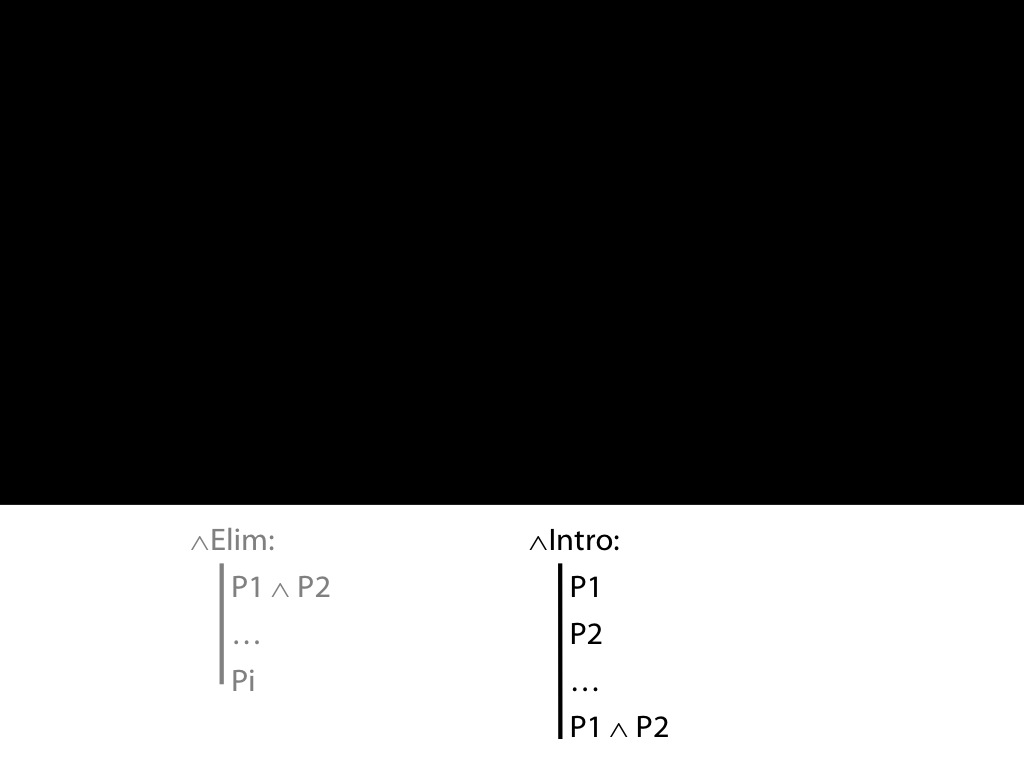
This rule is called conjunction introduction.
The rule says that if you have two things in your proof, you can extend your proof by one line to add their conjunction.
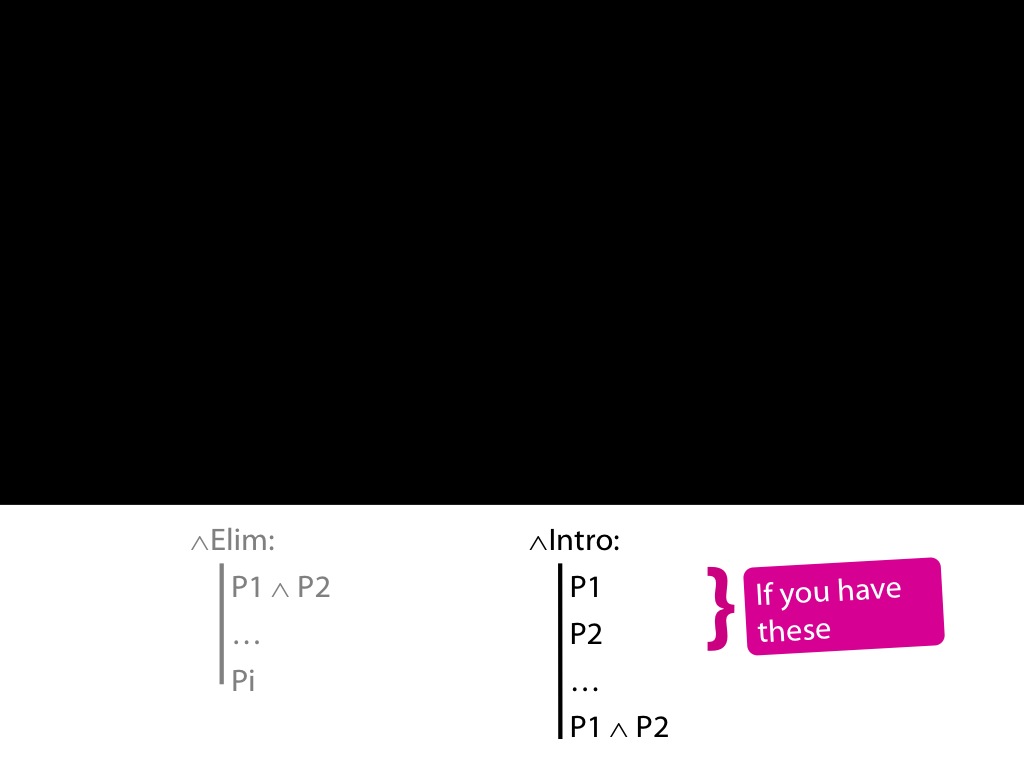
So if you these things matching these in your proof ...
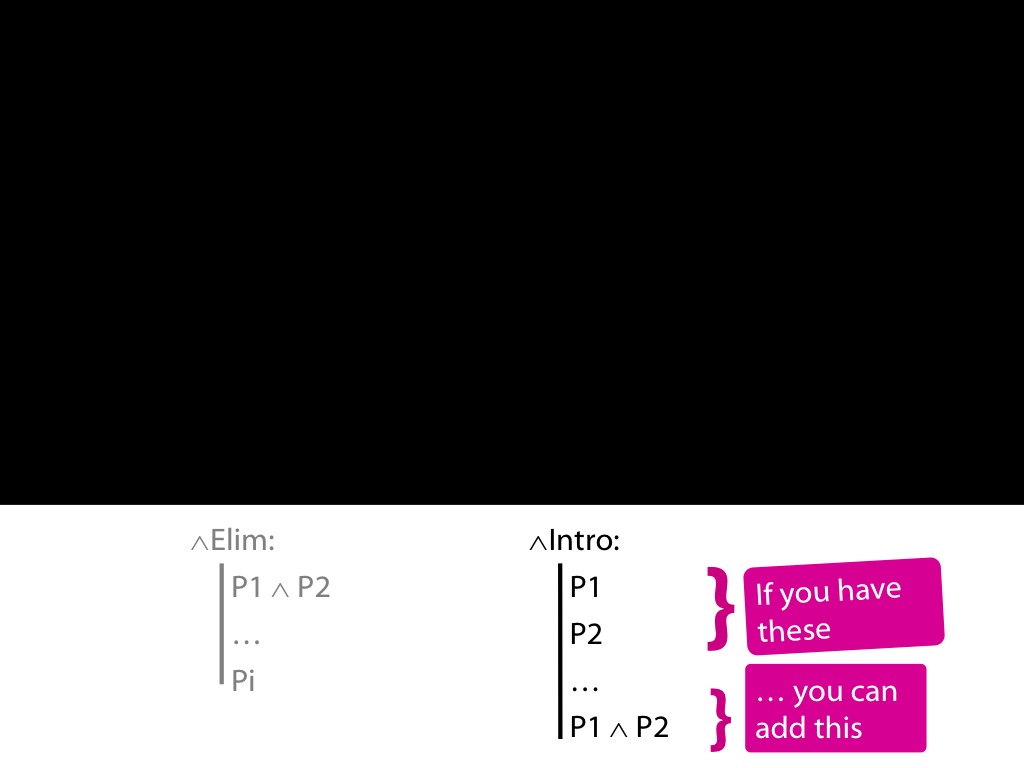
... you can add something matching this.

So let's look at an application of our rules of proof.
I want to do this by translating an argument from English into our formal language awFOL.
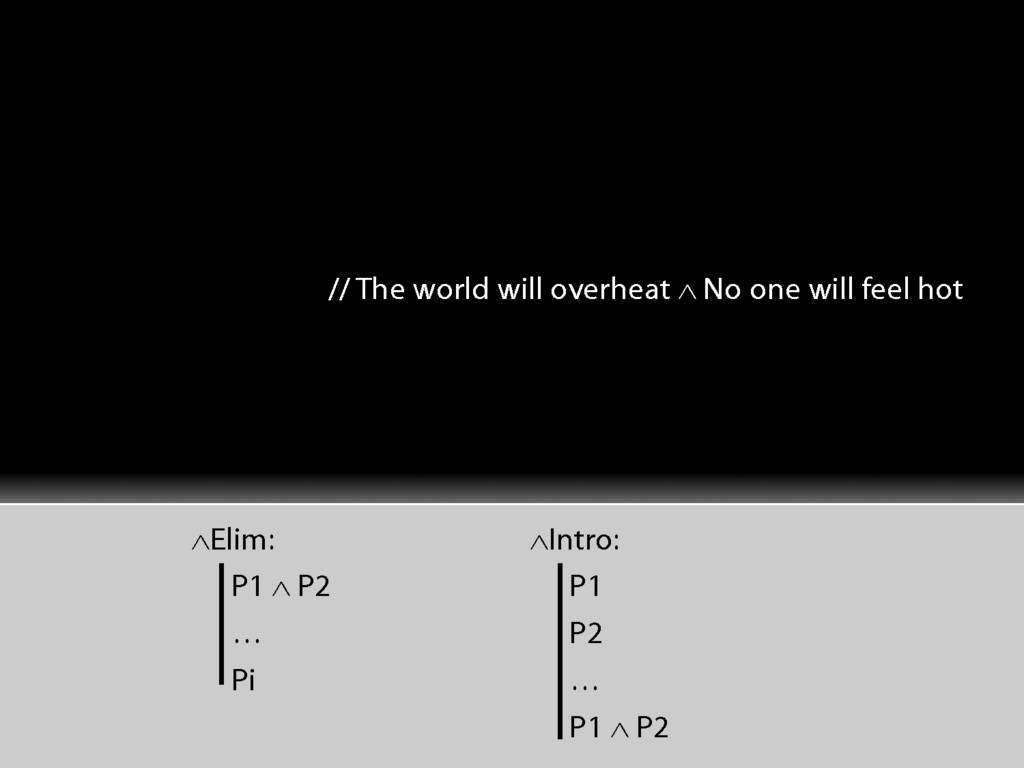
This doesn’t seem to be true.

But this does seem to be true, or at least horribly plausible.

And this seems right too, maybe.
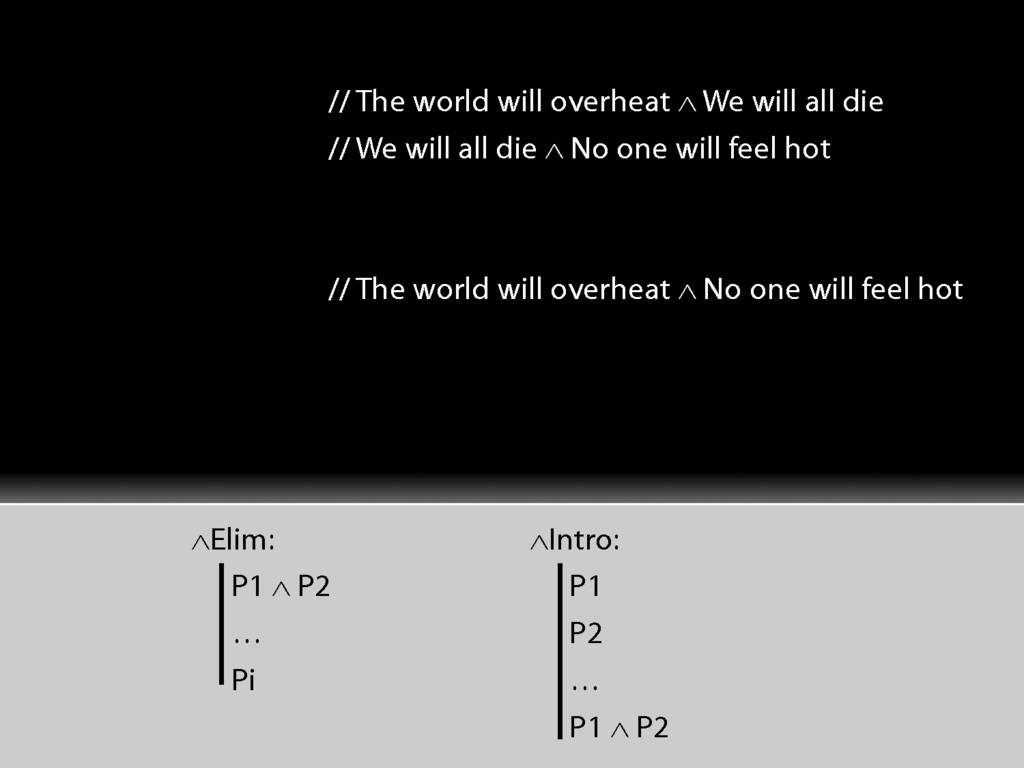
Now if we take the first two sentences as premises and the second as a conclusion, we have an argument.
Is the argument logically valid?
Apparently not because the premises are true and the conclusion false.
But look what happens when we translate it into awFOL assuming that the english 'and' means the same as the awFOL conjunction symbol, '∧'.
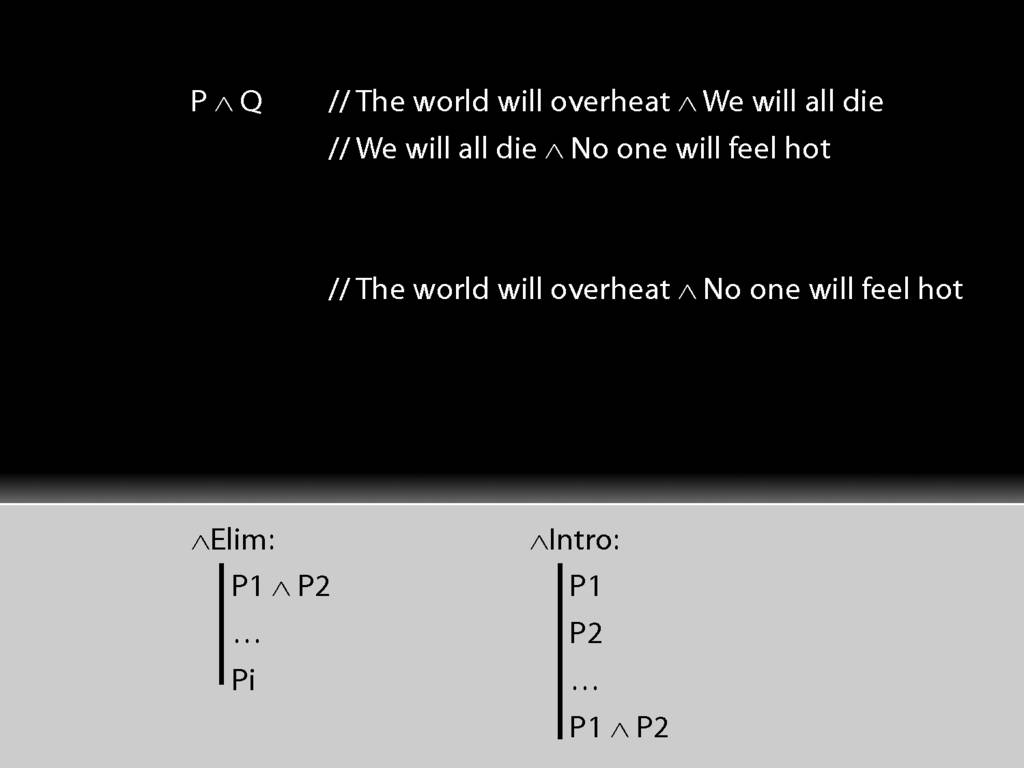
The first premise comes out as P∧Q

Where P stands for the sentence 'The world will overheat'.

And Q stands for 'We will all die'.
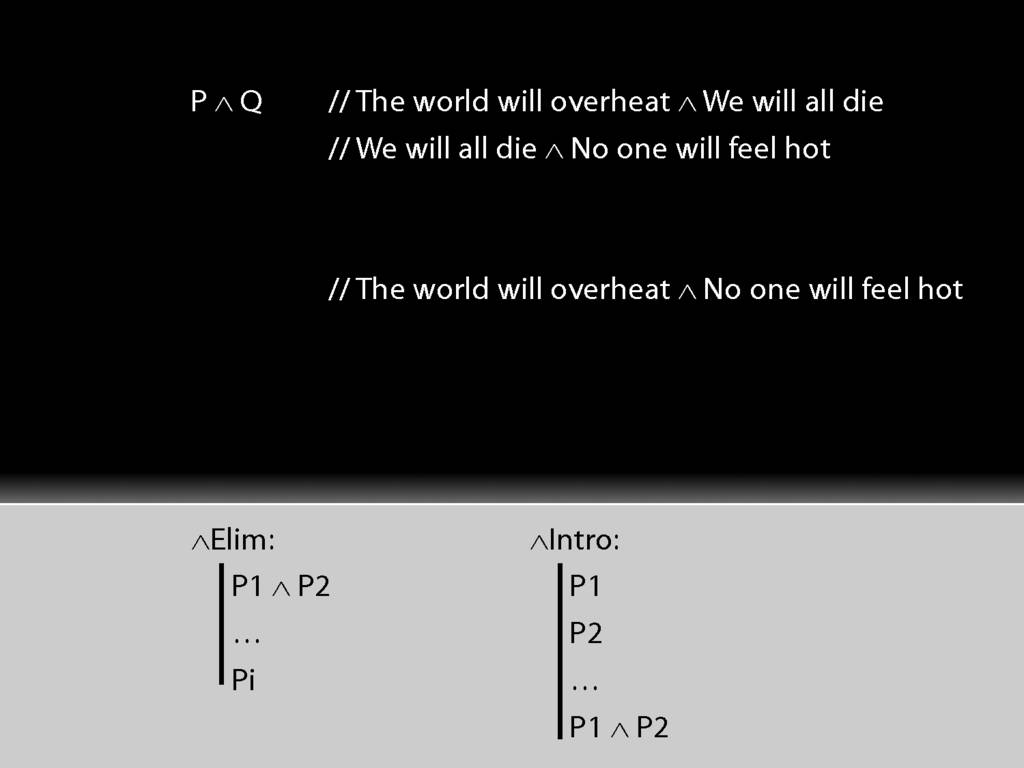
What about the second premise?
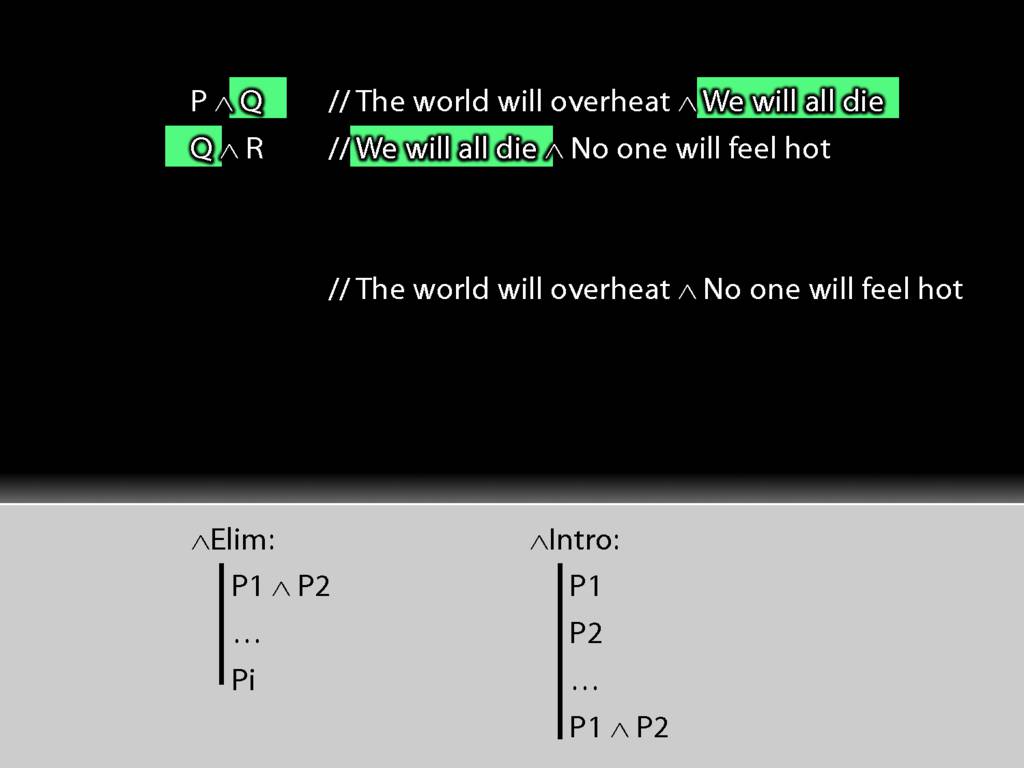
The key thing is that we're re-using Q because the sentence about the world overheating occurs in both the first
and second premises. Where we have the same English sentence, we have to use the same sentence-letter in awFOL.
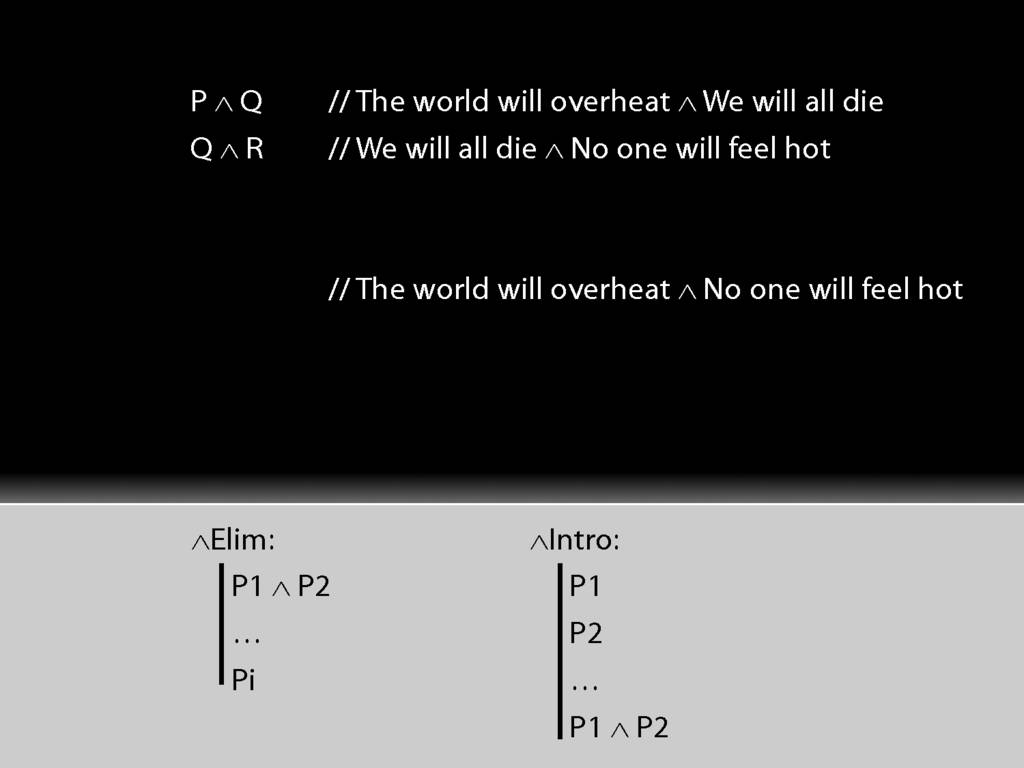
Now what about the conclusion?
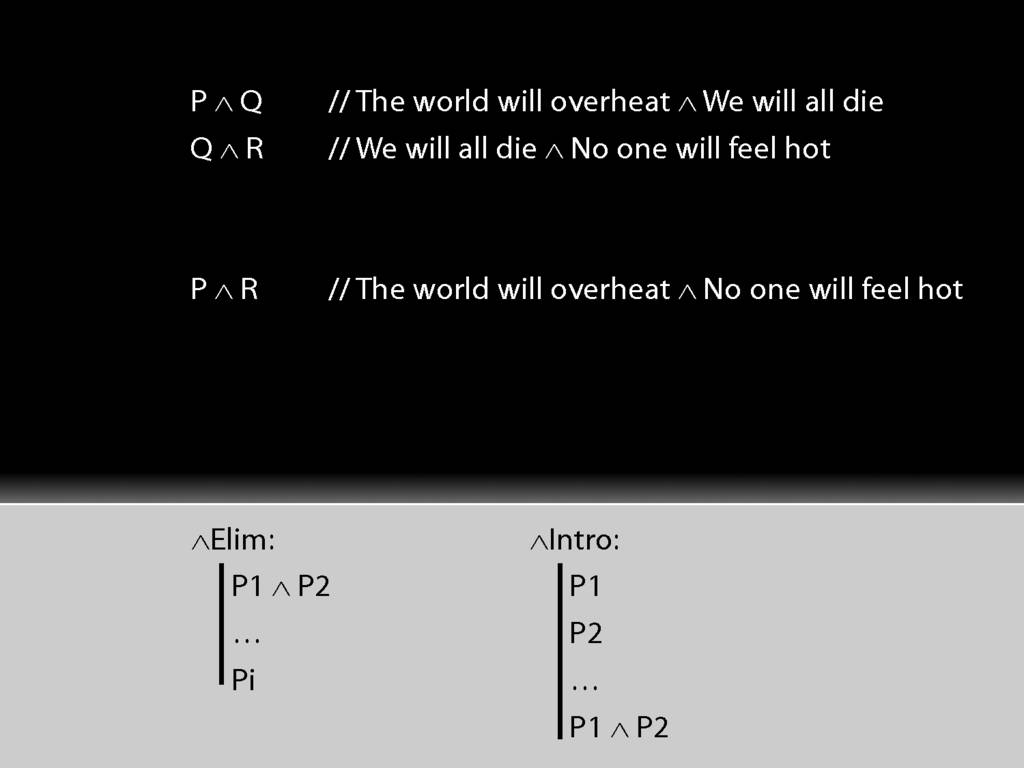
This is P∧R. Not that both sentences are already familiar.
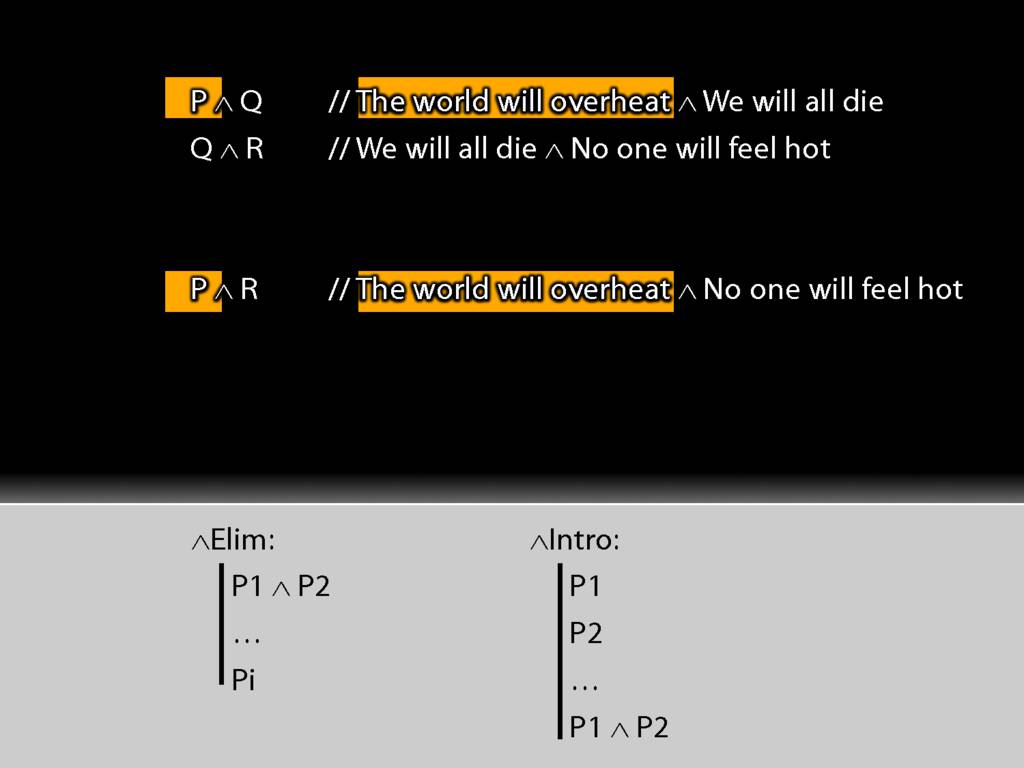
P occurs in the first premise ...
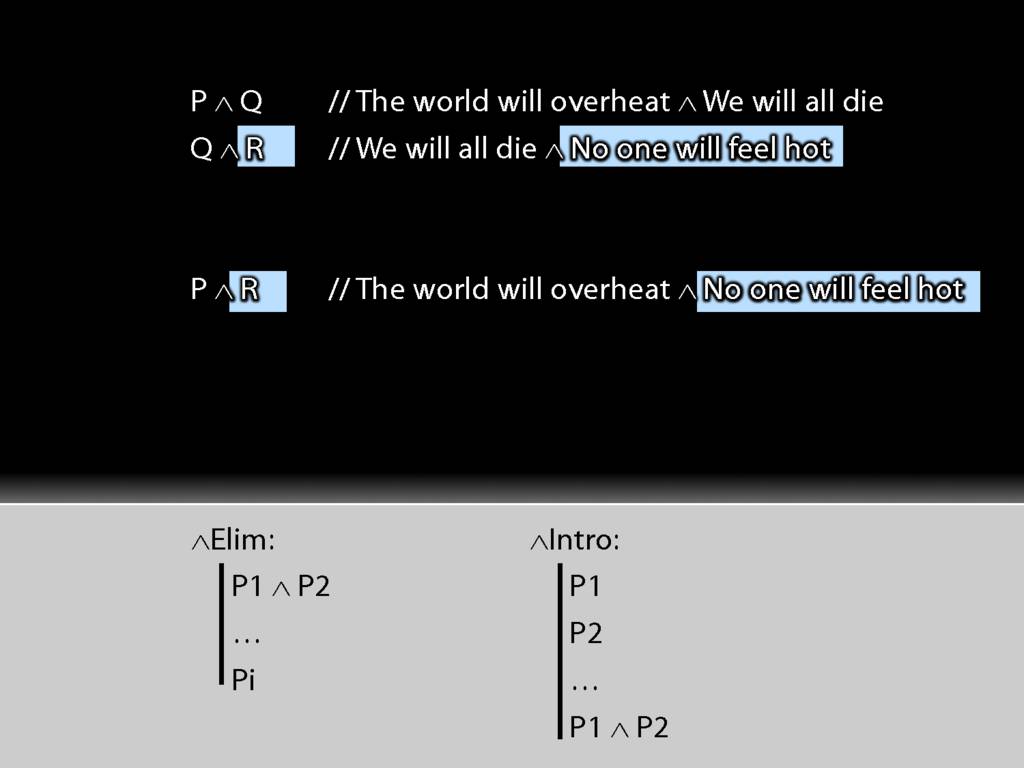
... and Q occurs in the second premise.
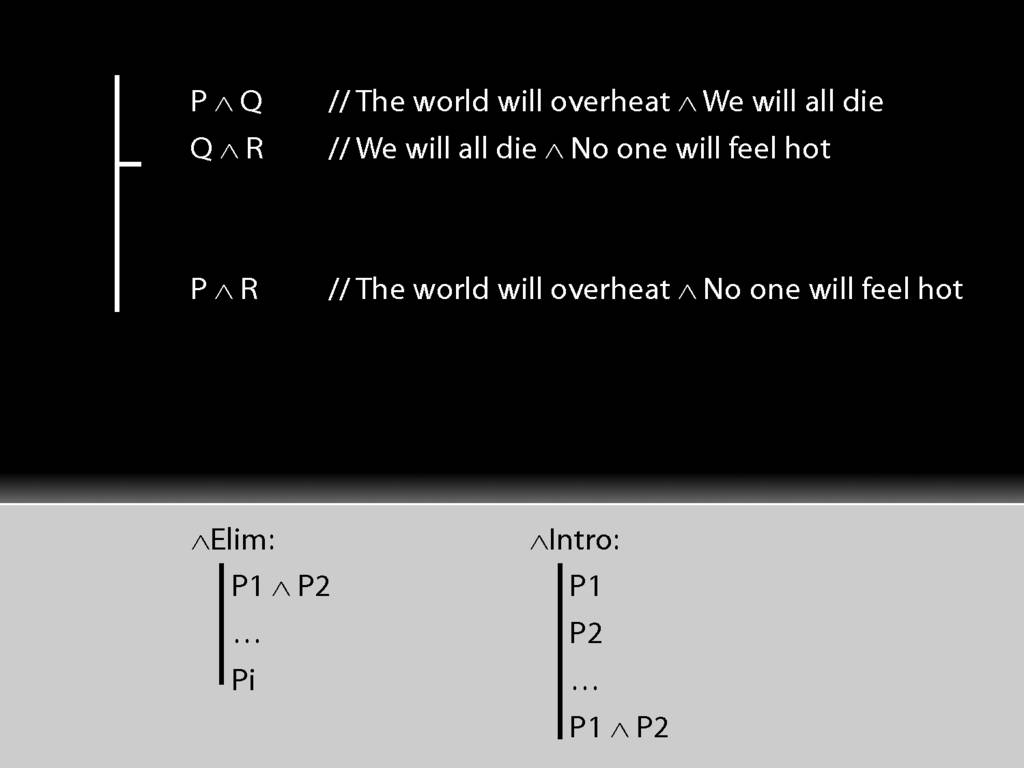
Since we're going to do a formal proof, we should use the vertical and horizontal lines.
(Surely you remember that the vertical line runs the length of the argument, and the horizontal line separates premises from conclusion.)

We also need to use line numbers.
\section{Formal Proof: ∧Elim and ∧Intro}
\emph{Reading:} §5.1, §6.1

See how we have P in a premise and P in the conclusion?
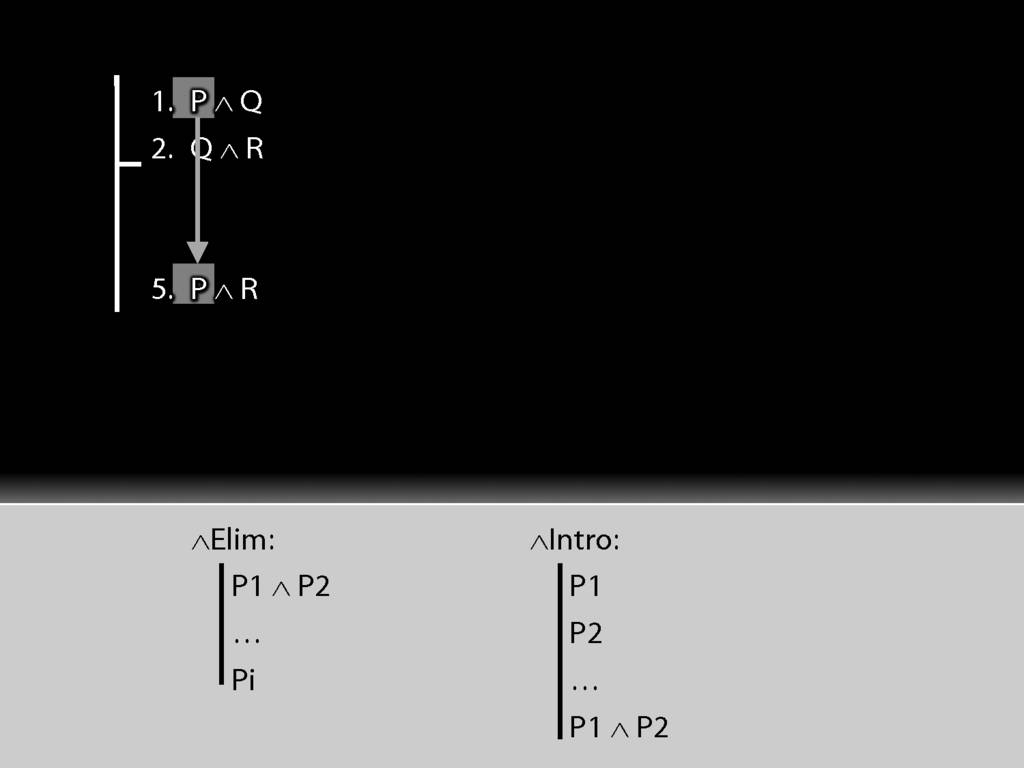
We have to get the P out of the conjunction and back into the conclusion.
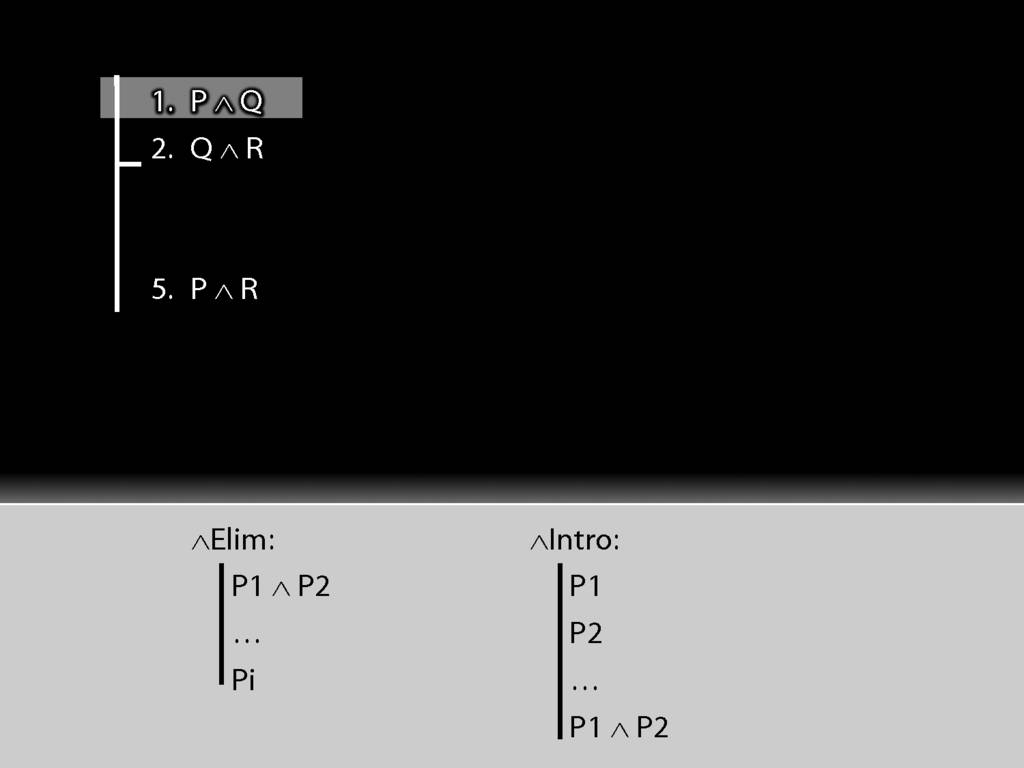
How can we get P out of this premise?

First we have to ask, What's the connective?
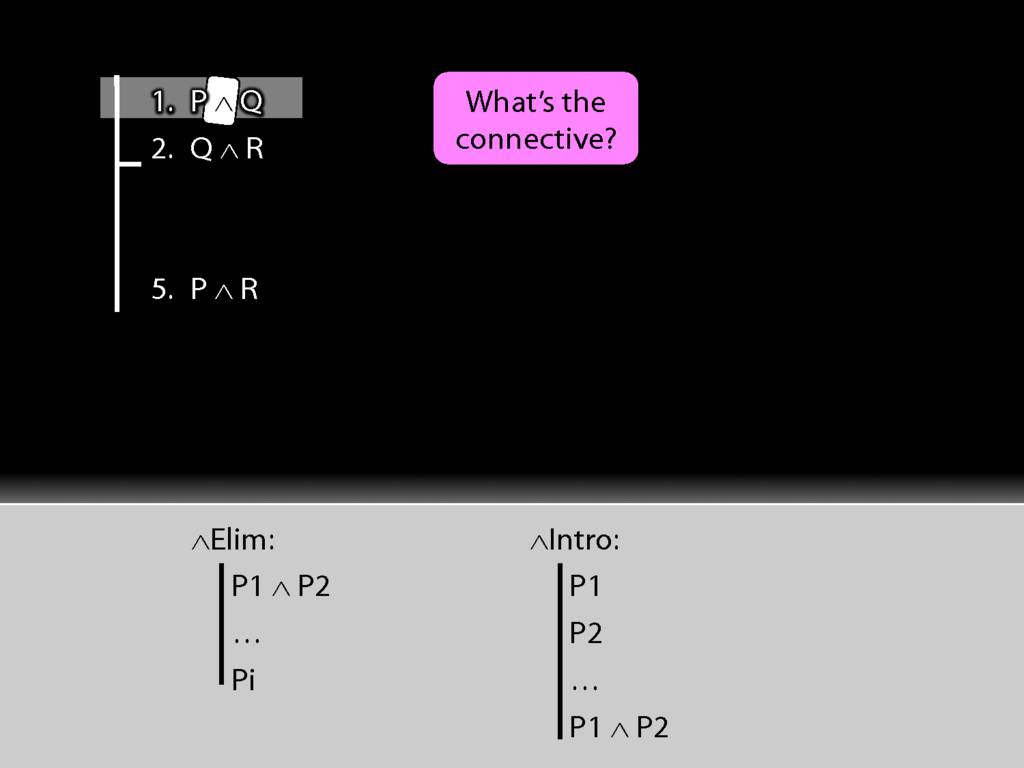
The connective is conjunction. This tells us we want to use a conjunction-rule. But is it the introduction or elimination rule that we need?

It's elimination. Nearly always we need elimination when we're acting on premises.

See how the rule matches our premise.

Because we have a match, we can use this rule to add a line to our proof.

The rule allows us to add 'P' or 'Q' to the proof, but I've chosen to add 'P'.
Now having used the rule we have to explain exactly what we've done. This requires two things ...

We must cite the rule used.
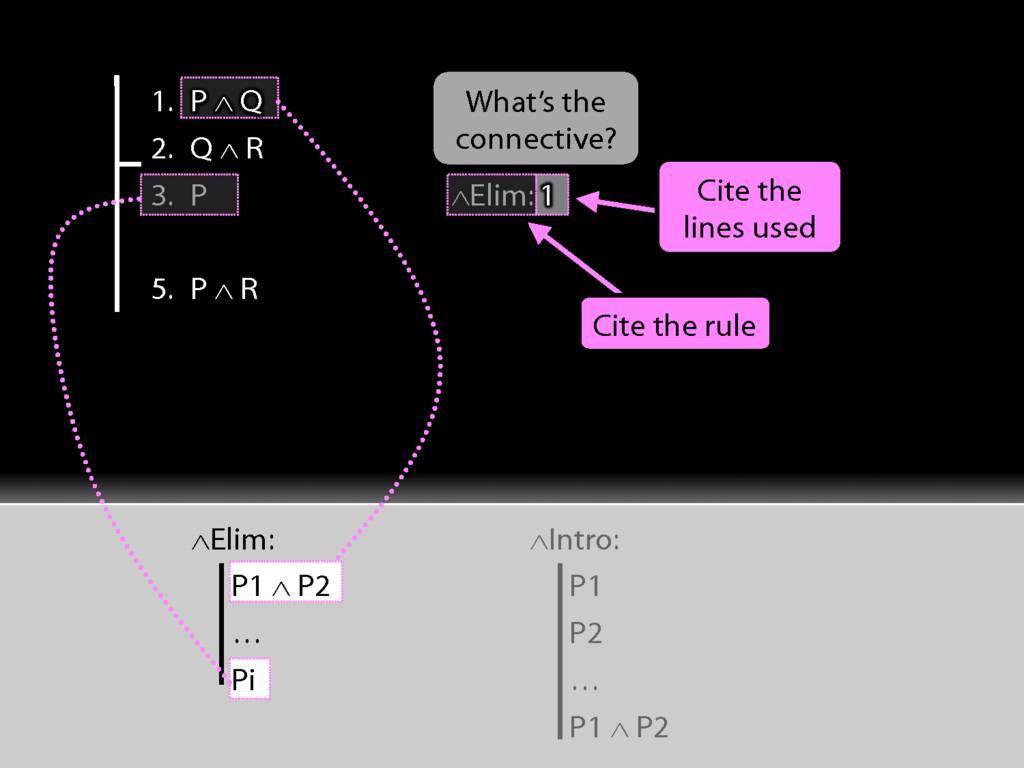
And we must cite the lines we applied the rule to.

So far so good. Can you see what we should do next?

Getting the R out of the second premise can be done in exactly the same way.
Now, how are we going to get to the conclusion?
In general, we use introduction rules to get to the conclusion. And since this conclusion is a conjunction, we'll use conjunction-intro to get to it.
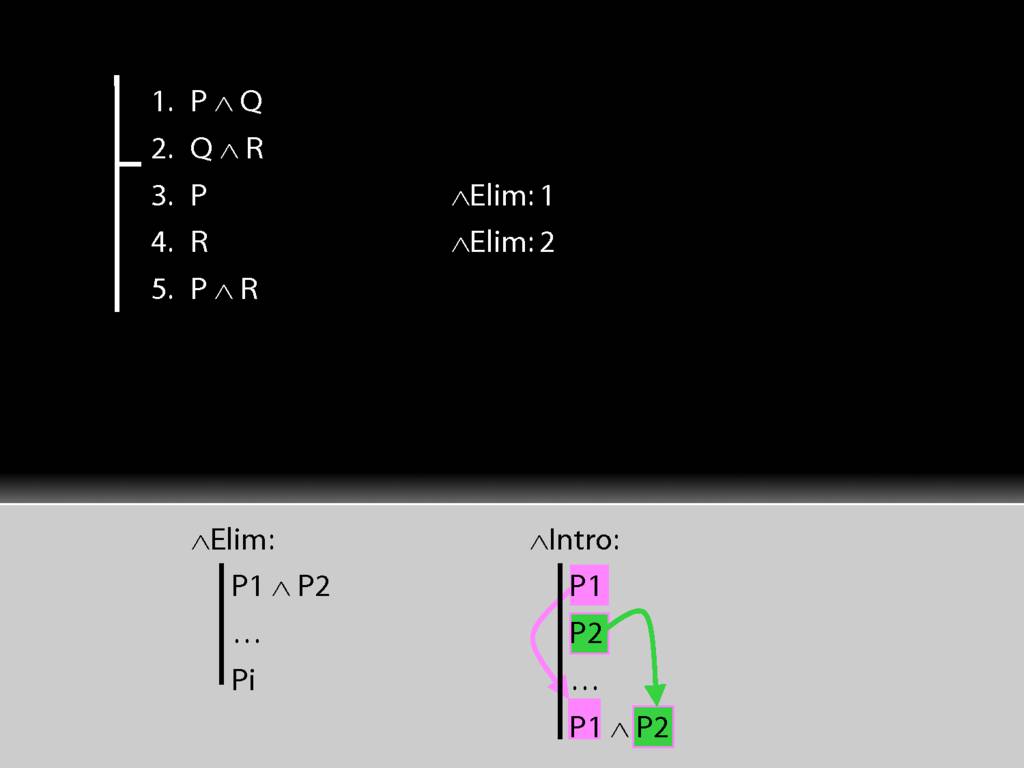
Look at the rule for conjunction intro.
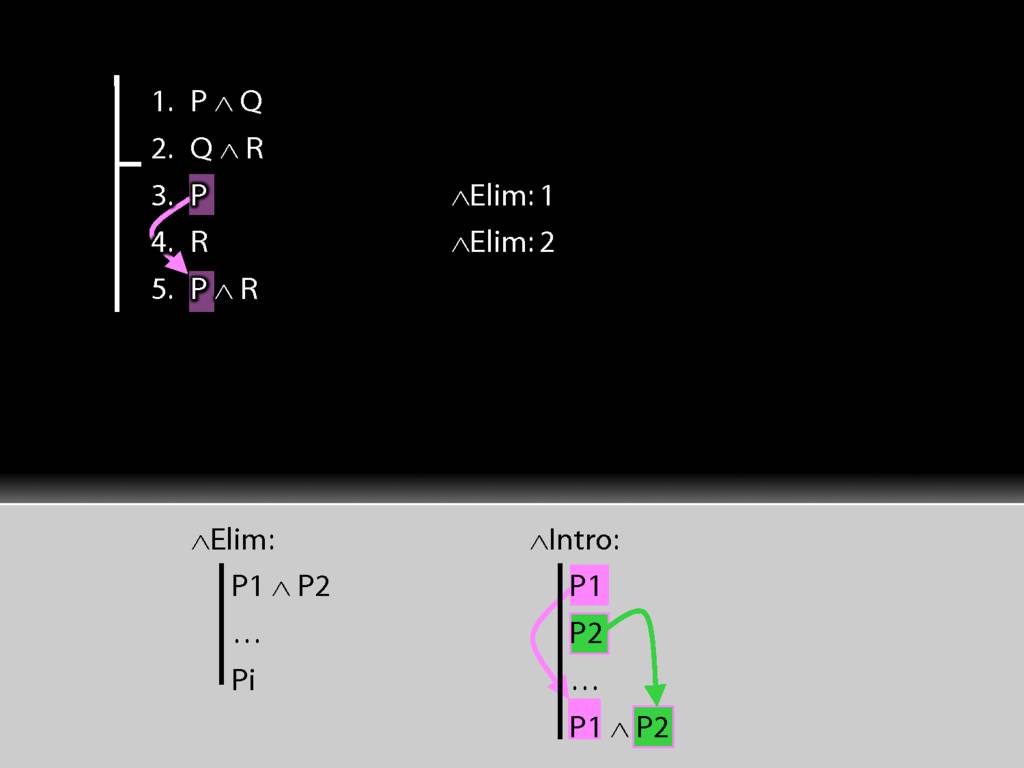
See how our proof fits the pattern of the rule.
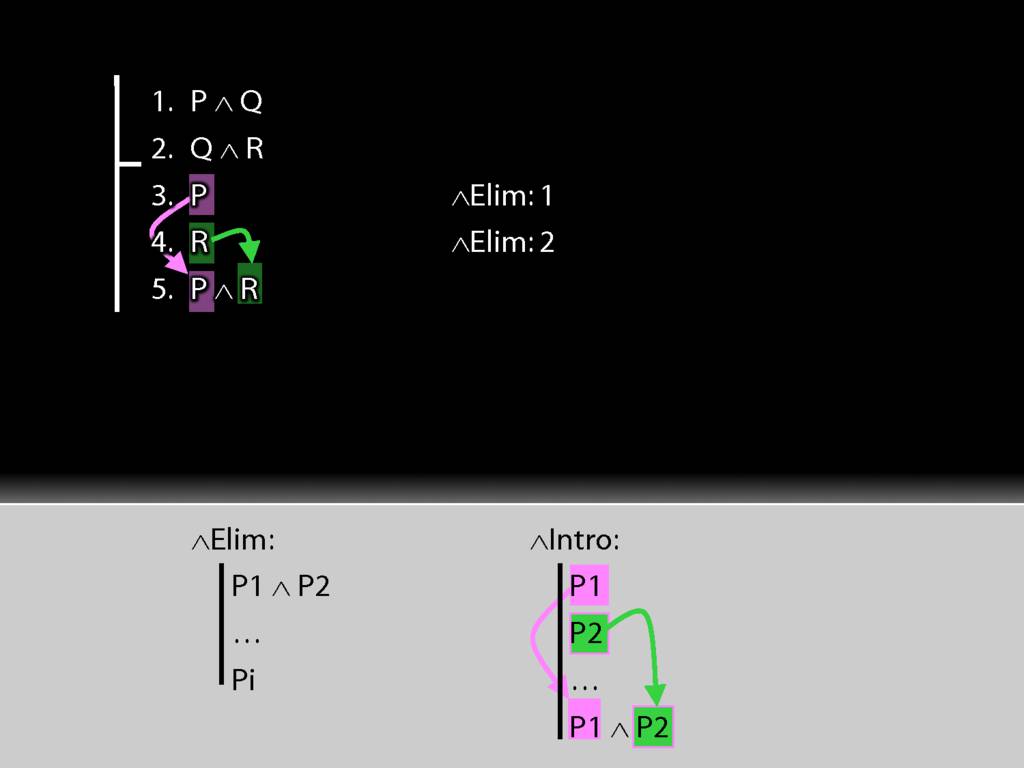
So it turns out we already did what we need for conjunction intro.
All that's left is to explain what we've done. As before this requres two things.
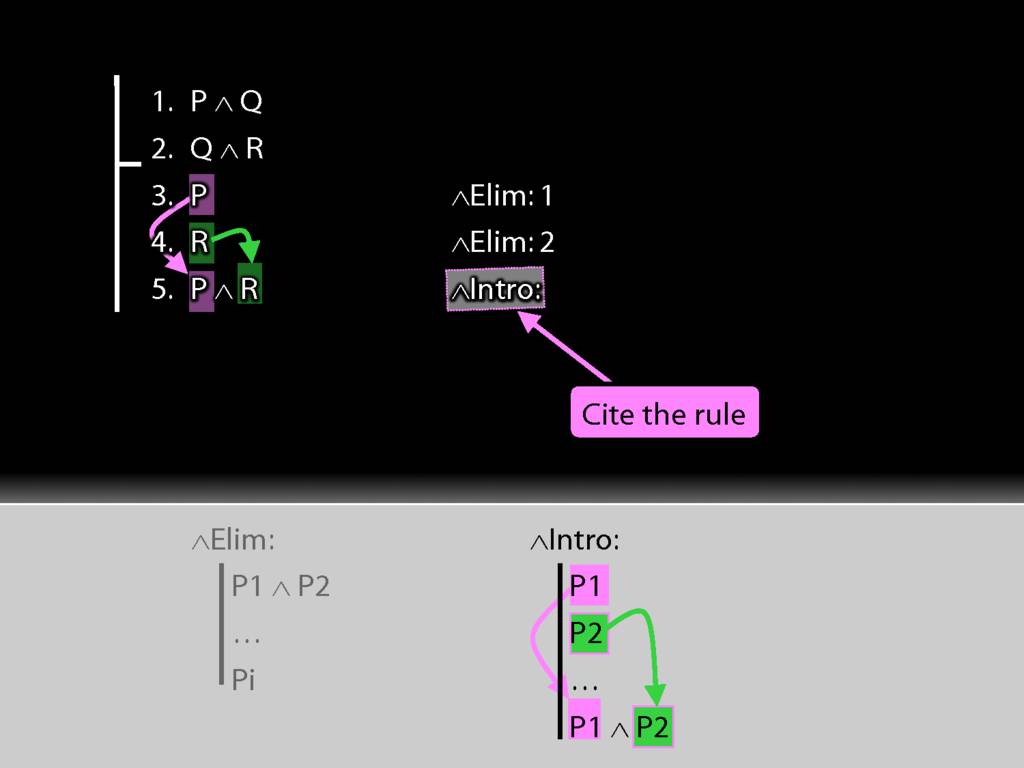
We must cite the rule used.
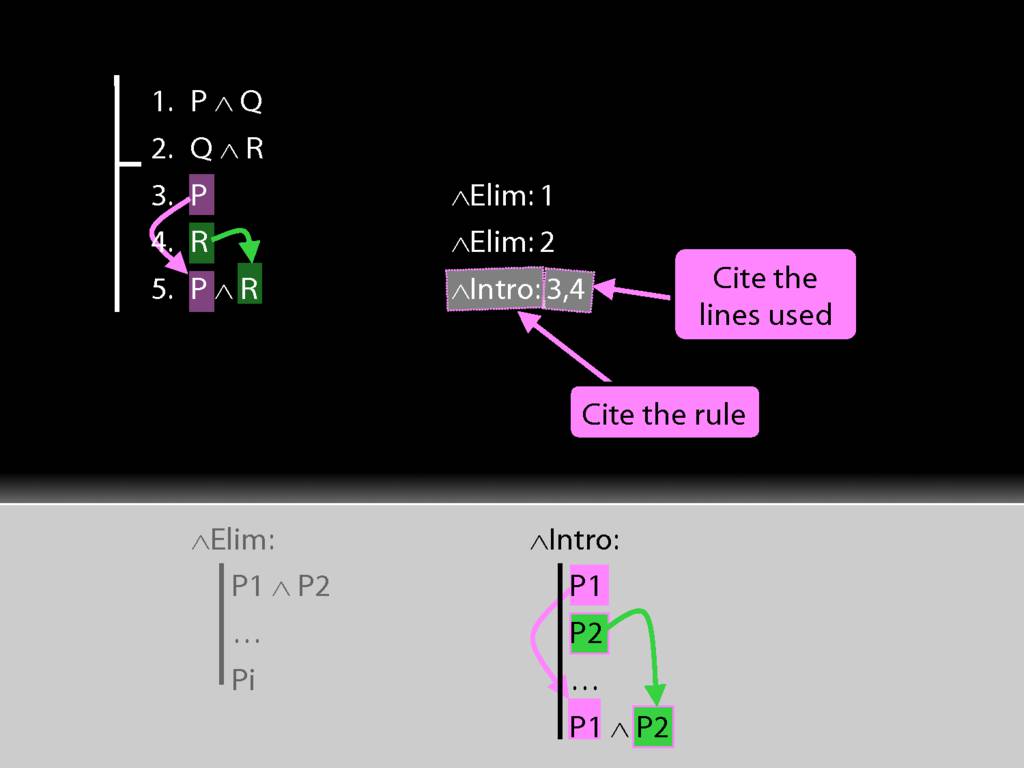
And we must cite the lines we applied the rule to.
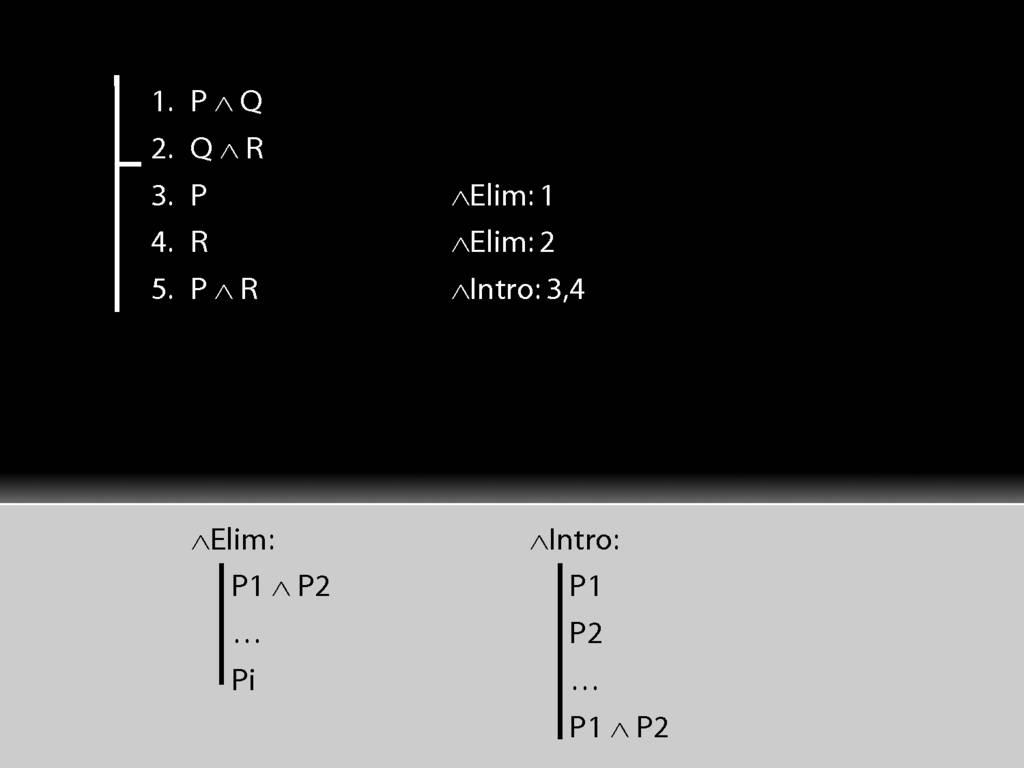
Note the pattern of rules that we have for conjunction: introduction and elimination.
For each connective we'll have such a pair of rules, one introduction rule and one elimination rule.
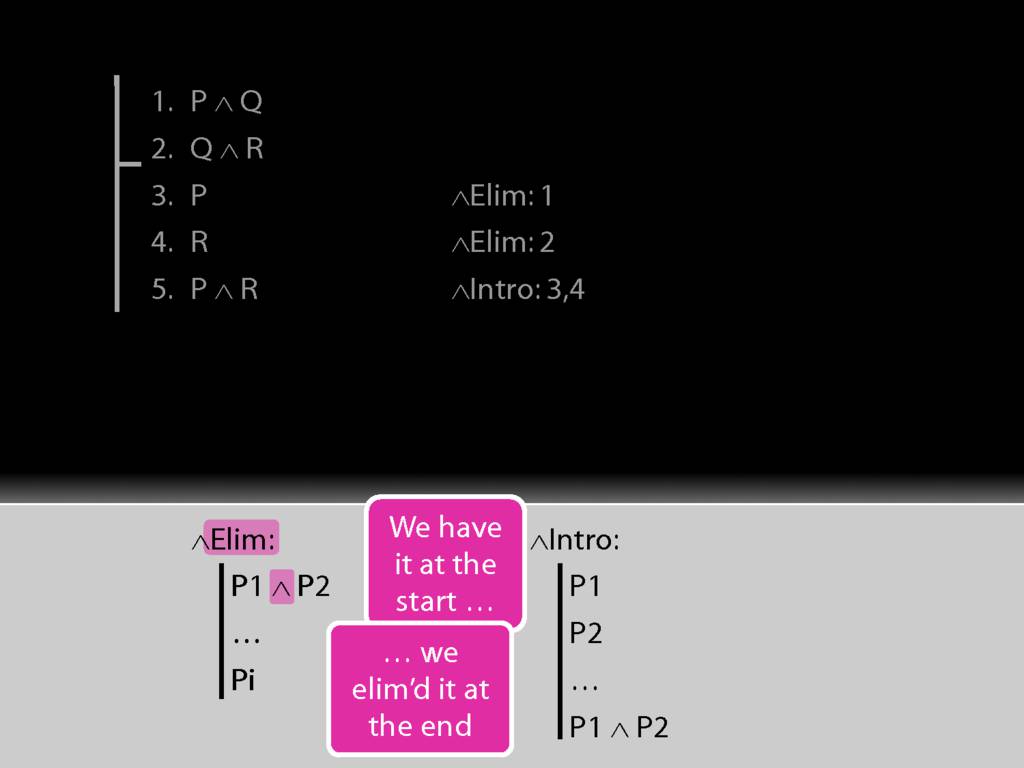
With the elimination rule, we have the connective at the start and we eliminate it in applying the rule.
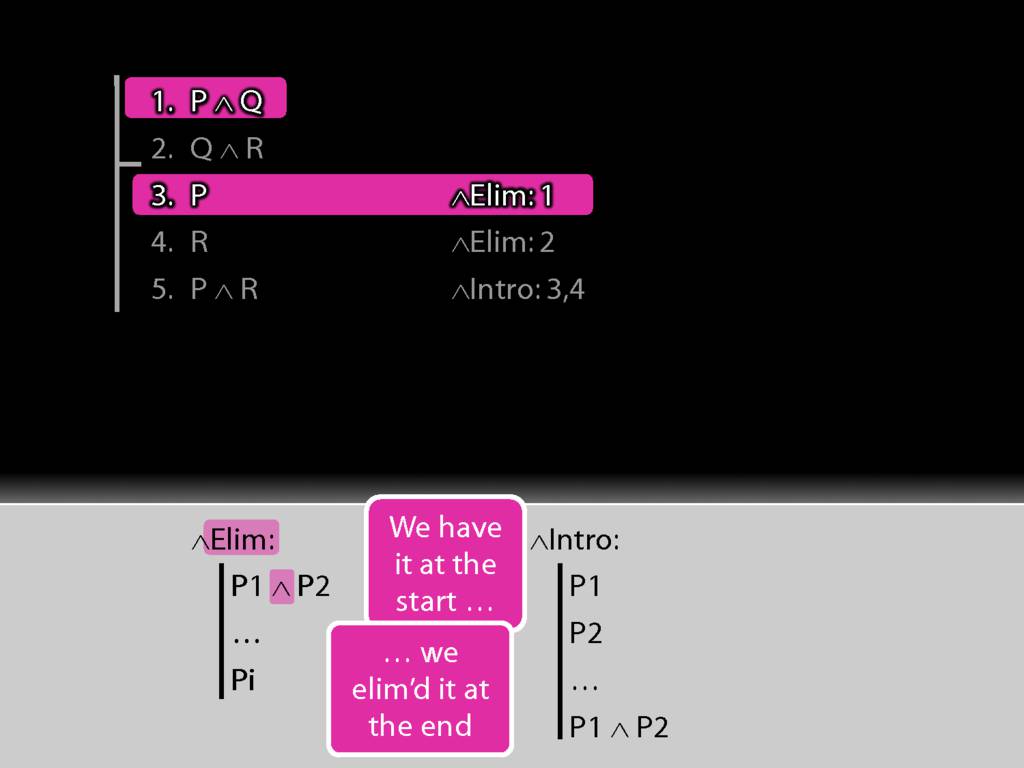
See how this worked in our proof.
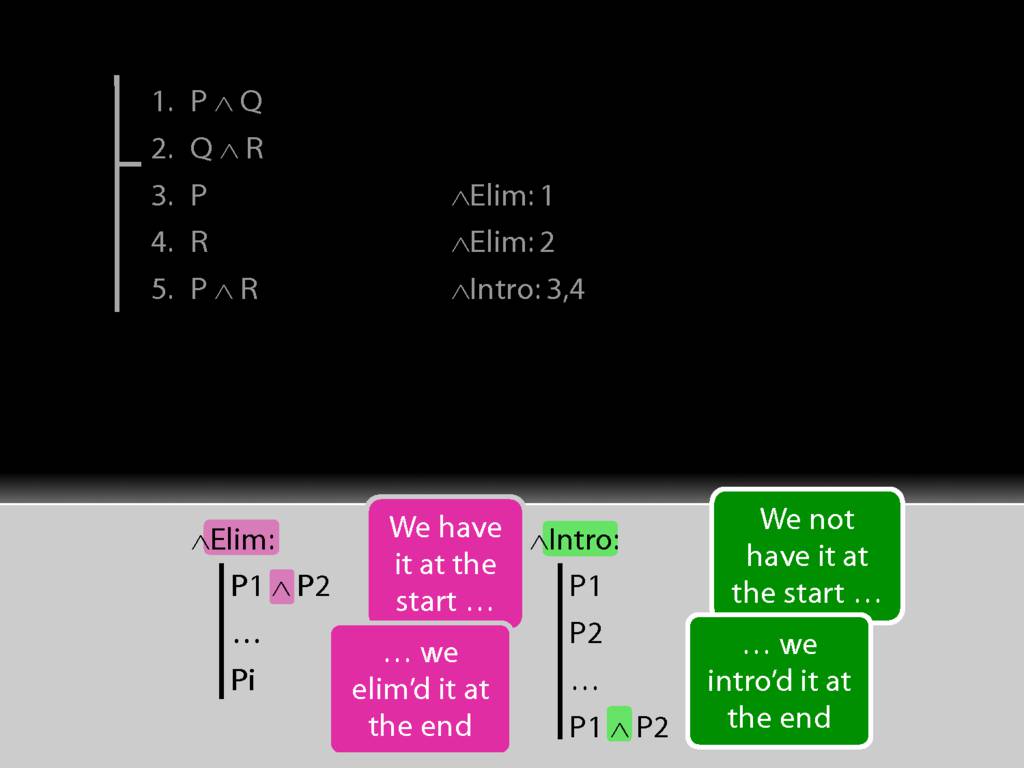
With the introduction rule, we don't have the connective at the start and we introduce it by appling the rule.
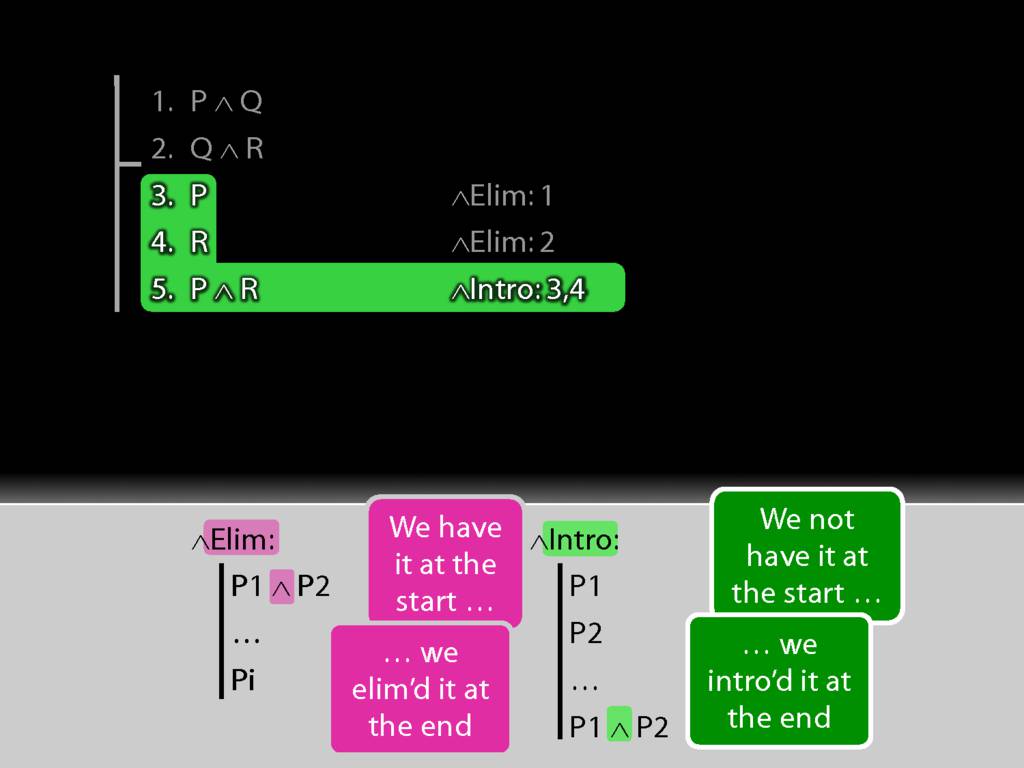
Here's how we did it in the proof.
If you've been following all this, you know everything you need to know to use conjunction intro and conjunction elim in proofs.
You also know how to do Fitch proofs. The rest is just a matter of learning more rules.
Now it's possible you haven't entirely been following all this ...

... When I was learning logic, I often didn't immediately understand the lectures and needed
to go back over my notes after each lecture.
Hopefully you will do the same because I don't really have the patience for spoon feeding.
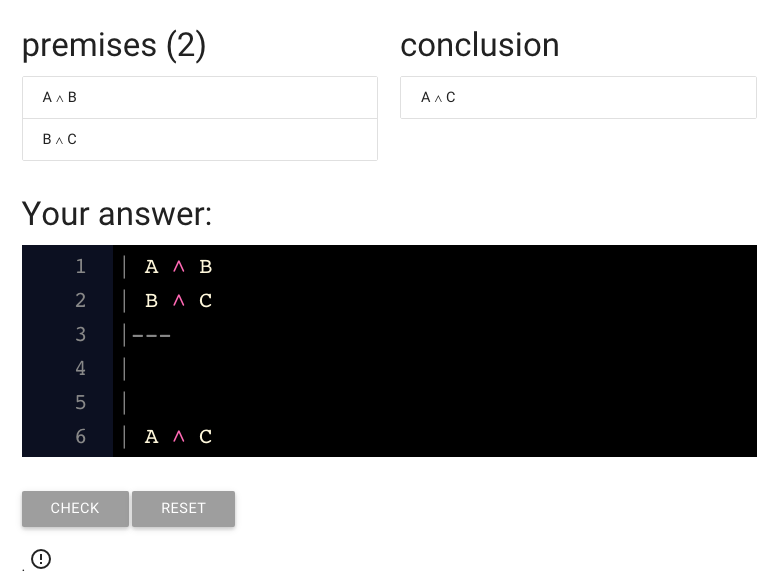
When you start an exercise, you’re already given the basic form of
the proof, with a couple of blank lines.
The box you’re working in is just a text editor.
You can add lines by pressing ‘return’ and delete lines
just like you would in any text editor.
To repeat: the proof is just some text that you edit in the normal way.

We just need to a step here.

I’ve gone ahead and typed A because we need to derive A from the premises.

This red dot suggests that there is a problem with the line.
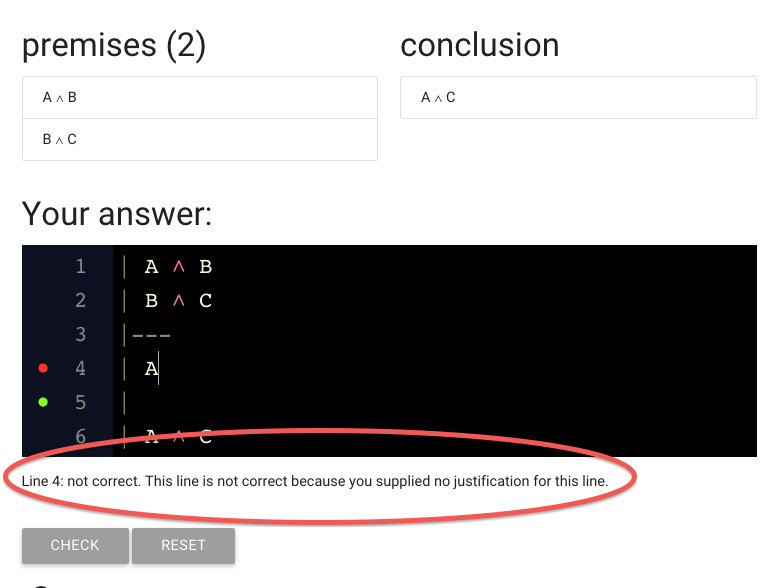
The text under or proof is giving us a clue: we didn’t justify the step yet.
Let’s do that now.
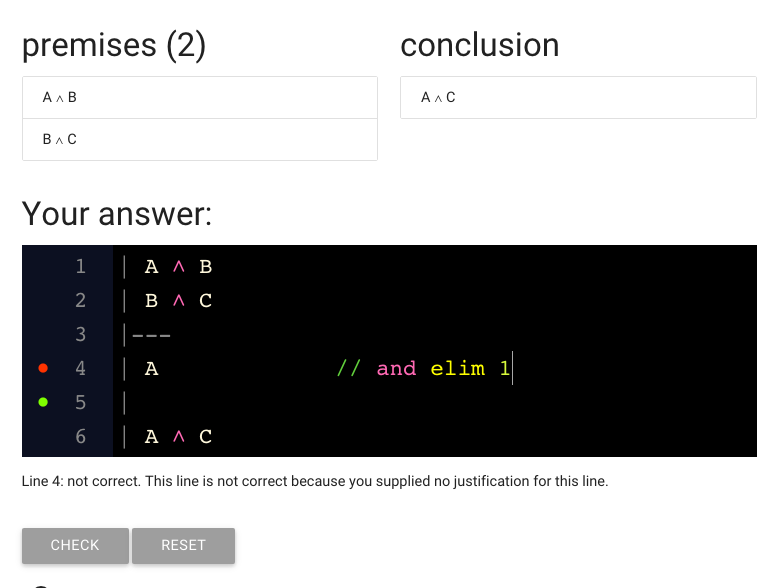
Here I’ve added justification.
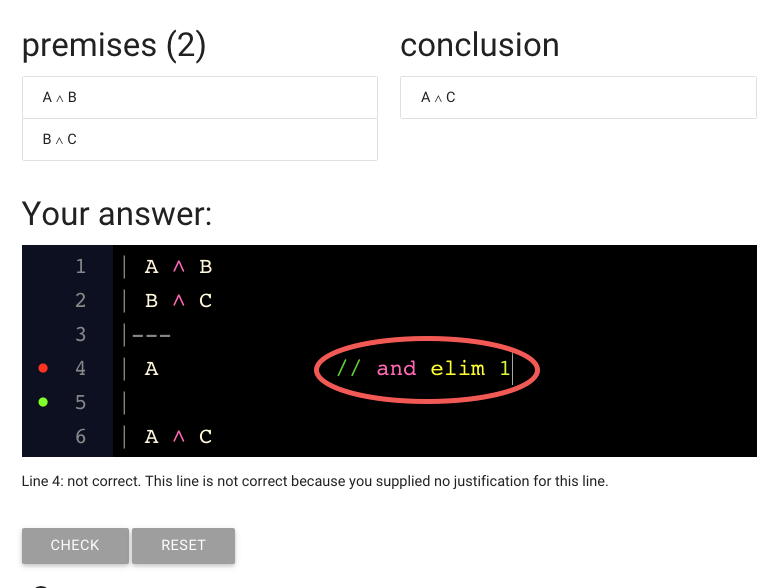
It’s over here on the right (I just added spaces to move it away from the sentence ‘A’).
I want to mention a couple of conventions.
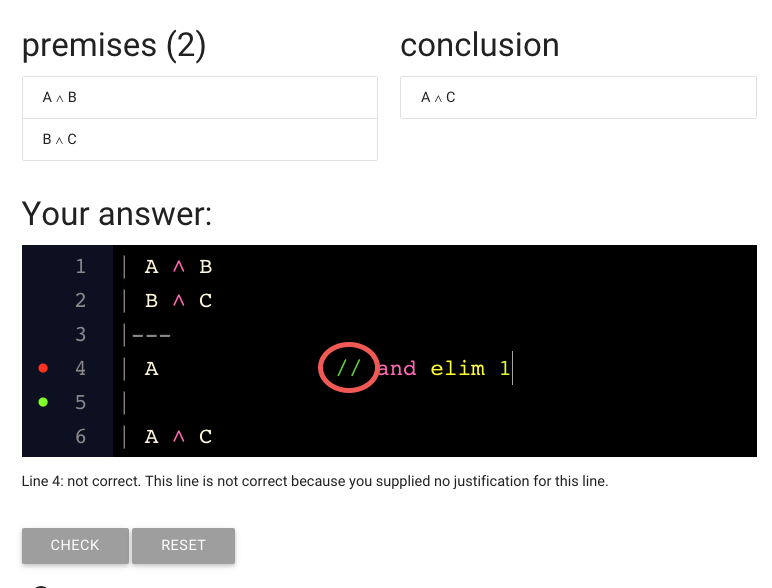
First, justification needs to start with ‘//’. This is to separate justification
from the sentence itself.
If you forget the ‘//’, zoxiy won’t be able to understand your proof and won’t
be able to explain to you what went wrong.
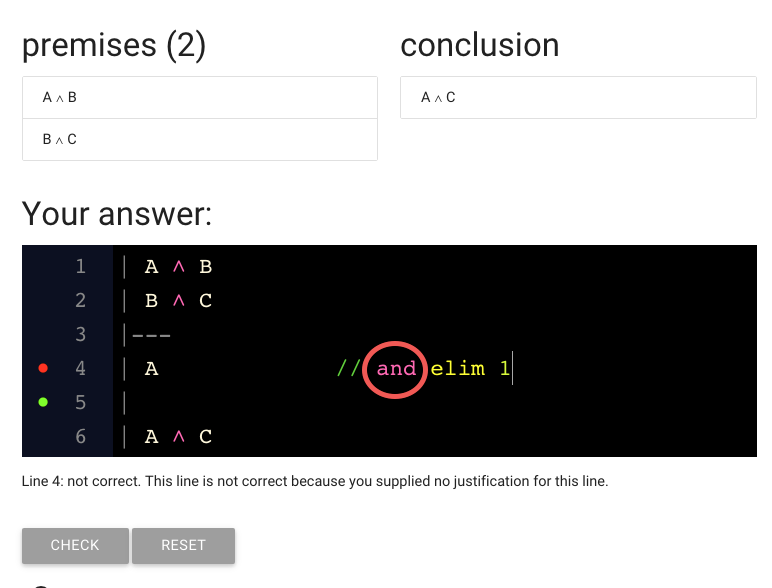
The next thing to note is that I typed the word ‘and’ rather than the symbol
for conjunction (‘∧’). As a convenience, zoxiy will let us use words
rather than making us type symbols. But we can type the symbols if we prefer.
The same is true when we’re writing sentences: you can type ‘A and B’ instead of
‘A ∧ B’ if you like.
This is a handy feature of awFOL vs the language of the textbook we’re using.
awFOL let’s you use words where really there should be a symbol, just to make
it easy to type things.
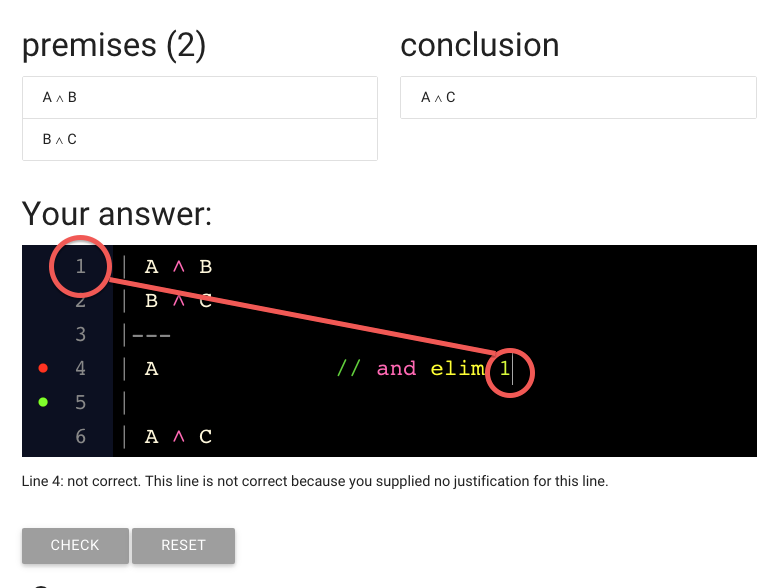
Finally, note that we put a number at the end. This is the number 1,
which refers to the first line.
zoxiy provides line numbers for us (you can add your own
if you prefer, but then you have to be really consistent about
starting each line with a number).
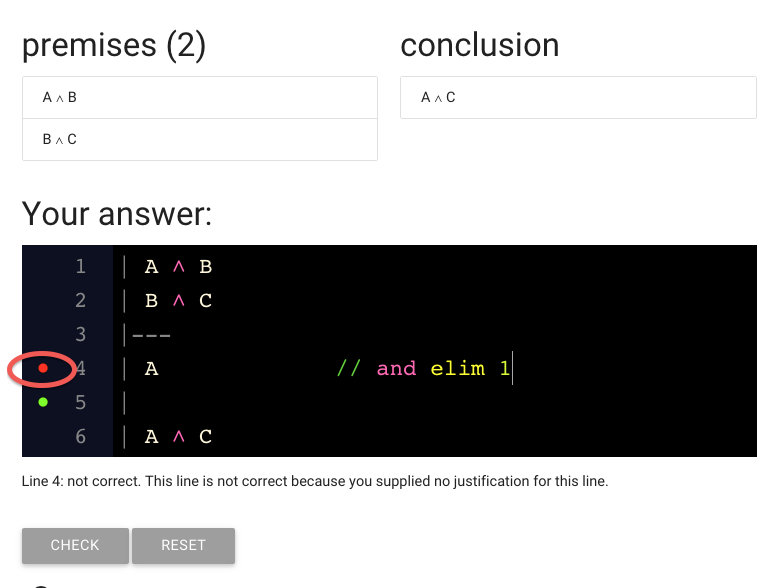
Wait a minute. We still have that red dot and the error message
telling us our line is not justified. But we have added the justification.
What’s going on?
zoxiy might be a bit slow to update. In this situation, just move your
cursor up and down to get zoxiy to check your line again.
Let me do that now ...
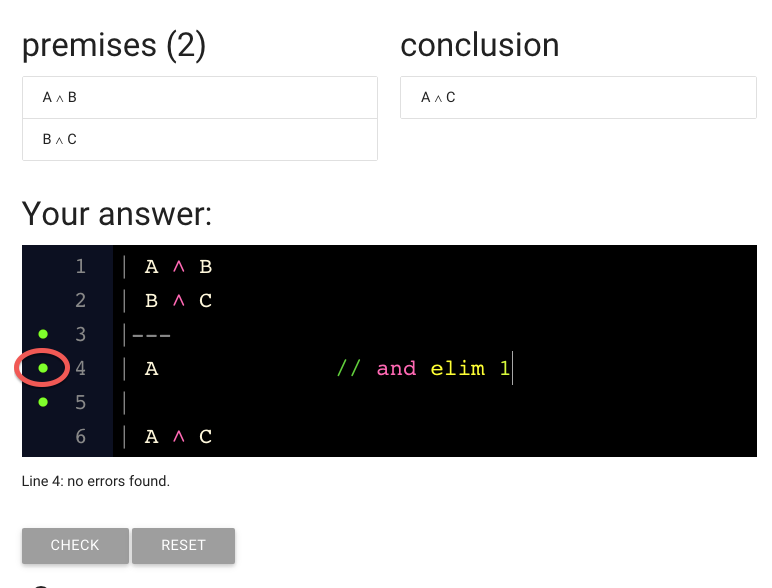
... and the dot has turned green, indicating that this line is ok.
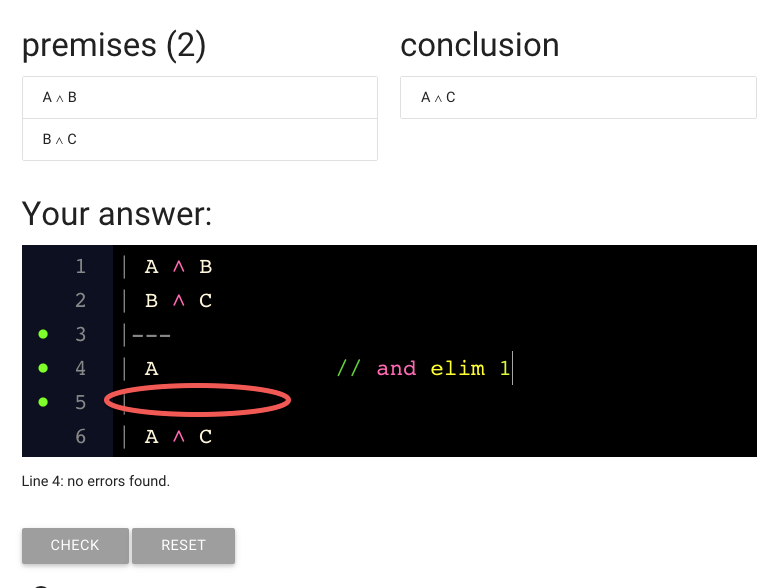
We need to add another step to the proof.
(It just happens that we have the right amount of space for this proof,
but generally you are going to have to add lines to your proof. Do this
with the return key, as mentioned above.)

Here I’ve added the setntence we need (‘C’).
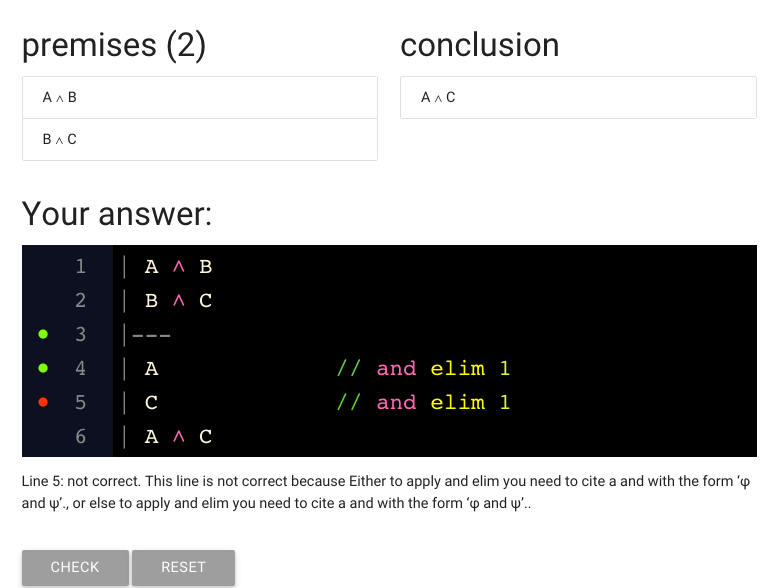
And here’s the justification as well.
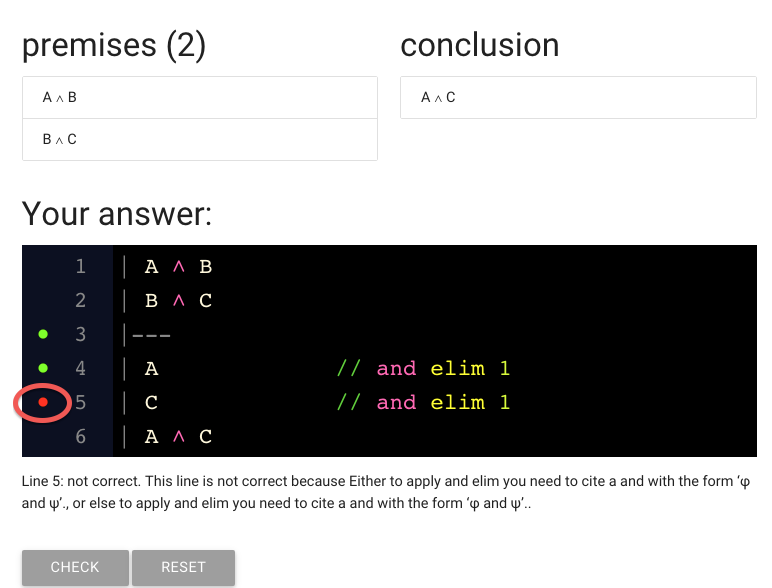
But wait, the red dot is back.
That means there’s something wrong with the line.
What has gone wrong?
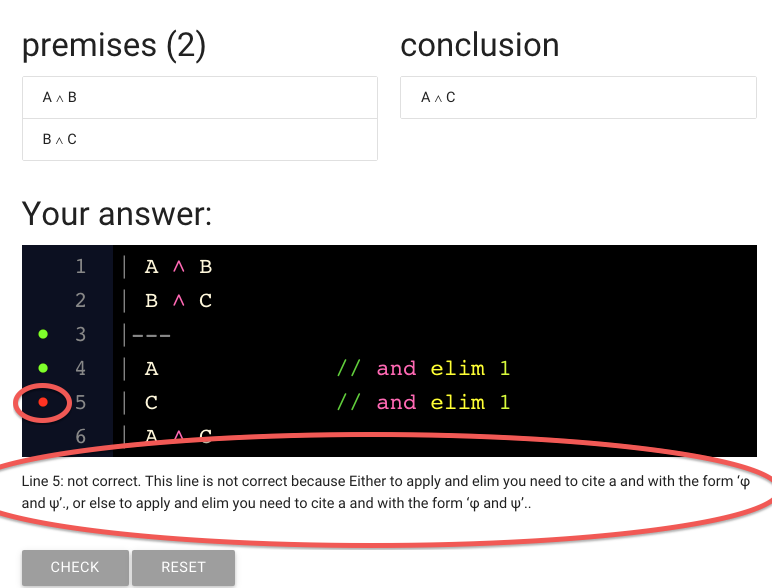
The status message is really unhelpful in this case, as it often will be.
(Maybe it will be improved at some point.)
Sorry about that.
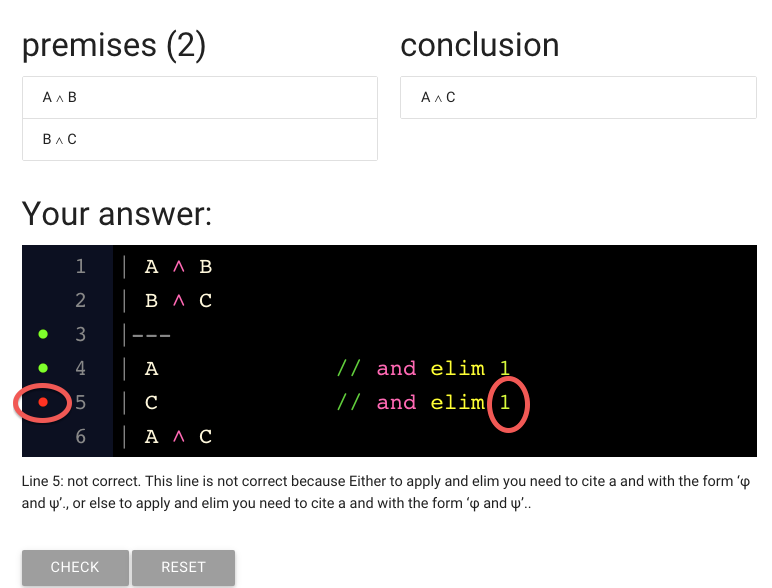
What could have gone wrong? Note that we’re citing line 1.

So let’s have a look at line 1.
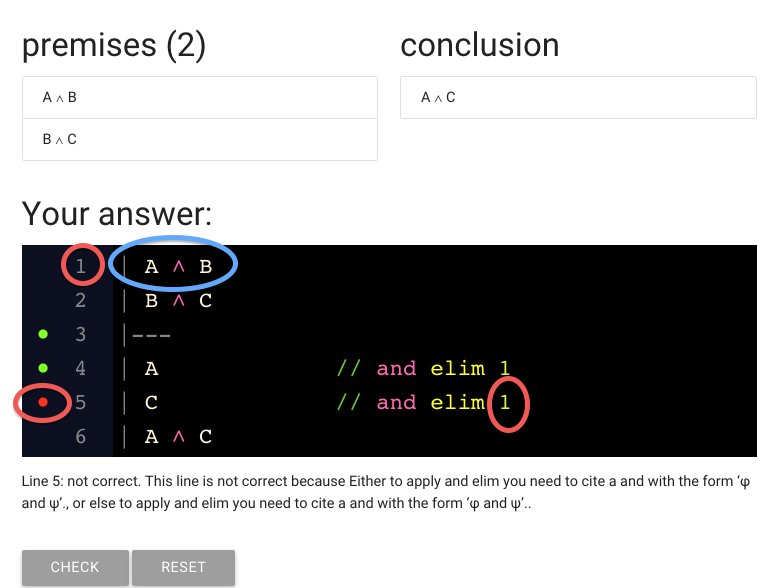
This line contains ‘A and B’.

But actually we’re trying to derive C.
And you can’t derive C from A and B.
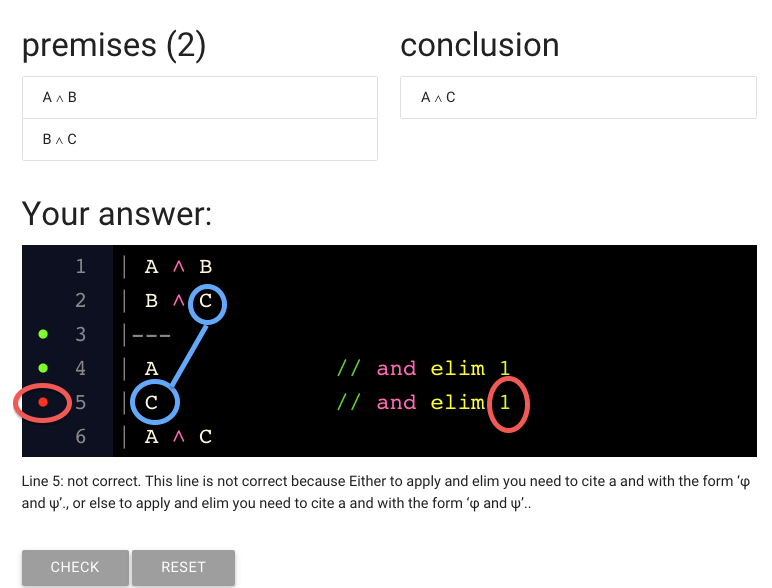
The C we want to derive is actually here, in line 2.
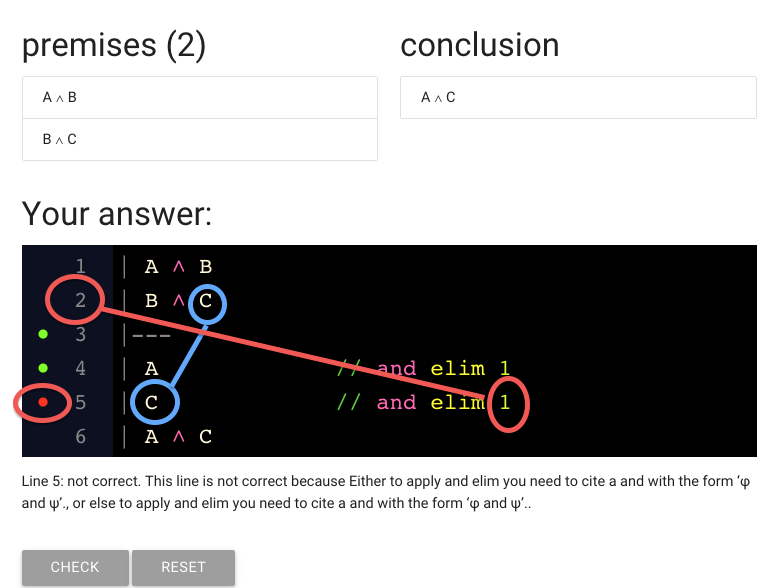
So we have to edit the line number.
(This kind of mistake tends to happen to me quite a bit because
I like to copy and paste justification to save typing)
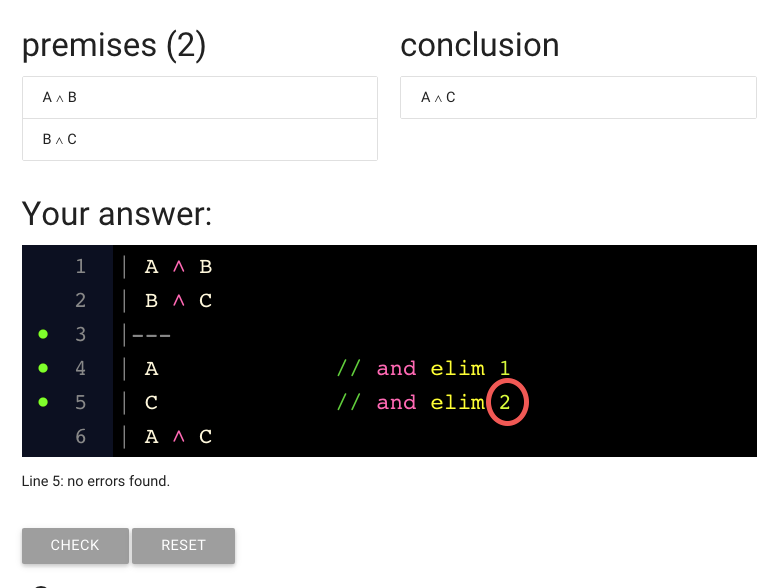
Here I’ve fixed the line number.

There’s a big whole where the justification for the last line should be.
(Remember that every line of the proof is either a premise or needs justification.)
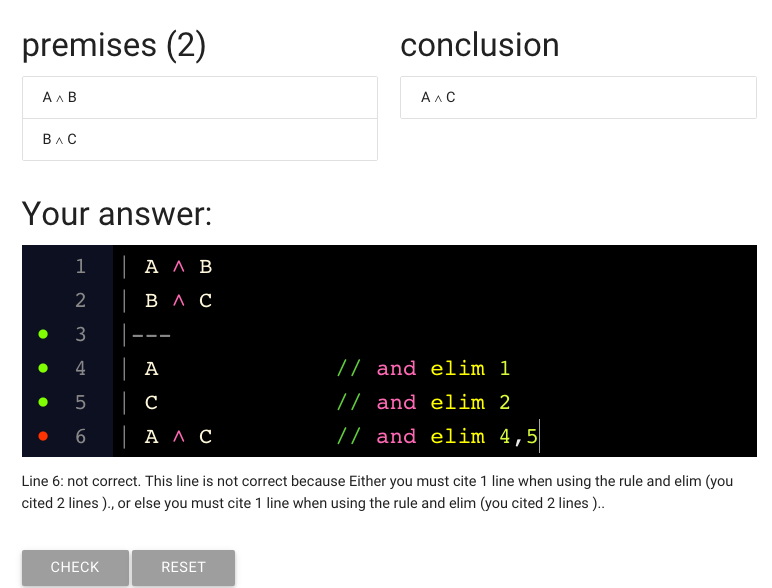
So I’ve gone ahead and added the justification.
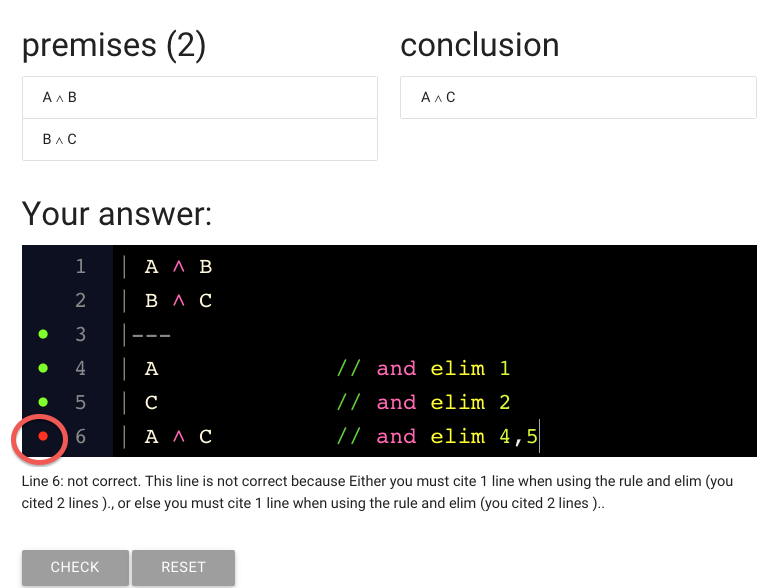
But it hasn’t worked: we’ve got the red dot again.
Unless you’re really good at logic, you’re going to be seeing a lot of the red dot
for a few weeks.
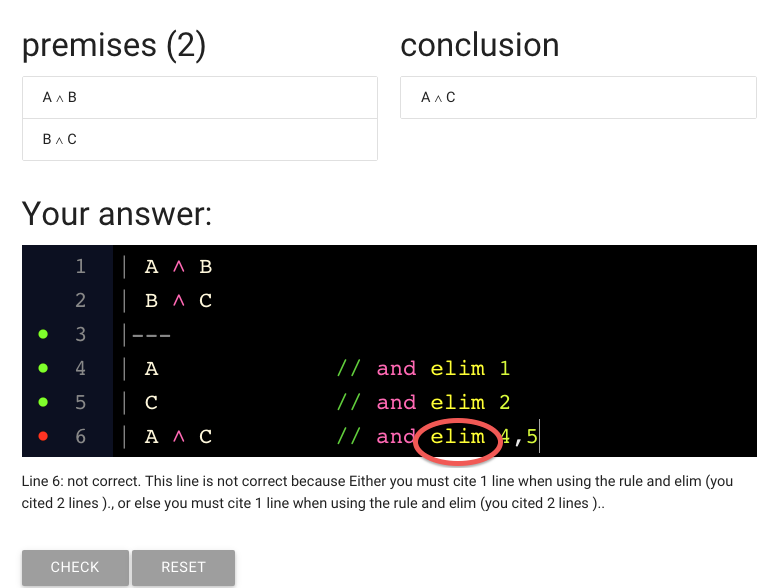
Here’s the mistake: we’re still citing and elim.
But at this point we’re supposed to be *introducing* a conjunction
rather than eliminating one.
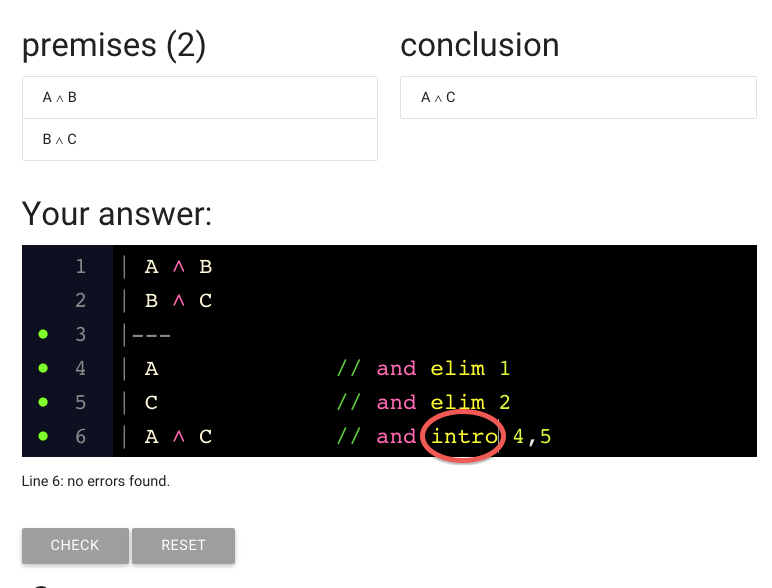
We can fix this just by deleting ‘elim’ and replacing it with ‘intro’
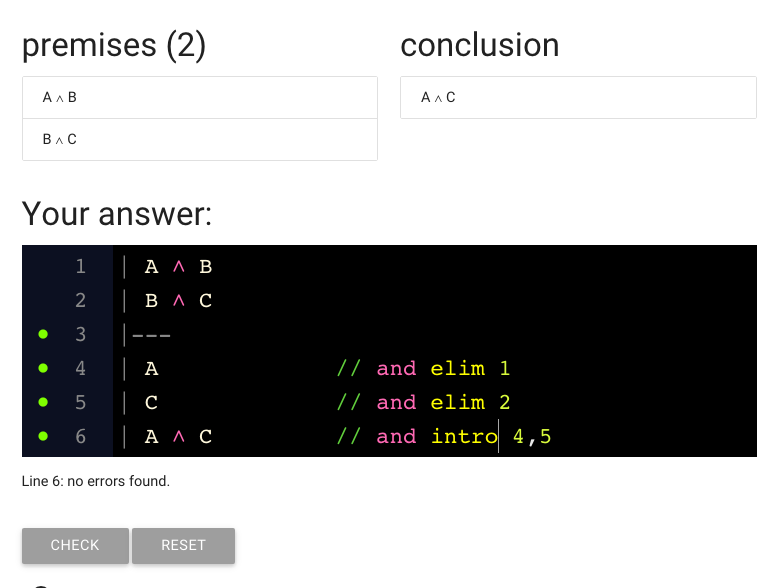
And here’s the finished proof.
This is correct; if you submit it, zoxiy should say your proof is correct.
6.1
5.3--5.6
\section{Symbols and Words}
When typing proofs or sentences, it’s often awkward to enter symbols.
In the first-order language awFOL, you can use words as well as symbols (they are
treated as equivalent). This makes typing easier.
And since zoxiy recognises awFOL, you can use the words in logic-ex.
Here’s a table listing the words you can use for each symbol.
| symbol | word(s) |
| ¬ | not |
| → | arrow, -> |
| ↔ | double_arrow, <-> |
| ⊥ | _|_, contra, contradiction |
| ∧ | and, & |
| ∨ | or, |, ǀǀ |
| ↓ | nor |
| ↑ | nand |
| ∀ | all, every |
| ∃ | some, exists |

A student emailed me about `... some confusion in regards to the ∨ symbol representing `or’ ...’
‘... some confusion in regards to the ∨ symbol representing ‘or’...’
I think the source of the confusion is this mistake.
It's a mistake to think that ∨ represents or!
Let me explain.
Here's the truth table for v ...
Oops, there's a mistake in this truth table. Let's fix it ...
Now we've got the right truth table.
The truth table is a stipulation about the meaning of v, the disjunction symbol.
We're not trying to capture the meaning of any English word.
The student goes on to ask this:
‘What makes the ∨ inclusive or exclusive, and is it always one of the two, or can it mean different things in different situations?’
It ‘is clearer with the example: ‘The pig went down the left fork or the right fork.’ Clearly this is a case where it can only be one or the other. The pig cannot go down both forks.’

Rules of Proof for Identity
\section{Rules of Proof for Identity}
\emph{Reading:} §2.2

Earlier I said to understand identity as logicians think about it, there are just two principles you need.
These principles correspond to the identity and elimitation rules for identity.
The first principle said that if b=c, then whatever is true of b is also true of c.
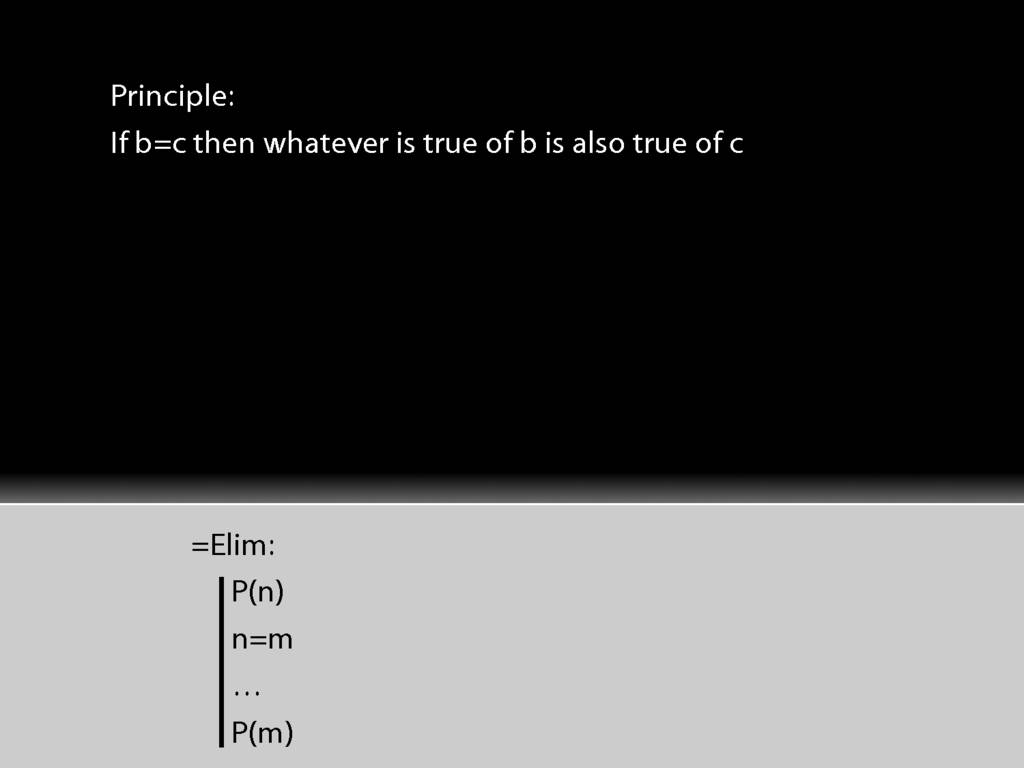
This principle is the rule =Elim.
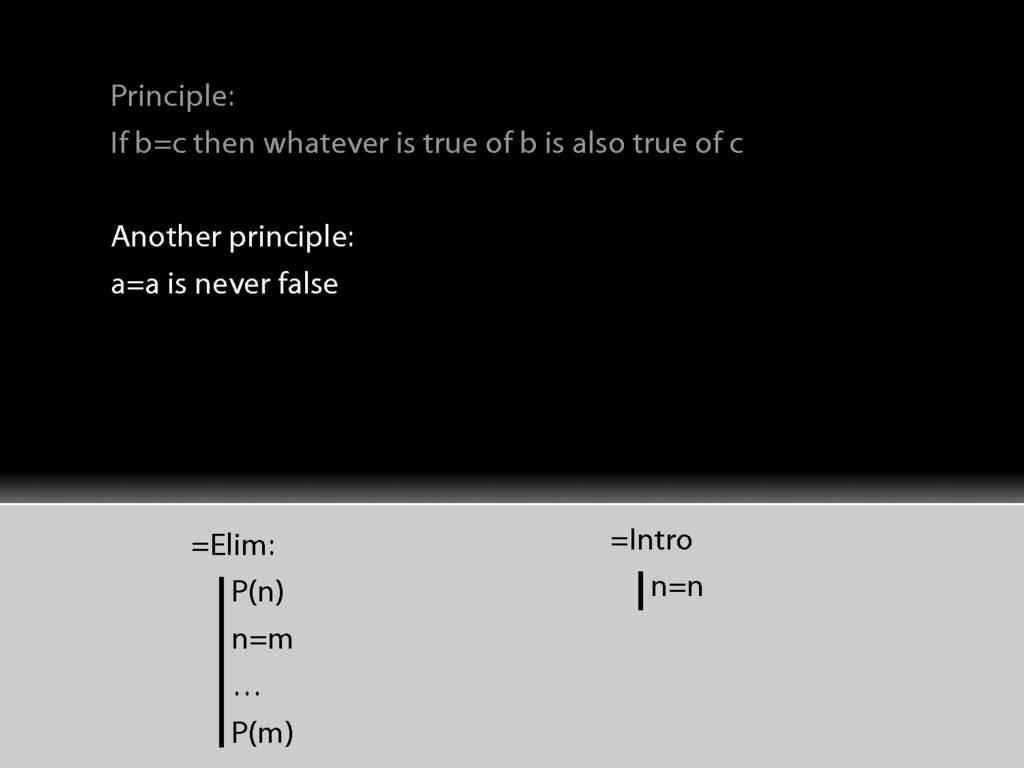
Then there was another principle, a=a is never false; this is the rule of proof =Intro.

The first rule of proof is expressed just as you would expect:
there are things you have to have already in your proof, and if you have them then you can extend the proof by adding this to it.
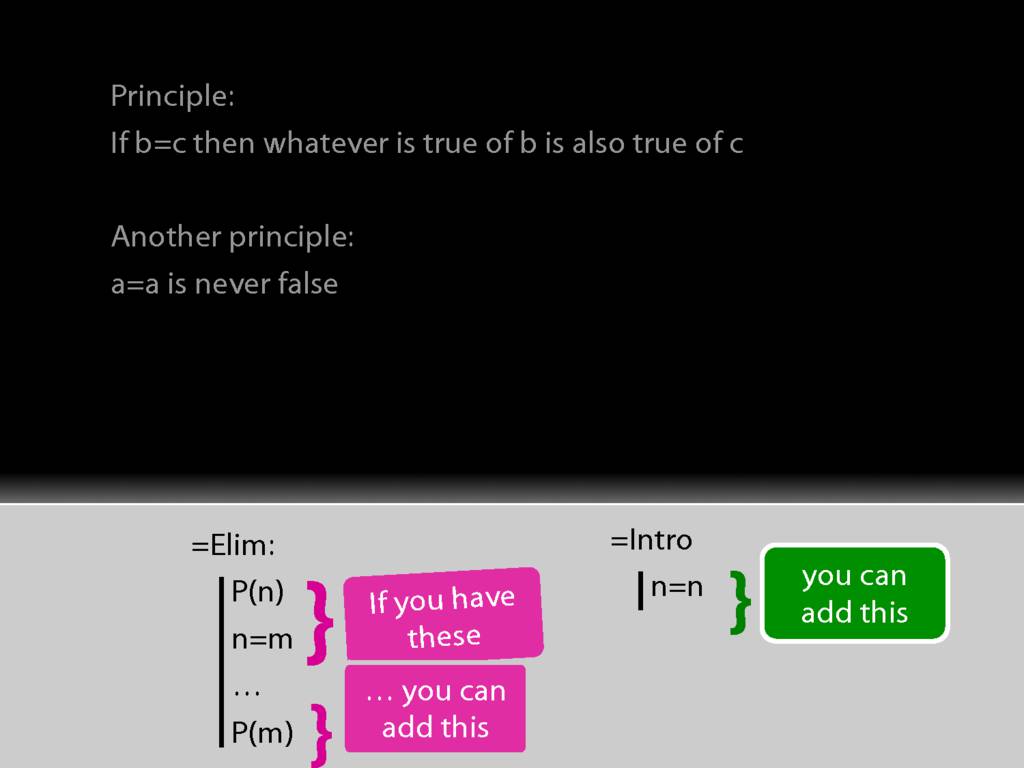
But identity intro is a bit different. In this case there are no pre-requisites.
You can use the rule regardless of what you have.
The rule says that any time you like you can add a sentence of this form, so a=a or b=b or whatever.
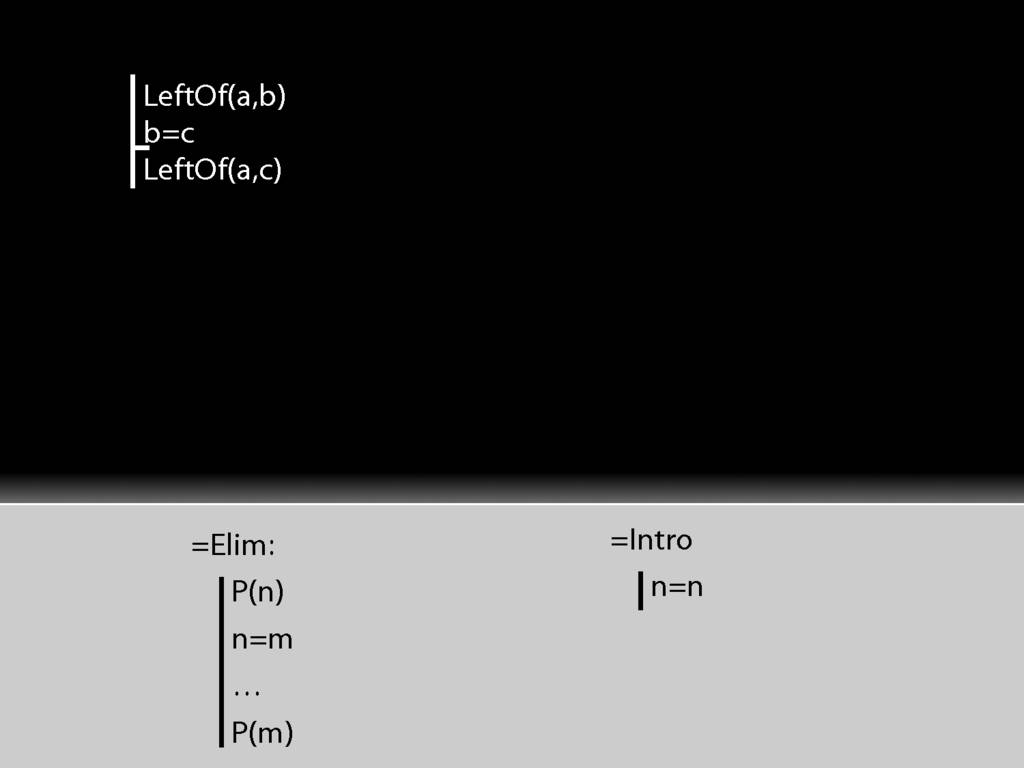
Let's see how these rules work with a simple proof.
(Everytime I show you new rules, I'll also show you an example of how they're used.)
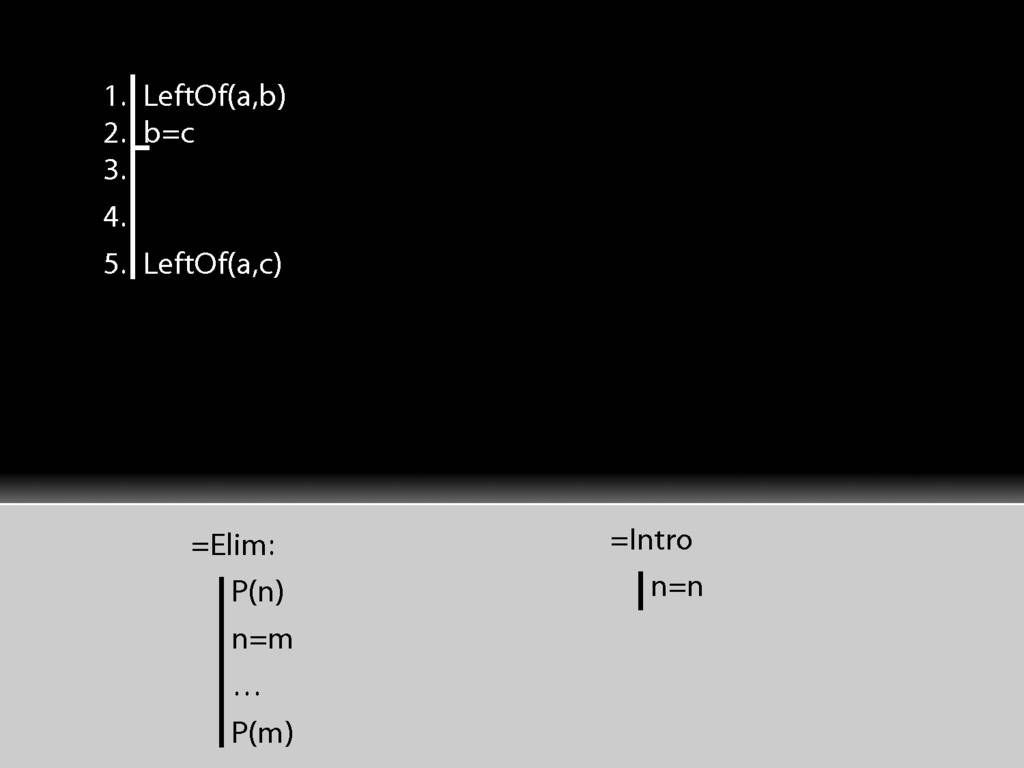
First I need some line numbers, and maybe a bit of space.
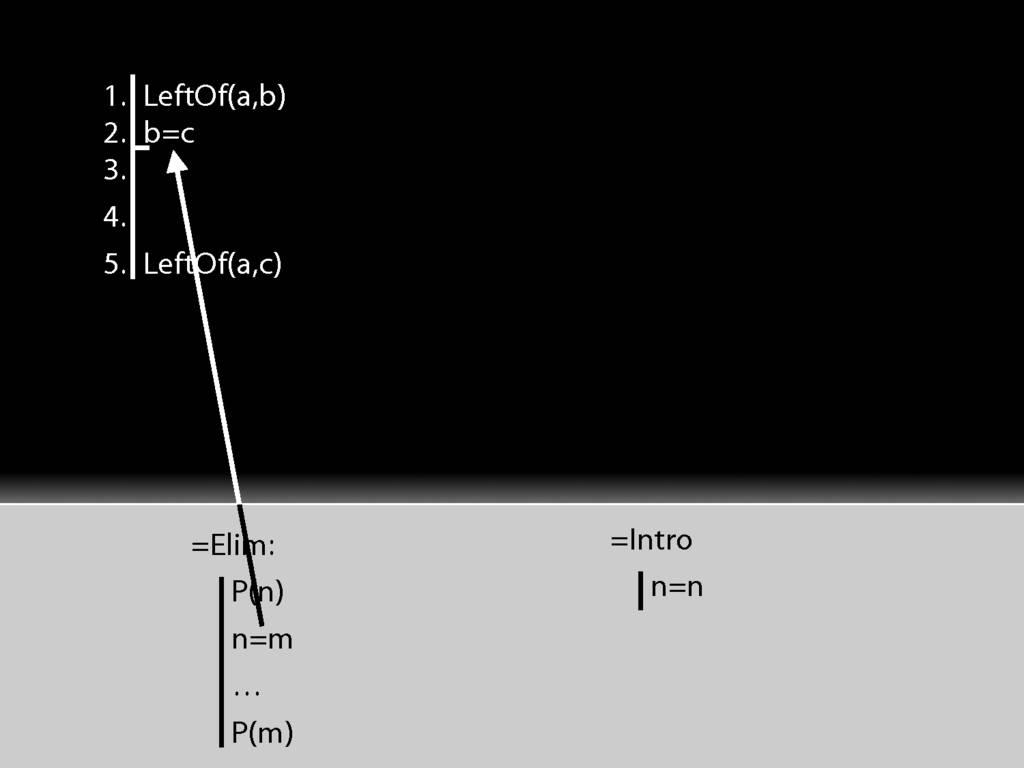
To apply =Elim I need an identity statement; and that's just what I have at line 2.
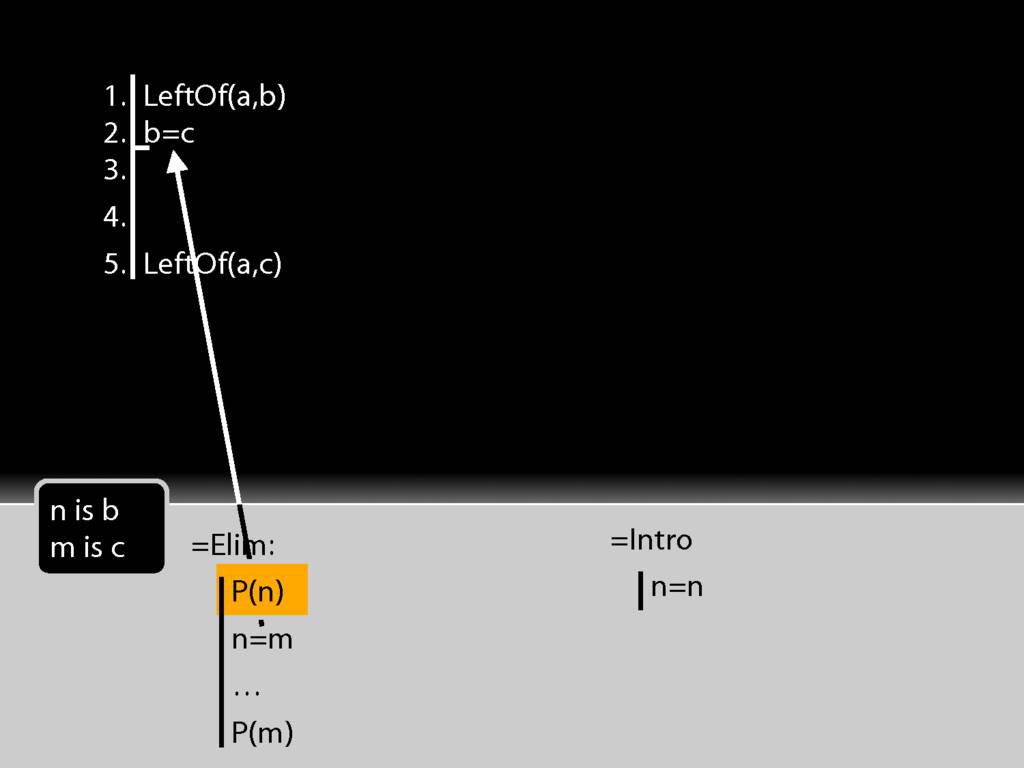
To apply =Elim I also need a statement about the thing named on the left hand side of the identity statement, in this case b.

That's just what I have at line 1 of the proof.
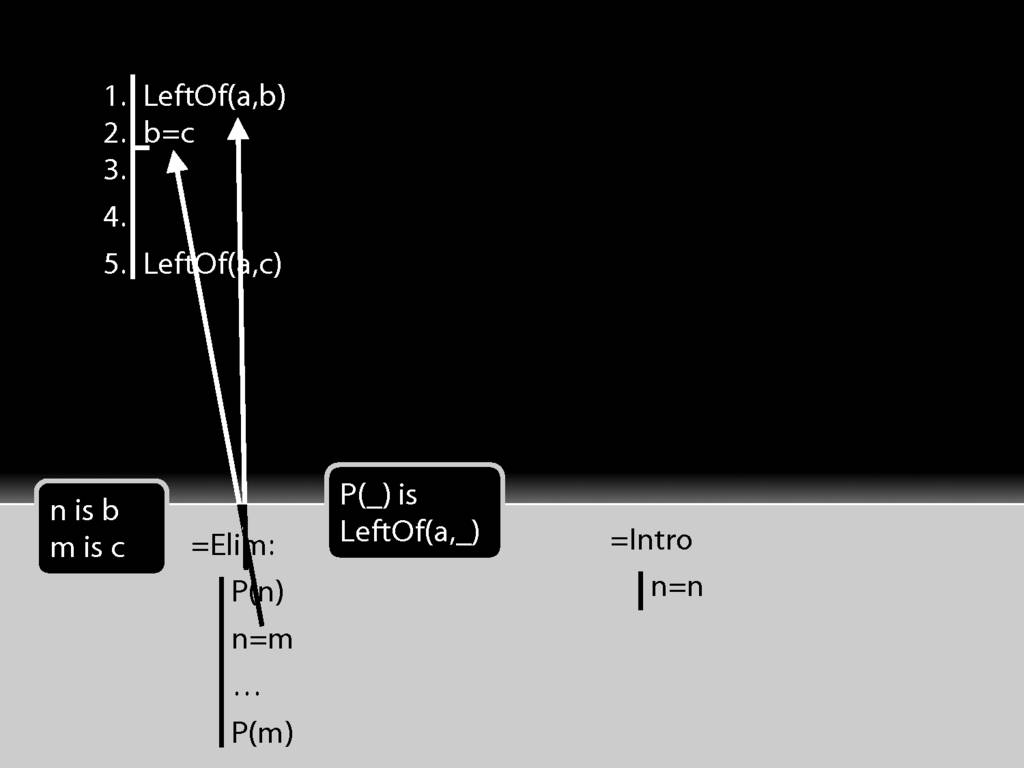
So actually I have both of the things I need to apply =Elim.
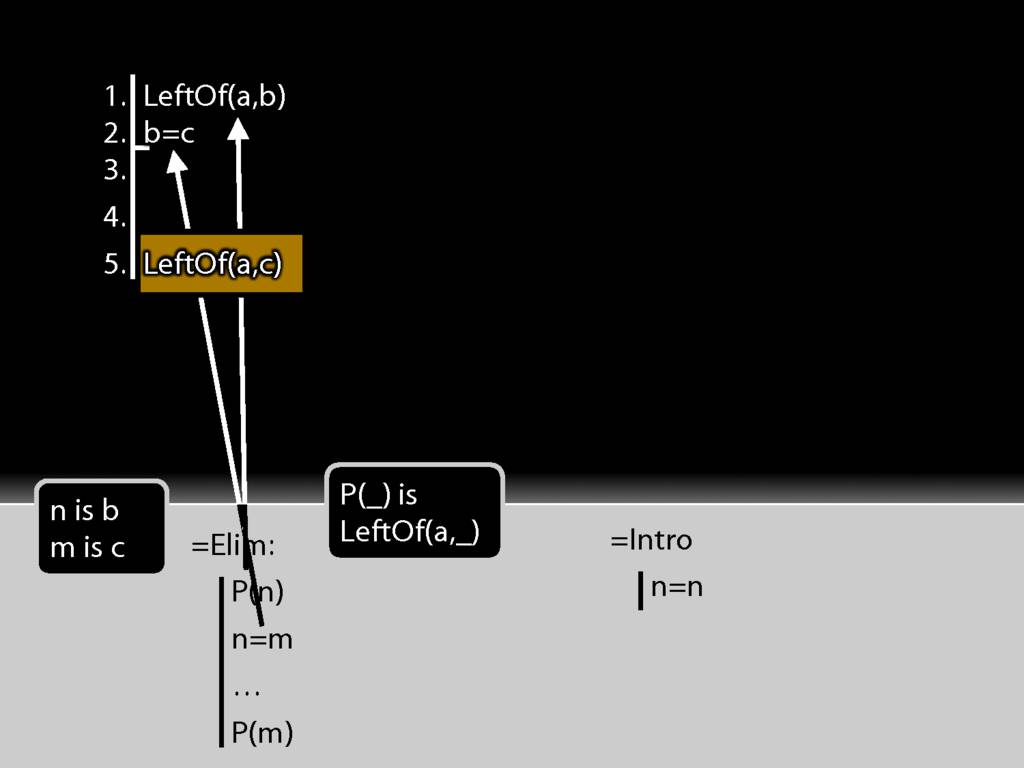
But now look at the conclusion of this argument.
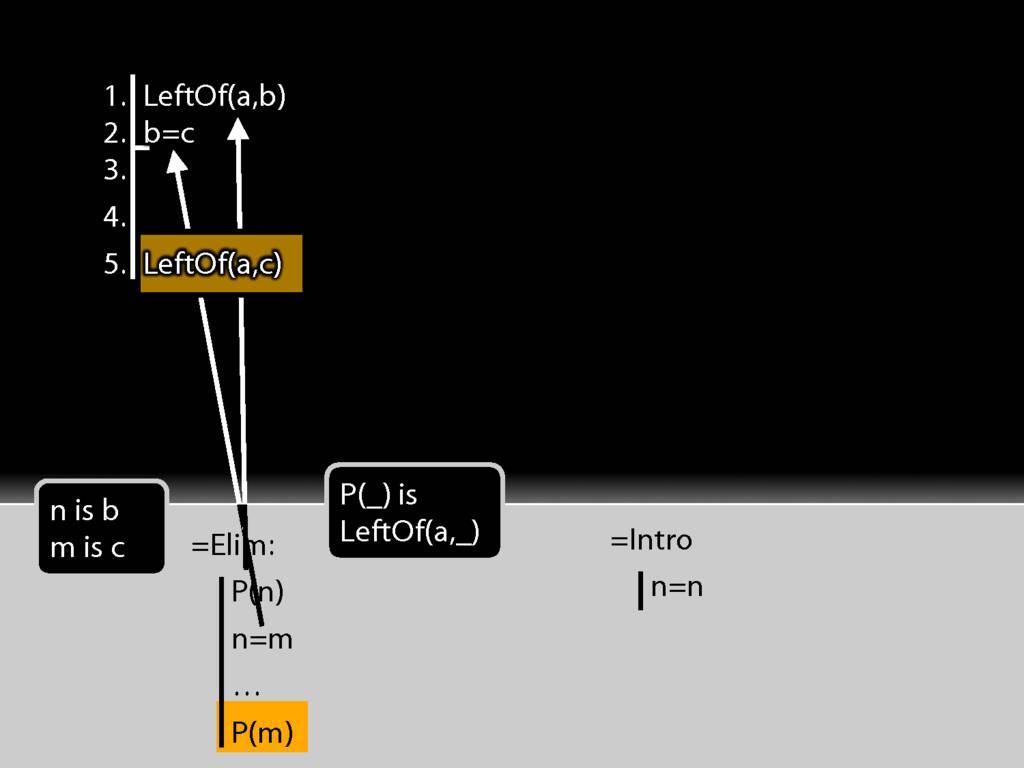
The conclusion is just what =Elim allows me to conclude.
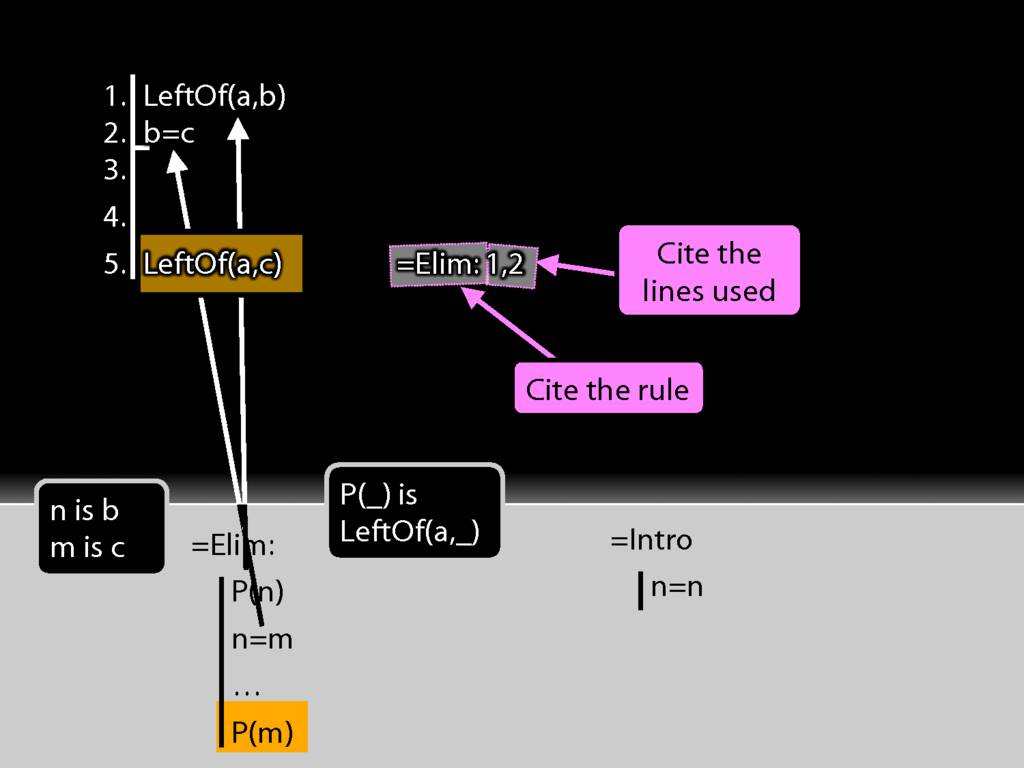
Have I finished the proof? Not yet. I need to justify the step, which involves two things: I need to cite the rule and to cite the lines I've used in applying it.
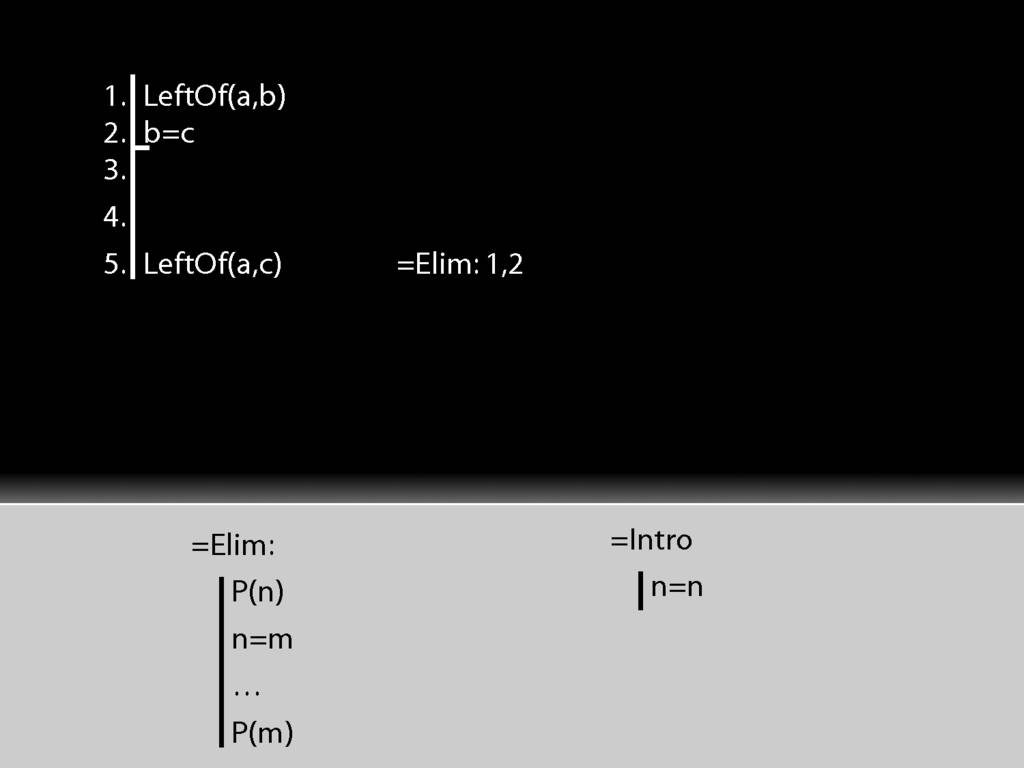
Let's look at the same thing a different way.
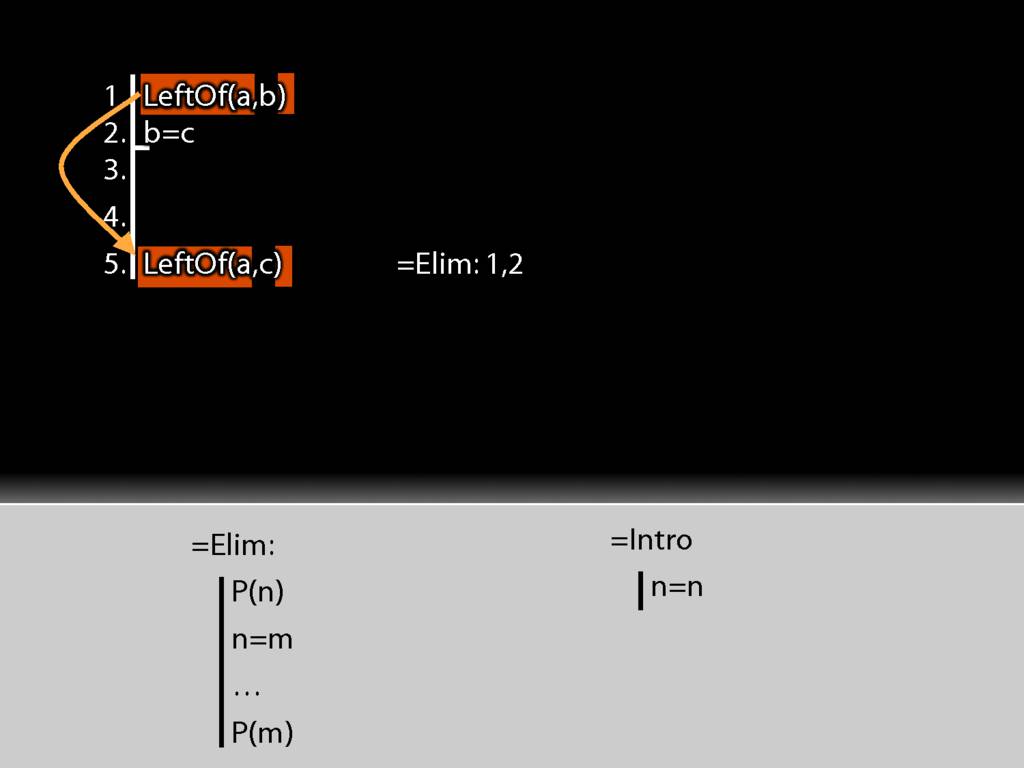
The first premise is a statement about b (it says a is left of it) whereas the conclusion is the same statement about c (it says that a is left of it).
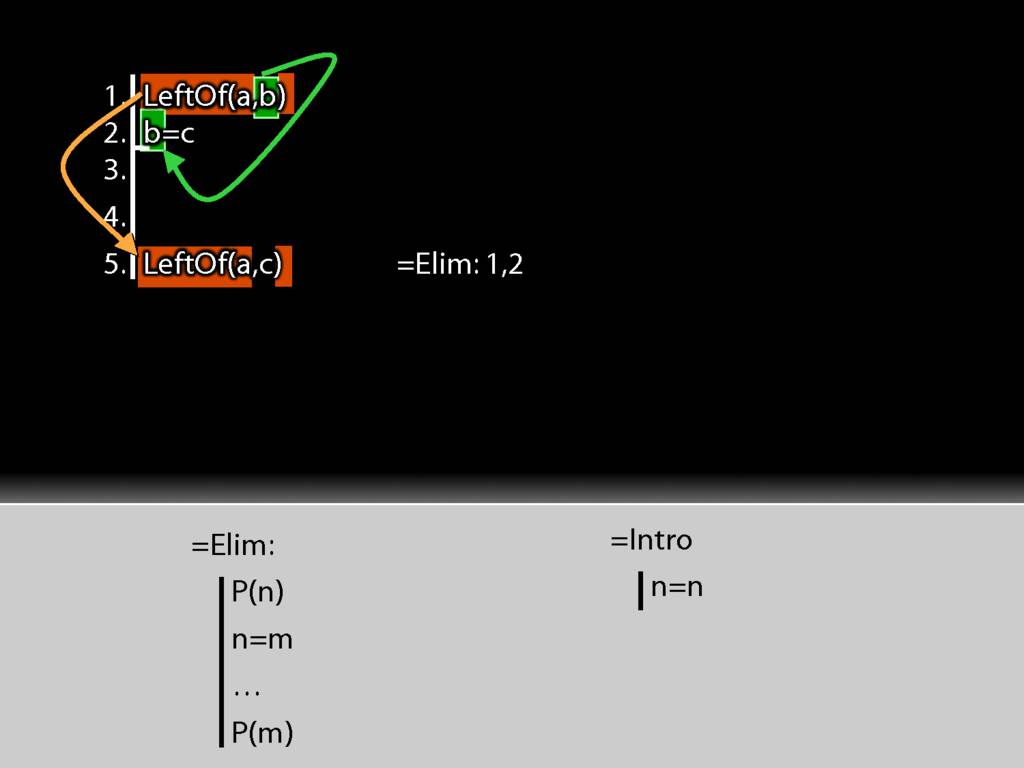
I take the b from the first premise and put it into the identity statement.
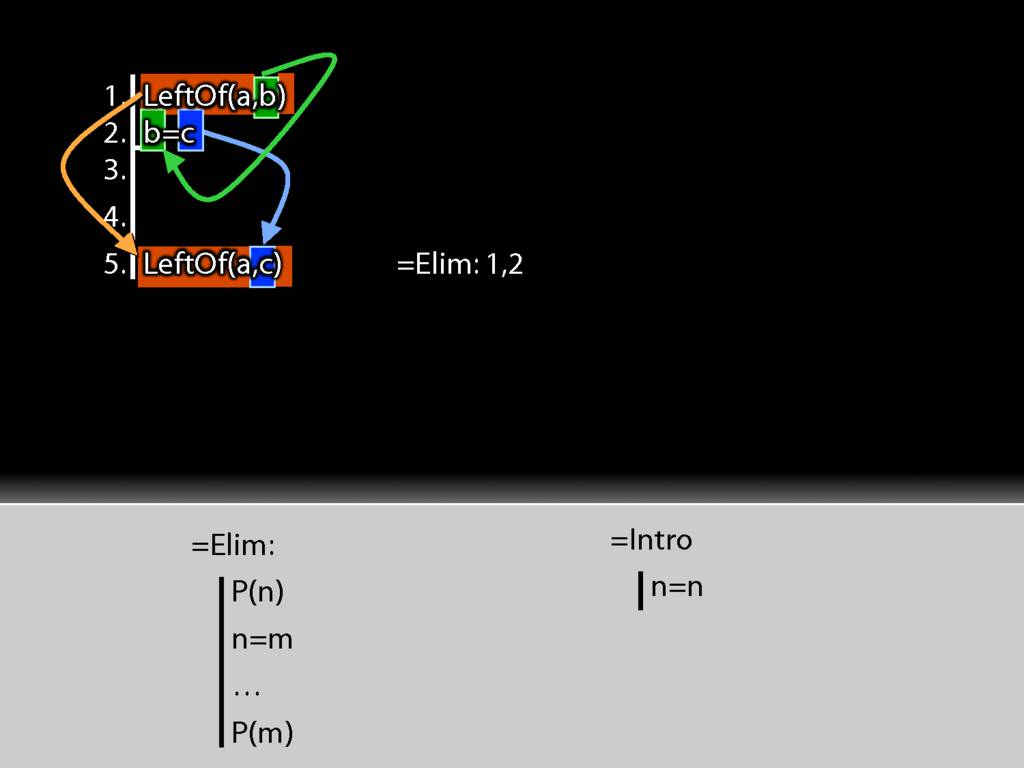
I move accross the identity statement from left to right and find c. And this c I put into the conclusion just where b was earlier.
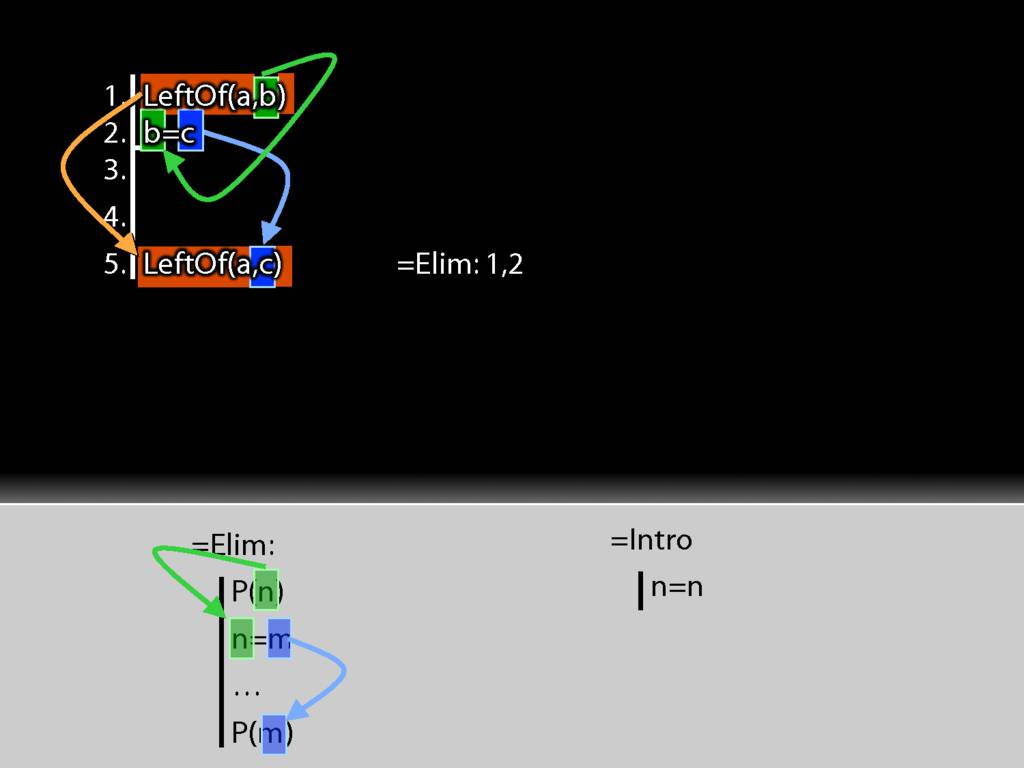
And this is just the pattern I need to make to use =Elim.
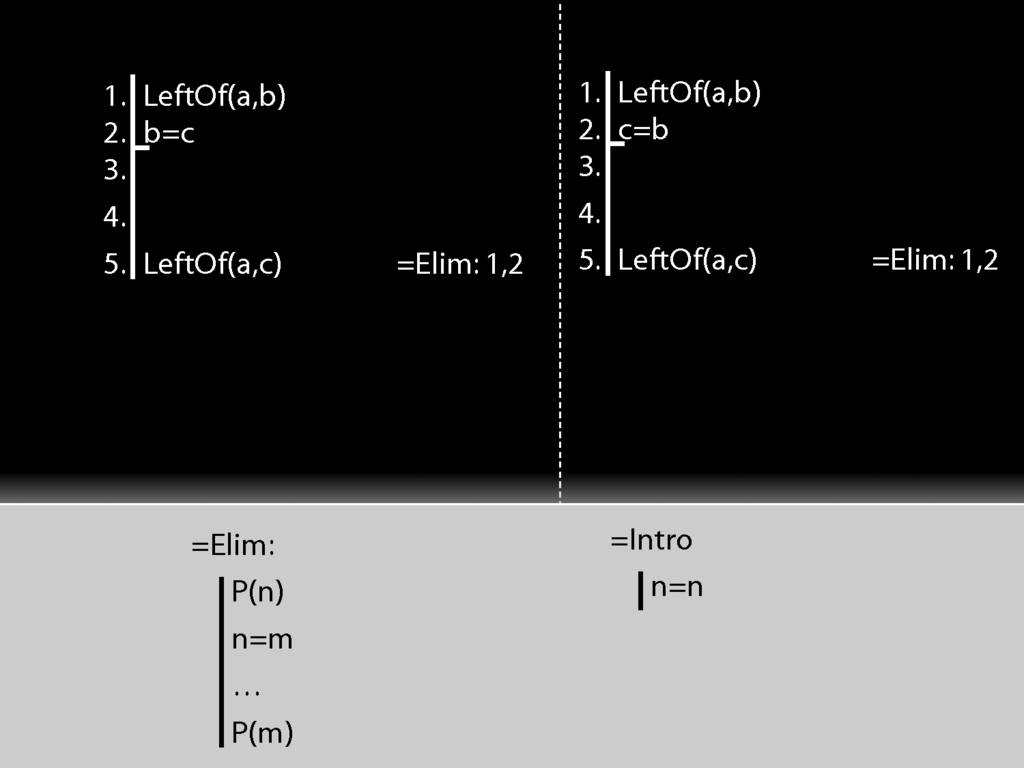
Look at this thing on your right. It looks much like a proof. But actually it's no more a proof than a toddler's scribble. Why not? (I'll return to this question later.)
\section{How to Write Proofs}
\section{Complex Truth Tables}
\emph{Reading:} §3.3, §3.5
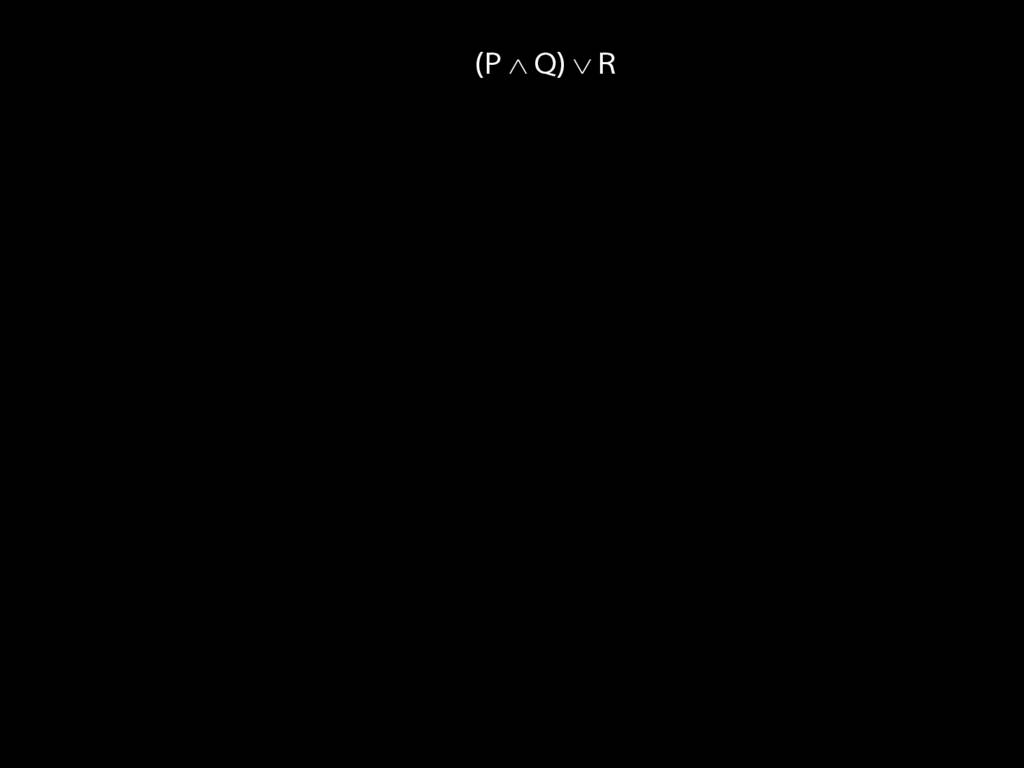
\begin{minipage}{\columnwidth}
Complex truth table example:
\end{minipage}
3.12, 3.13
4.4-4.7
4.12-14
3.14, 3.15

Logic Makes Me Die Inside
\section{Logic Makes Me Die Inside}
\emph{Reading:} §2.1

Can I logically valid argument have true premises and a false conclusion?
Let me put this another way ...
Do you use facebook? I’m not on it. I already have a friend, so it didn't seem necessary.
But I was very proud to learn (from a TA) that one year some of my students set up a facebook group for logic.
How cool is that? You love logic so much that you have a facebook group to celebrate.
I'm like the Burial of logic lecturers ...
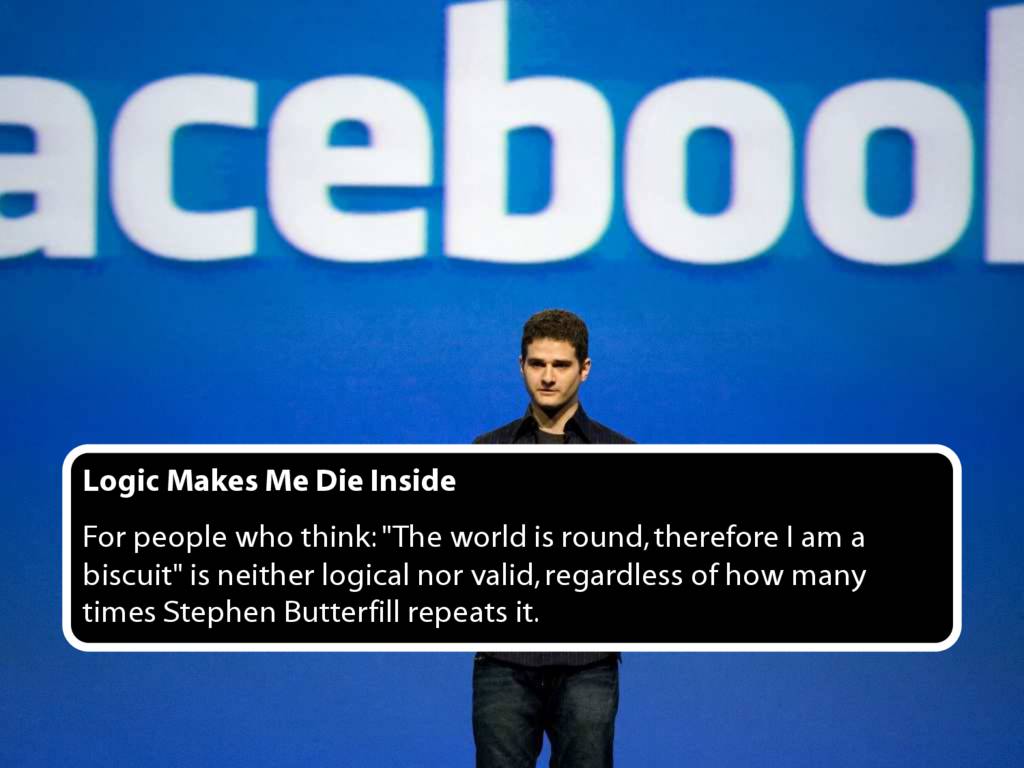
Or not.
But let's have a closer look at the argument.
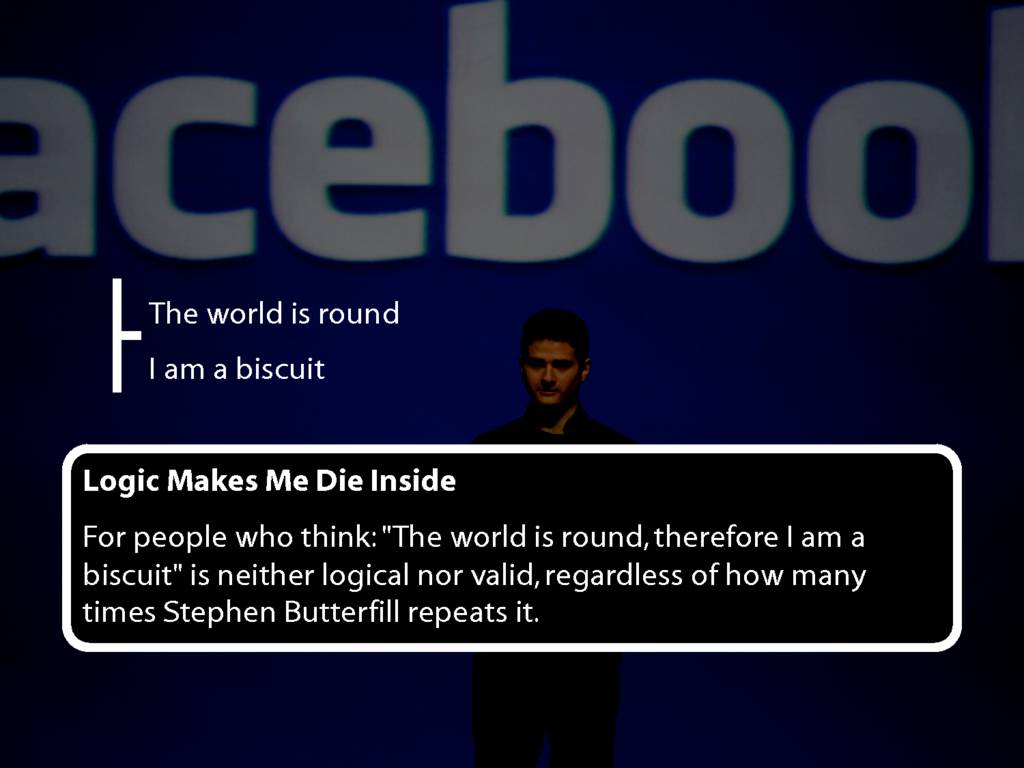
One premise, one conclusion.
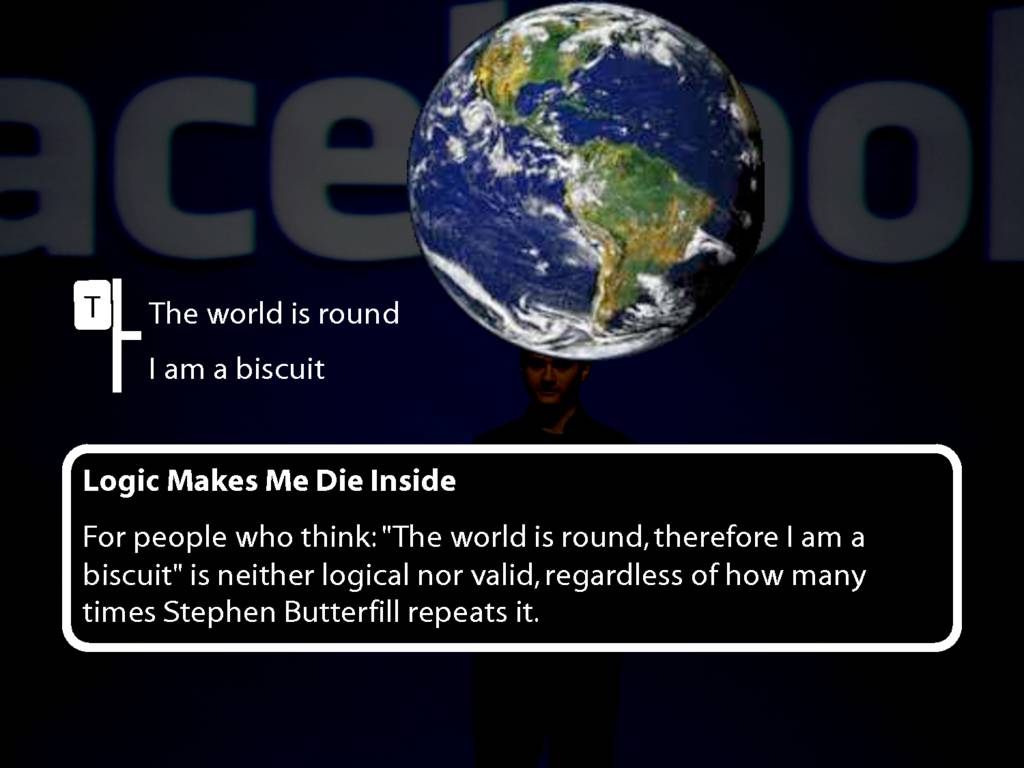
The funny thing about this argument is not just that there's a counterexample to it, ...
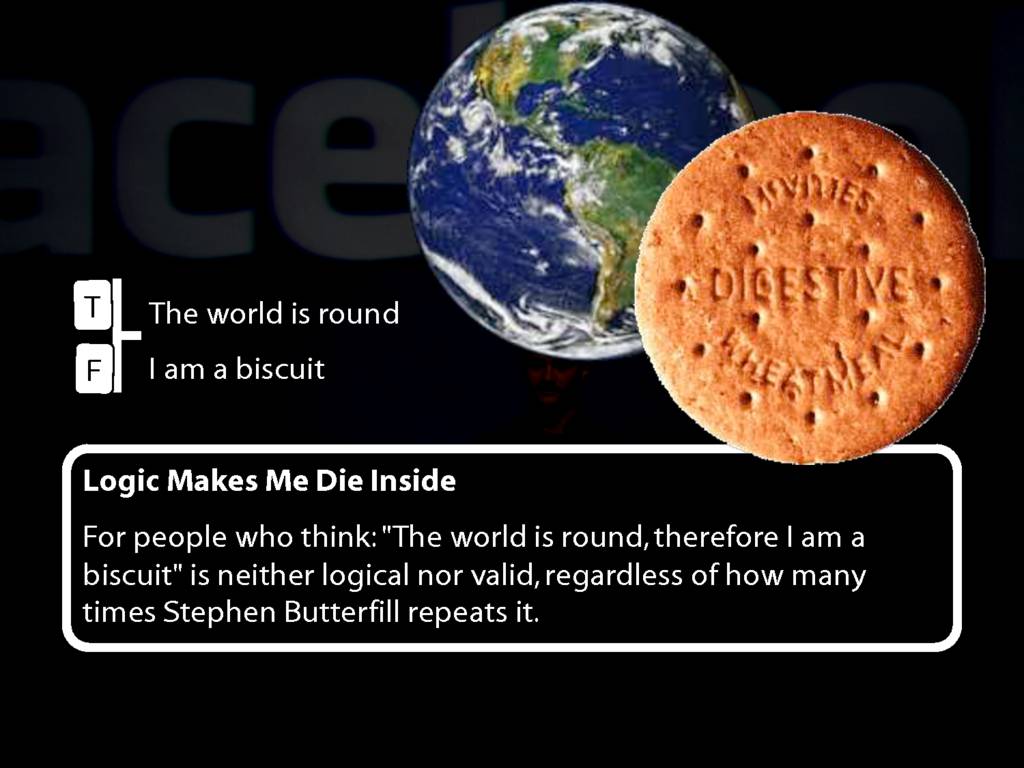
... but that the actual world is a counterexample to it.
So if you think about it, the facebook group was actually for people who love logic after all.
Earlier I asked, Can a logically valid argument have true premises and a false conclusion?
Please think about this question before writing about logic.
So what was logic making me die inside really about?
I think it was probably intended to be a response to the logical validity of two arguments, this one ...
... and this one.
If you are really good, you'll be able to prove both arguments by the end of the course.
In fact, you could prove the argument on your left by the end of today.
In fact, let's see how to do that right away (in unit 270).
\section{Contradictions, Logical Truths and Logical Validity}
\emph{Reading:} §4.1, §4.2, §5.4

P $\lor{}$ ¬P is a \emph{logical truth}
logical truth defined p. 568
P $\land{}$ ¬P is a \emph{contradiction}
contradiction defined p. 564
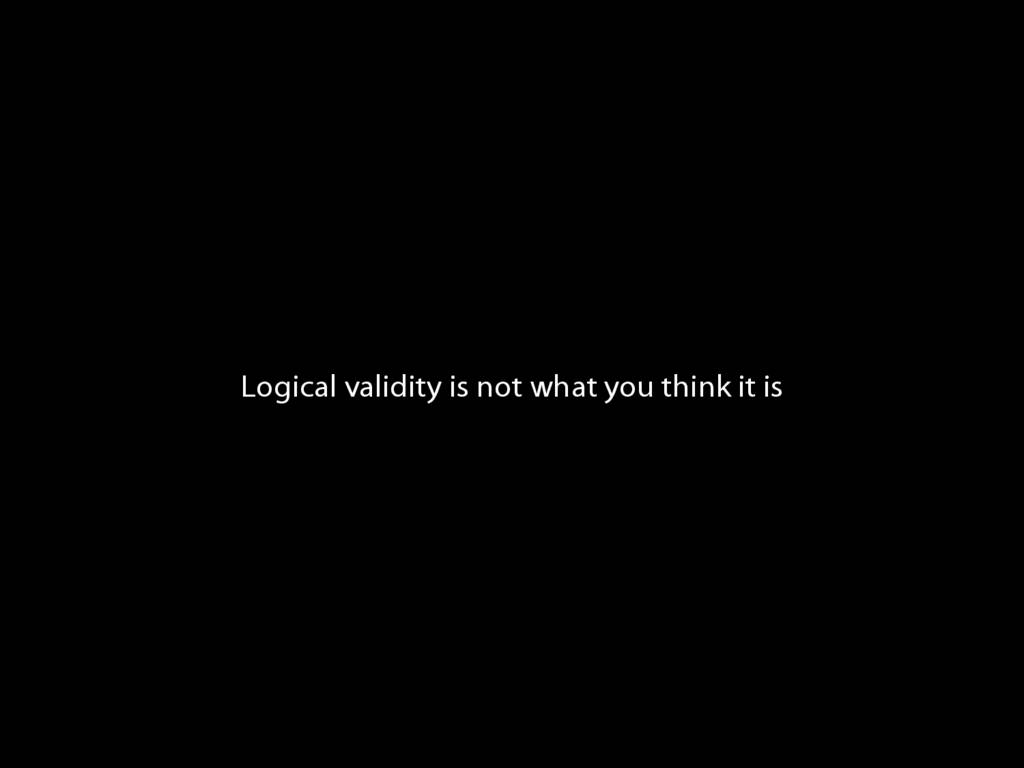
Unlike say knowledge or truth, where it’s up to you to form a view of your own to a large extent, with logical validity there is a precise and clear definition that we are working with. Of course there are still questions about the nature of logical validity, but to get to those questions you first have to accept its definition.
4.1, 4.2
4.1, 4.2
4.12--4.16

